Warcraft Retrospective 28: All In
Previously on Warcraft 3: Reign of Chaos…
Bravely bold Tyrande rode forth from Ashenvale.
She was not afraid to die, o brave Tyrande!
She was not at all afraid of the humans and the orcs,
Brave, brave, brave, brave Tyrande!
But the moment she killed the paladin who kept the two races working together despite their tensions, the Burning Legion launched an invasion into night elf lands. And the Sentinel Army, badass warrior women with ten thousand years of training and strategizing, whose very raison d’être was to prepare for the inevitable return of the Legion, had no viable answer other than retreat.
Brave Tyrande ran away.
Bravely ran away, away!
When Burning Legion reared its head,
She bravely turned her tail and fled.
Yes, brave Tyrande turned about
And gallantly she chickened out.
Bravely taking to her feet,
She beat a very brave retreat,
Bravest of the brave, Tyrande!
Okay, I’m not being entirely fair here. For one, Cenarius, who could go one on one against the strongest demon lords, is dead, and lack of his support crippled the Sentinels. Of course, Even granting that, the Sentinels lost to a single orc clan without Cenarius, and even though he easily gave them a beating once he appeared on the battlefield himself, he fell to the same orcs gorged on demon blood — not even to full demons. I’m not sure he’d have made that much of a difference, had he survived.
And without Cenarius, Tyrande’s crowning solo achievement so far was killing a reasonable authority figure who likely would have just left her alone or even allied with the night elves, had she asked nicely. Her rashness and prejudice are, after all, very much intended character flaws.
Now that Furion has awakened, though, the night elves’ fortunes will begin to turn. He will now lead a quest to awaken the other druids, but before we get to that, let’s review…
The Invasion Stratagems of the Burning Legion
The Burning Legion is a refreshing change from the usual evil legions of doom seen in stock fantasy, in that they’re smart.
As GiantCrabGames mentions in his “Warcraft 3: Campaign Masterpiece or Overrated?” video, the Burning Legion has destroyed countless worlds prior to this one, and they have their invasions figured out down to a science, letting the inhabitants of the world do most of the work for them without needlessly wasting their own forces. Their strategy involves three steps.
- Find promising individuals whom they can seduce with dreams of power. On Draenor, that was Gul’dan; in Lordaeron, Kel’Thuzad and Arthas; and in Kalimdor, Grom Hellscream.
- Use their chosen proxies to sow chaos among the defenders of the world who could otherwise oppose a full-scale Legion invasion. By this point, at least four of the kingdoms of the Alliance (Lordaeron, Dalaran, Alterac, and Quel’Thalas) are in ruins, and the rest are still recovering from the Second War.
- Use the generated chaos to eliminate important individuals who could organize a successful resistance, such as King Terenas, Archmage Antonidas, and Cenarius.
The Legion has had setbacks, but mostly, so far, we’ve only had some successes against their proxies, and whenever the demons themselves appear on screen, they generally succeed at their goals. This helps preserve them as a viable and menacing threat until the final confrontation.
And against a foe that saps the defenders’ strength by pitting the nations of the world against each other, the only way to have even a chance of repelling them is to unite everyone, literally everyone, and hope no one will stab you in the back.
Warcraft 3 has set a high bar for the franchise. If future villain factions are to be seen as a credible threat, they will need to be portrayed as at least this smart.
The Druids Arise
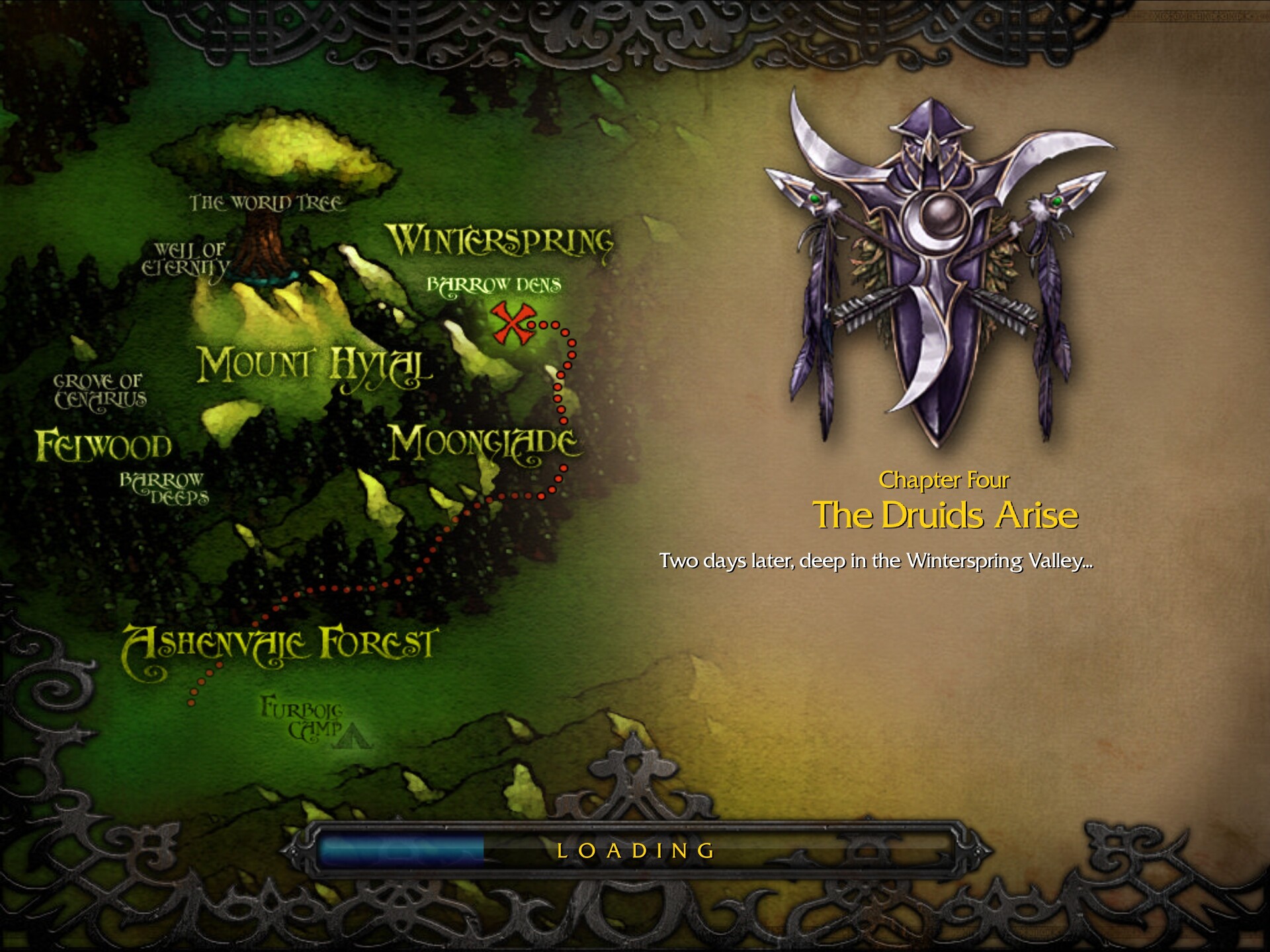
Two days after Furion awakened, he finally decides to tell Tyrande how he felt in the thousand years since they were separated.
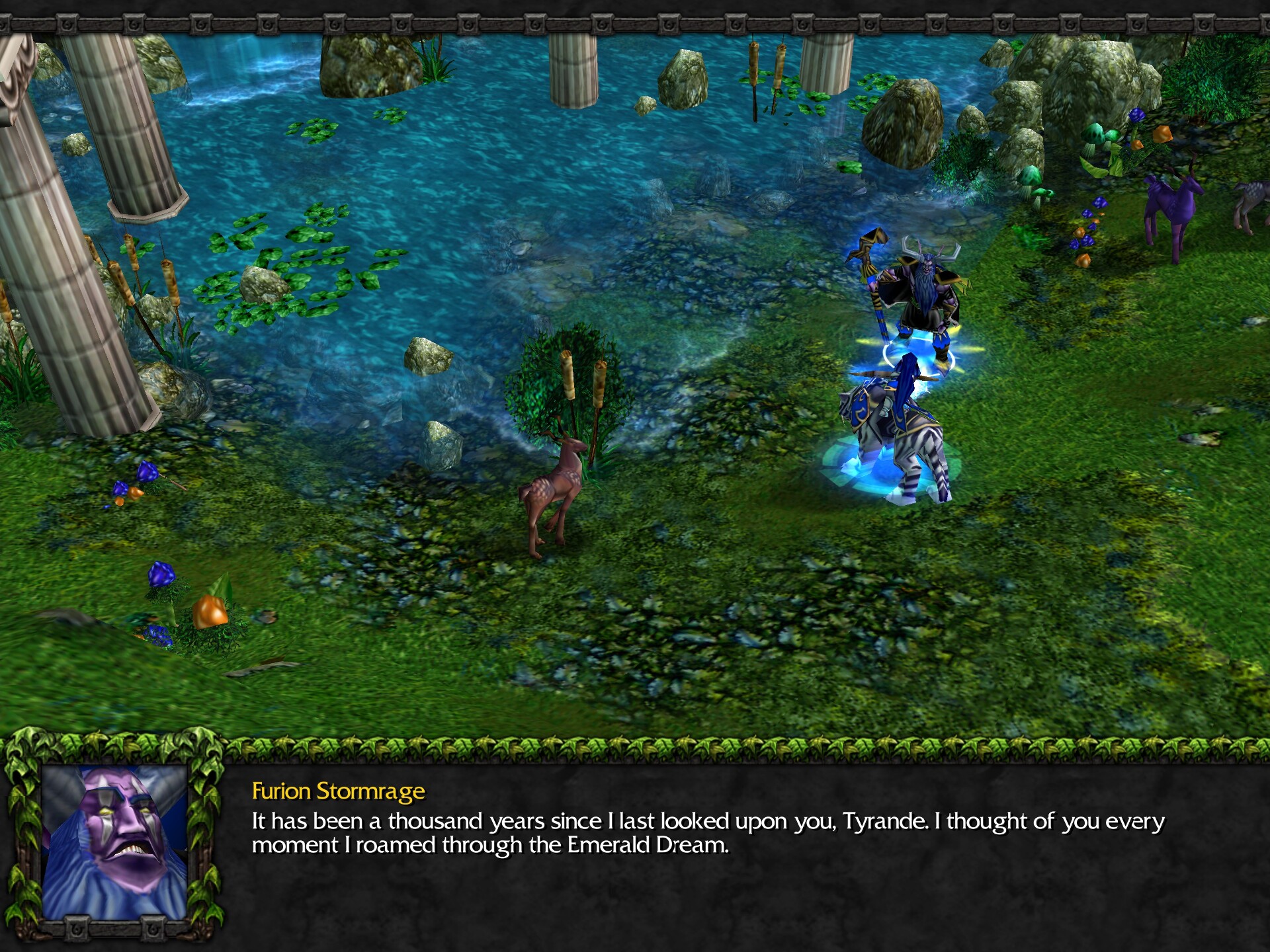
People familiar with Winterspring in World of Warcraft might be surprised at its depiction in Warcraft 3 as a summer location not different from Ashenvale, though admittedly we can assume from this that Winterspring follows the normal cycle of seasons instead of being a land of everlasting winter. Apparently this bugged someone on the Reforged team too, because between patch 1.33 and patch 1.36.1, the Reforged version of this mission used a winter tileset instead of the Ashenvale tileset. I made the below screenshot during patch 1.33, and now, with the changes reverted, the only way to make it is by playing the right version offline.1
Reforged giveth and Reforged taketh away. Again.

Anyway, it turns out the two are lovers. Furion finally reveals what the Legion’s final goal is:
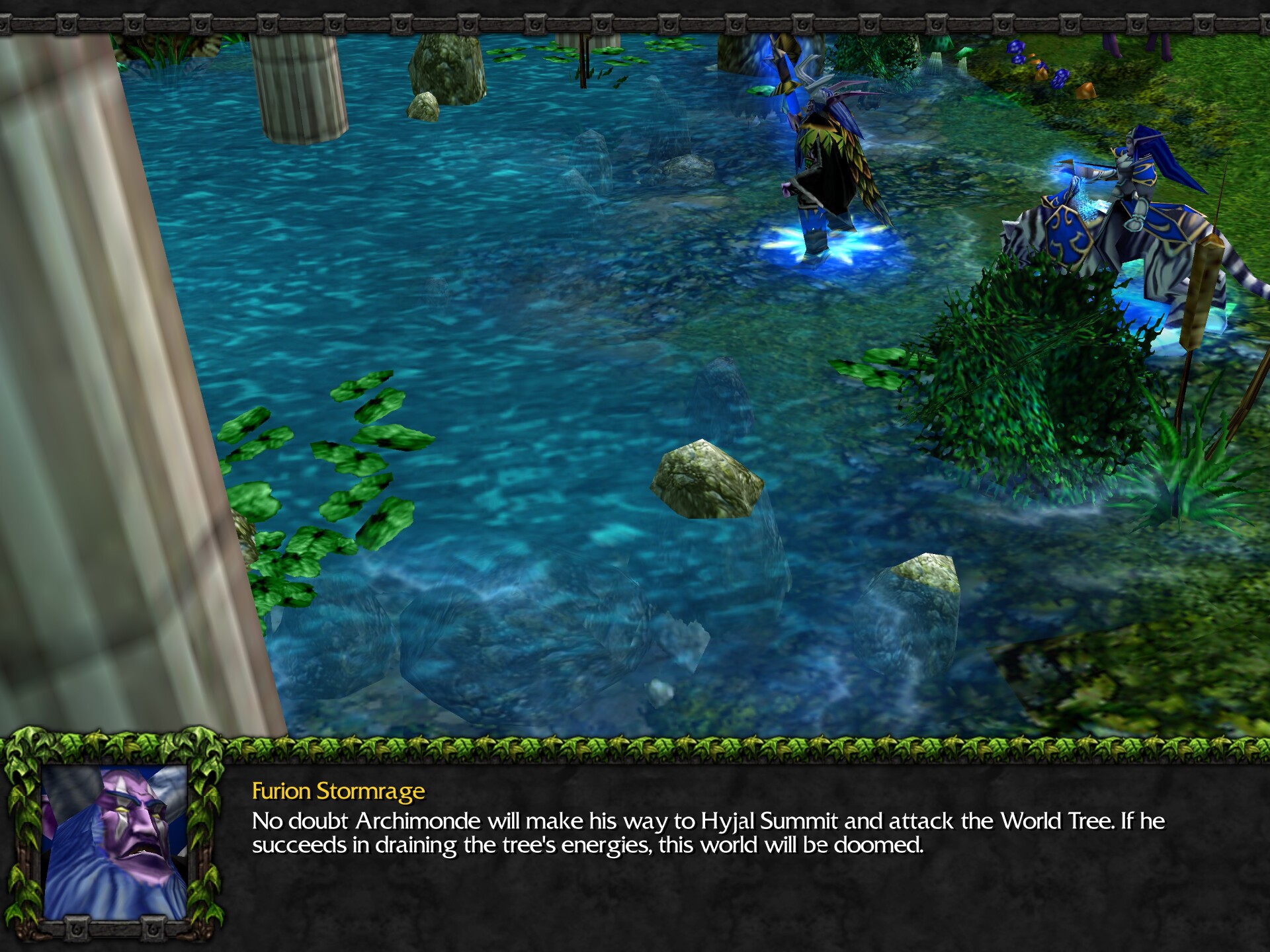
Right now, the immediate plan is to reach the barrow dens at the end of the valley and awaken the druids of the talon, who will be valuable allies against the demons. They come upon humans fighting undead, and Furion thinks they might be powerful allies too, but Tyrande shuts him down.
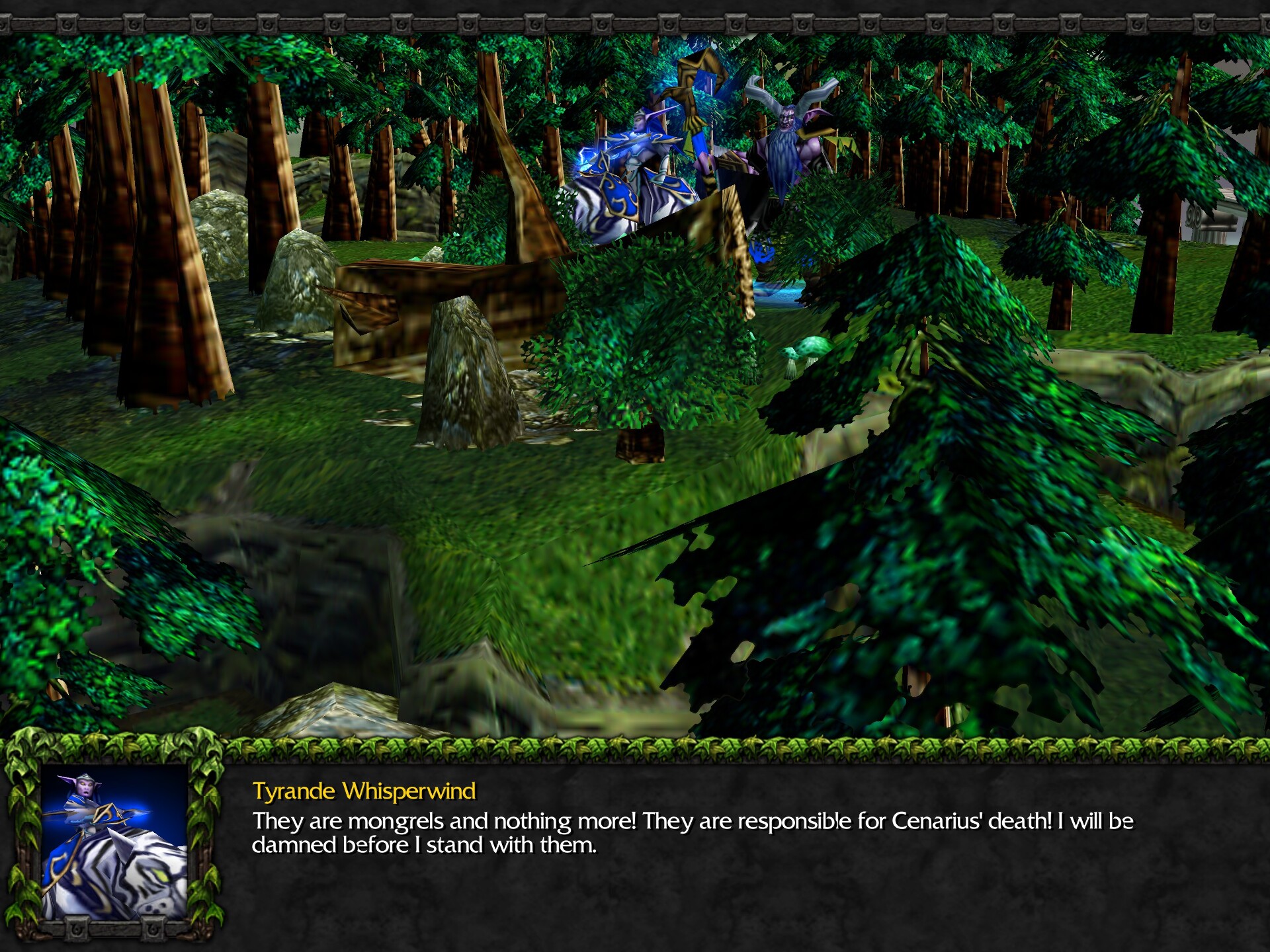
“Perhaps you are right, my love,” says Furion, and that’s the end of that, for now. The mission begins, and… all our tree buildings are uprooted?
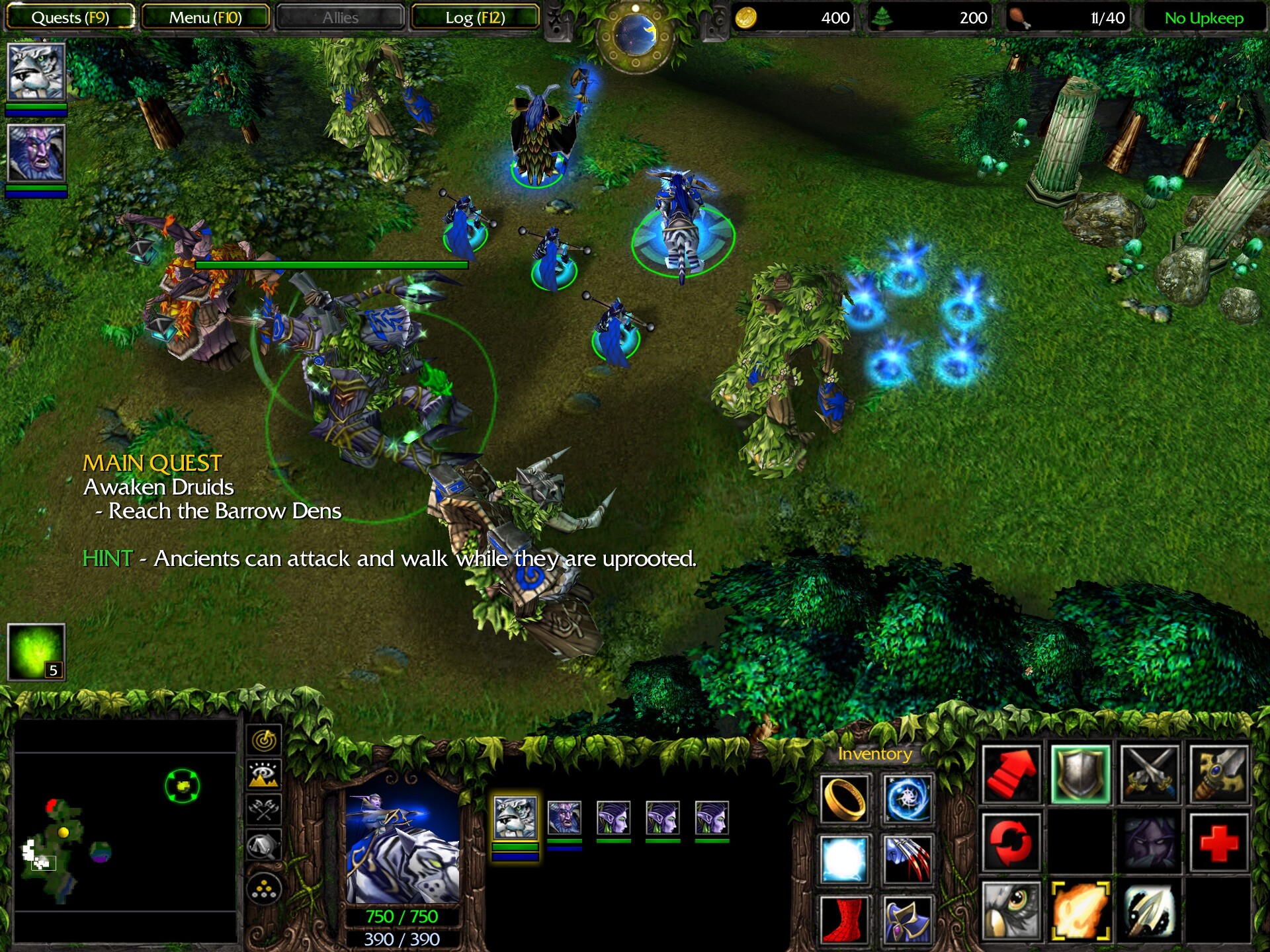
Welcome to one of the longest missions in the game! And it’s great.
This is like one of those Starcraft 2 missions where Raynor will ask “What’s the catch?” and someone will explain the gimmick mechanic that the entire mission is built around, except nobody explains it here — you discover it on your own. The catch here is that all the gold mines in this mission contain very little gold, so we have to take advantage of our ability to constantly relocate our base from mine to mine, harvesting what we can before moving on.
We get Furion as our second hero. Gameplay-wise, he is a Keeper of the Grove. At this point, his active abilities are Entangling Roots, which temporarily traps an enemy unit in place, and Force of Nature, which animates nearby trees into treants to fight for us.2 Like Thrall’s wolves, treants are perfect as disposable frontliners and scouts. (Admittedly it’s a bit ironic that the night elf faction has so many ways to destroy trees.)
One of Furion’s item slots is permanently occupied by the Horn of Cenarius. Like the Urn of King Terenas in the undead campaign, it’s a plot item and cannot be dropped. Unlike the undead campaign, however, someone got the memo that simply carrying an item useless in gameplay was unsatisfying, so the Horn is actually a pretty useful item, giving Furion hefty bonuses to HP maximum and HP regeneration.
We root our trees at the first mine just ahead, put the wisps to gather gold, and go out exploring–
Our sacred grove is being desecrated!
Oops, did I mention that you’re traveling in the middle of total chaos?
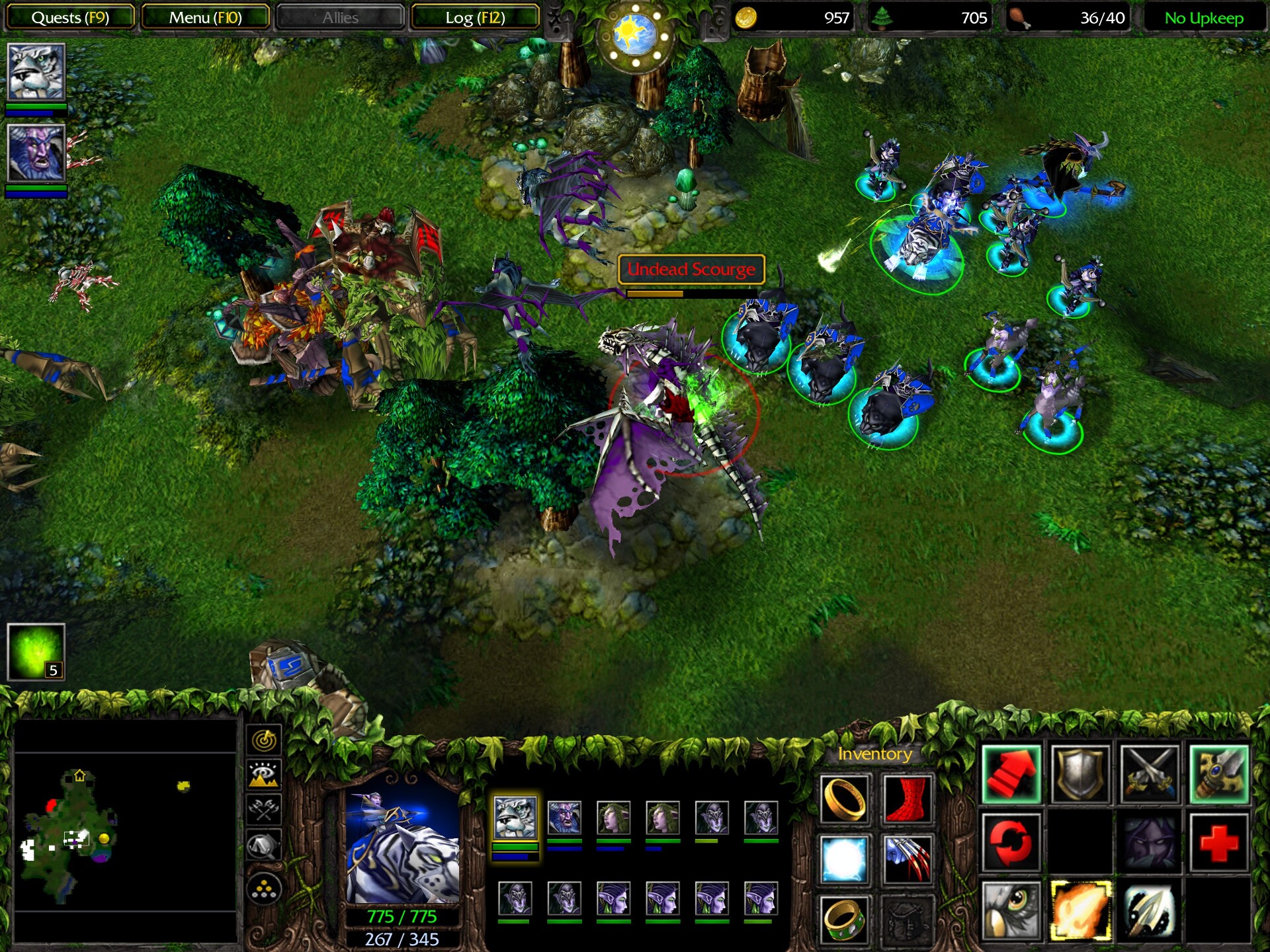
The orcs and undead are having skirmishes over the map, and you get periodically caught in the crossfire. I strategically placed my ancient protectors and an extra wisp to repair them, making sure that my army won’t have to come back to defend the base. Too often, anyway.
Soon, Tyrande and Furion come across a defiled fountain of life.
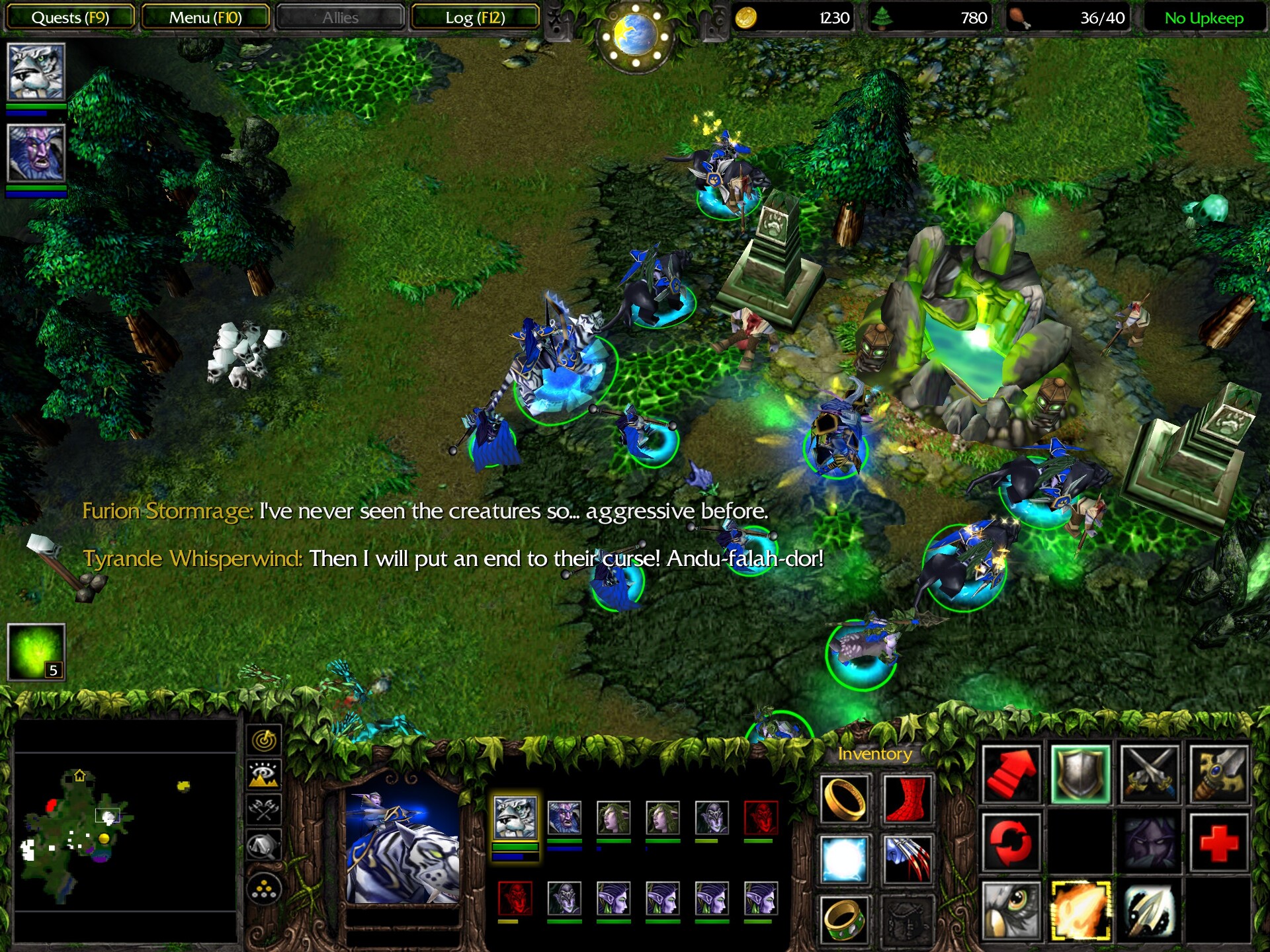
Turns out the furbolgs who fled back in the first mission didn’t escape corruption after all. Instead of even discussing the possibility of finding a cure, Tyrande immediately jumps to the conclusion that they must be eradicated, and since the writers have apparently forgot that this is supposed to immediately paint the character as evil, we merrily go ahead, slaughtering the entire tribe for a side quest.
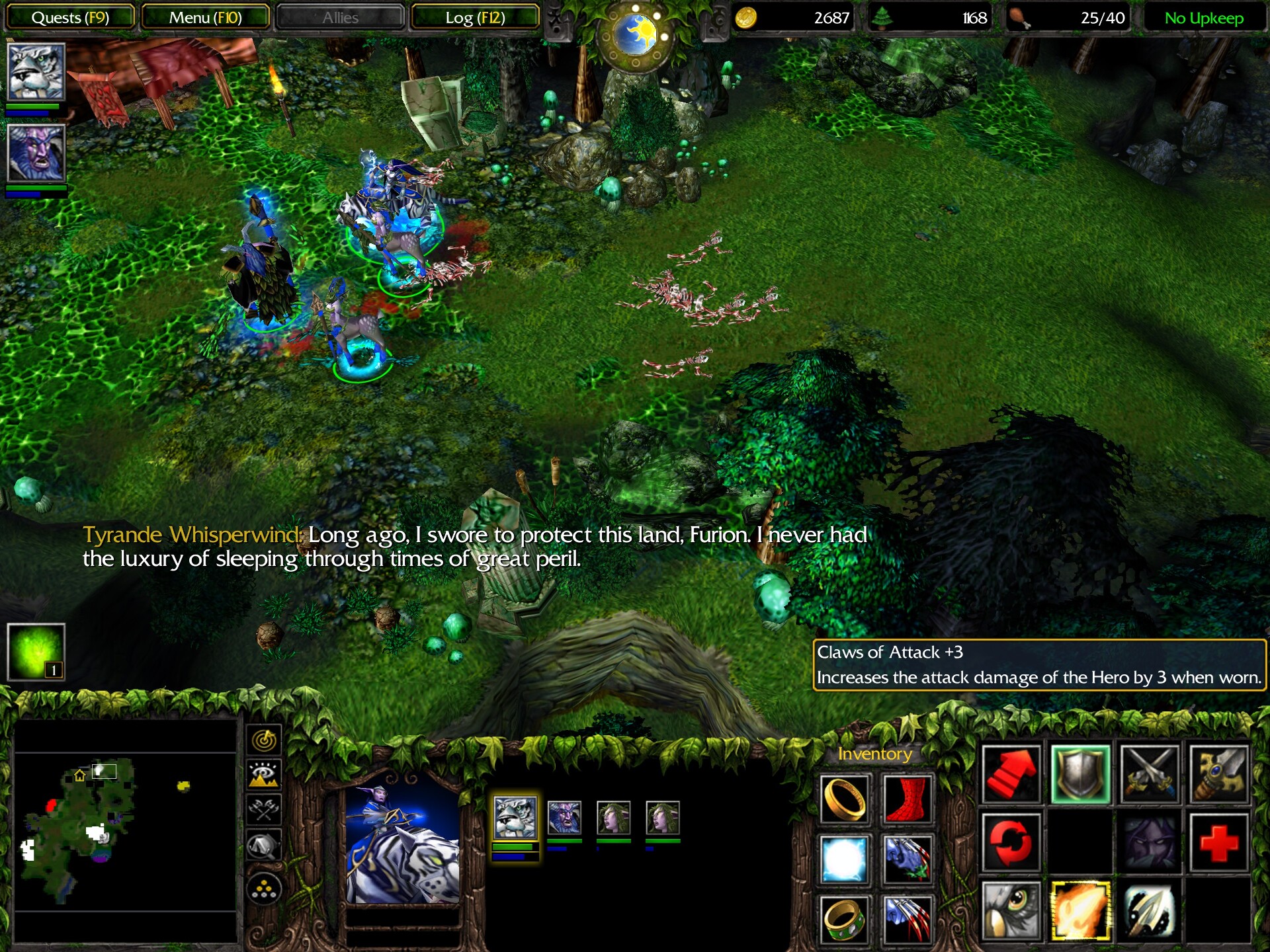
We’re seeing an interesting reversal of the usual gender dynamic in fantasy. Furion, the man, is the calm and diplomatic one, more willing to work together with others, and Tyrande, the woman, is the aggressive and bloodthirsty one, constantly talking about her plans to kill someone — while constantly shutting down Furion whenever he tries to speak against her. If the genders were switched, we’d already be crying foul. This story suggests — if what we’re seeing here is the norm — that night elf society might have gender dynamics just as skewered as many historical human societies, but in the other direction, which might be interesting to explore in depth–
Our sacred grove is being desecrated!
Sigh.
Eventually we come across a human base behind a gate. Of course, instead of trying to parley or anything, we just attack, raze it, and move our trees in its place.
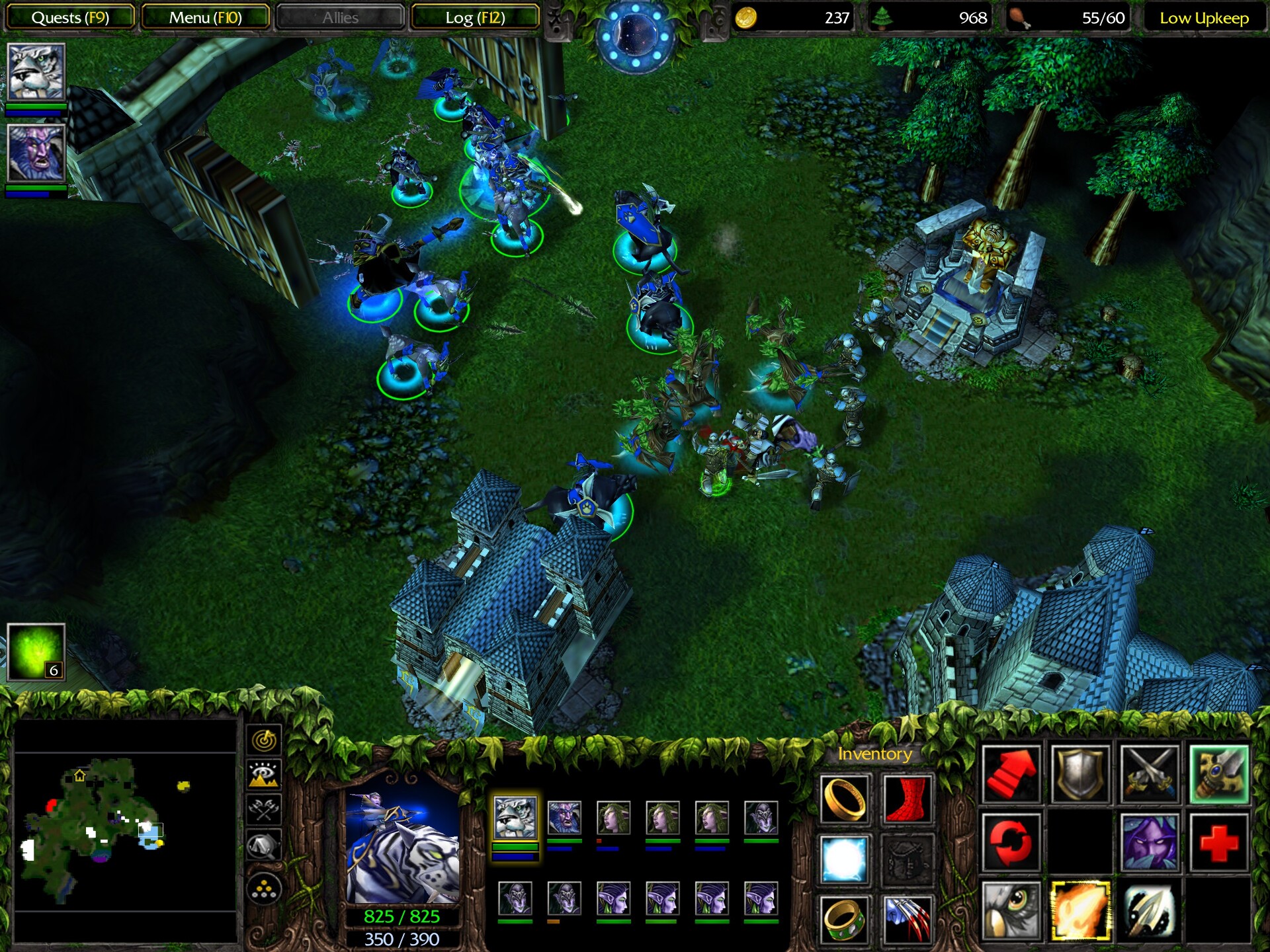
Next is a cursed forest populated by undead — not Scourge undead, but ye olde D&D-style undead. Skeletons are little more than a nuisance, but the woods are also filled with ghosts, who can possess your units like banshees do. On a map with limited gold, this stings. One way to counter it is to use just the heroes, who can’t be possessed, and dryads, who are immune to magic.
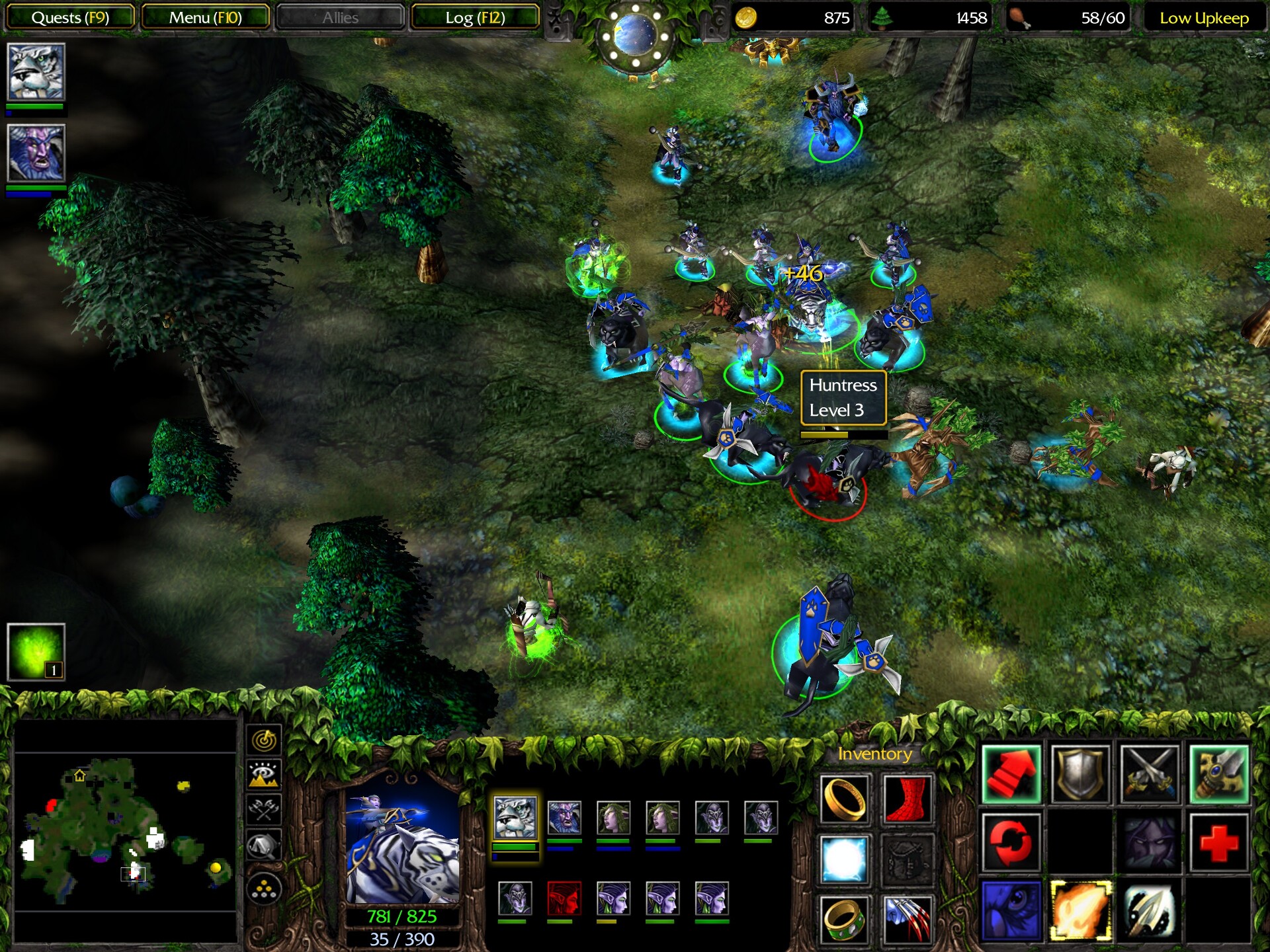
We get another side quest to kill the Death Revenant responsible for the curse, which restores the land, kills all the undead, and even cleanses the blighted trees.3 Some players actually prefer not to complete this quest, since the undead are a source of infinite gold in an otherwise gold-starved mission.
Past the cursed glade lies the night elf outpost that’s supposed to be defending the barrow dens… but something’s not quite right.
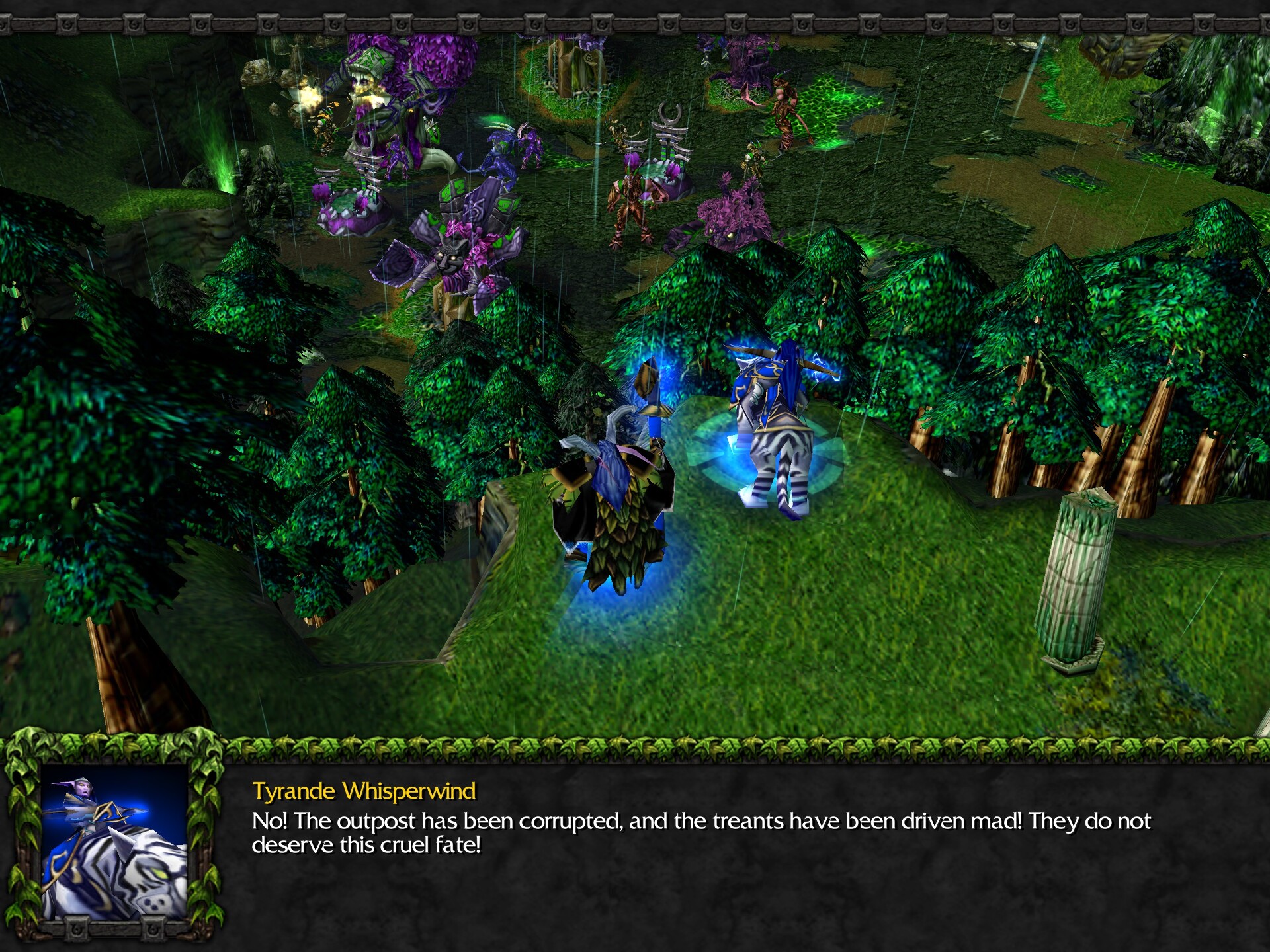
This base has been taken over by satyrs, and we need to destroy it to get to the barrow dens.
Here we see Warcraft 3’s twist on the concept of the mirror match. In Warcraft 1, 2, and Beyond the Dark Portal, each campaign had an obligatory mission where you fought your own faction. (Beyond the Dark Portal couldn’t shoehorn a human vs. human plot into the human campaign, so it has an orc vs. orc mission instead). In Warcraft 3, where each faction actually has gameplay mechanics very different from all others, straight mirror matches would be boring, so mission designers spice things up somewhat. We’ve already played regular orcs (plus their troll, tauren, and wyvern allies) against chaos orcs. Now we’re playing night elves against corrupted night elves. And yes, Furion identifies them as such.
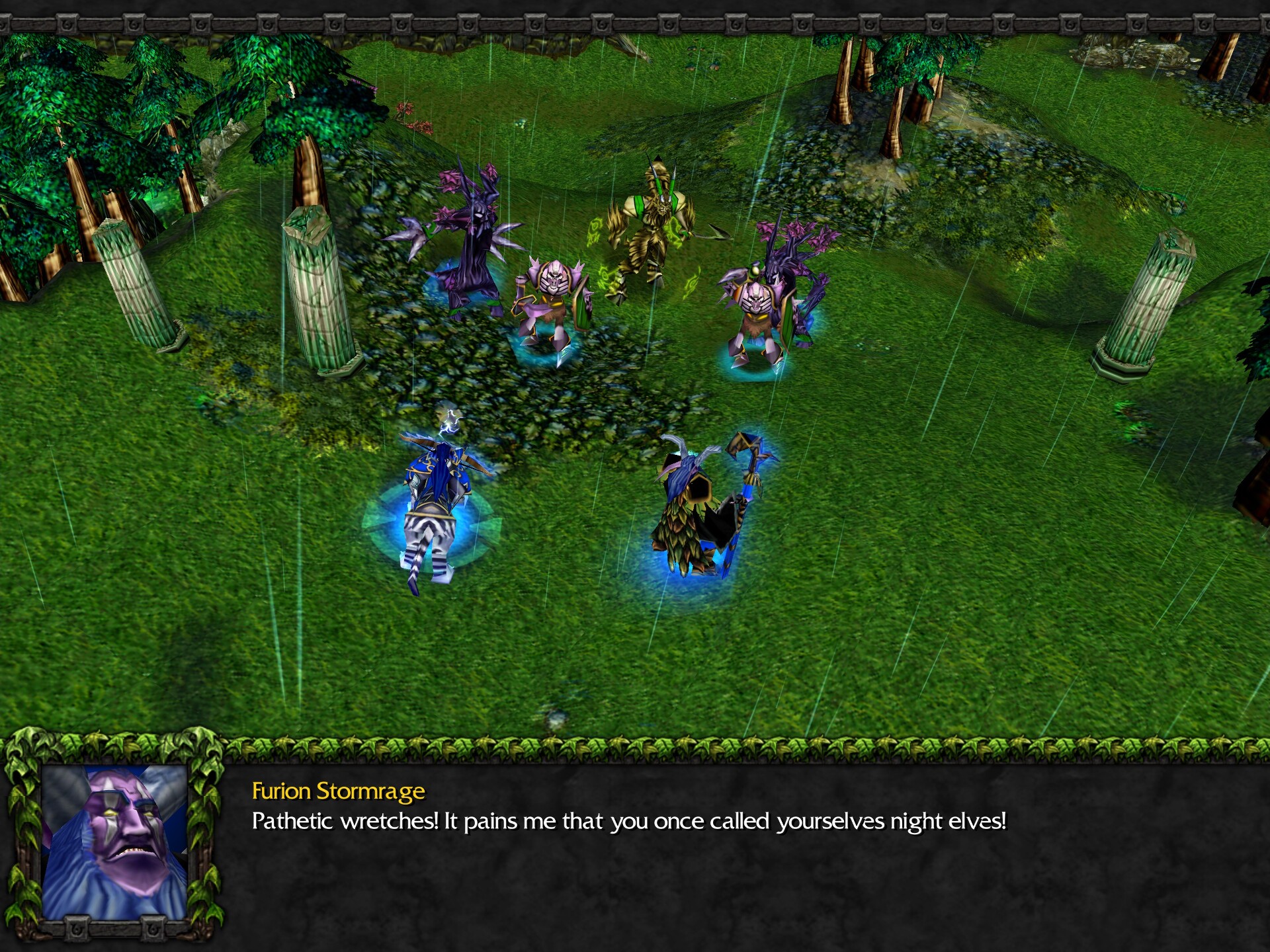
This revelation might feel like a random lore drop, but I think it actually serves a greater purpose: characterizing Furion. Throughout this campaign, he comments on things he encounters from the perspective of someone who’s been there and seen things, not unlike Gandalf. It helps sell the idea that he’s ancient, he’s knowledgeable about more things than we see, and in particular, he knows his enemies — and their weaknesses.
And with his knowledge, he might just find a way to beat an enemy that cannot be beaten through conventional force of arms.
Past the satyr base lie the barrow dens. Furion sounds the horn, and the druids of the talon awaken. Next are the druids of the claw.

This mission is a perfect example of why I love Warcraft 3 so much. It is absolutely crammed with stuff to discover, and is essentially several adventures packed into one. We crossed a war zone, caught in the crossfire of flyers fighting overhead; killed a whole tribe of crazed furbolgs; stormed a human base; cleansed a cursed glade populated by undead; and finally, put our own corrupted ancients out of their misery. The druids of the talon are really an arbitrary MacGuffin here; anything could be behind this gauntlet of obstacles. Gameplay-wise it’s a blast, and there’s so much stuff to try that every playthrough is going to be different.
Brothers in Blood
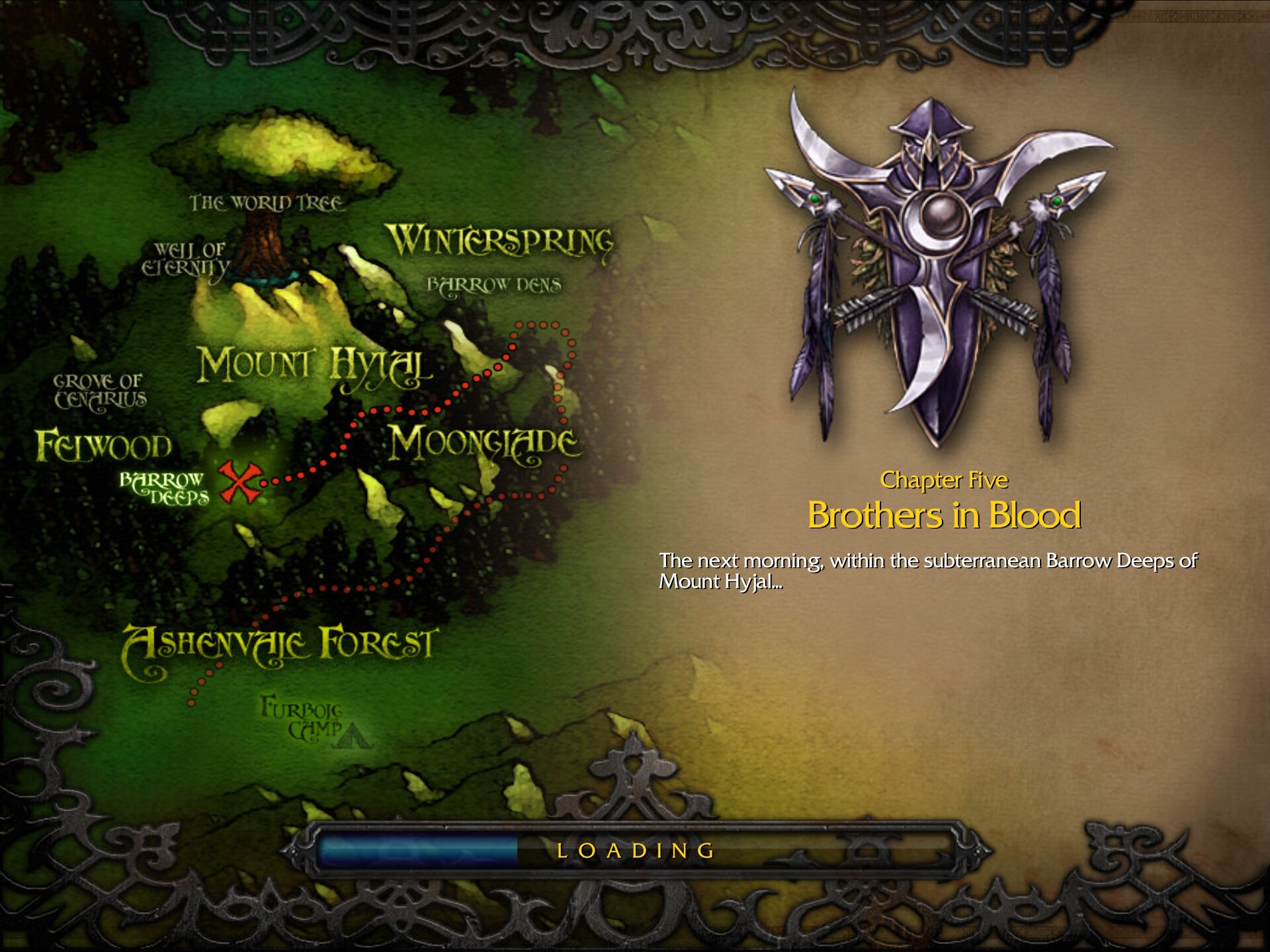
Now we delve into the Barrow Deeps below Mount Hyjal to awaken the slumbering druids of the claw. Furion is being knowledgeable and cautious, and Tyrande brash and practical.
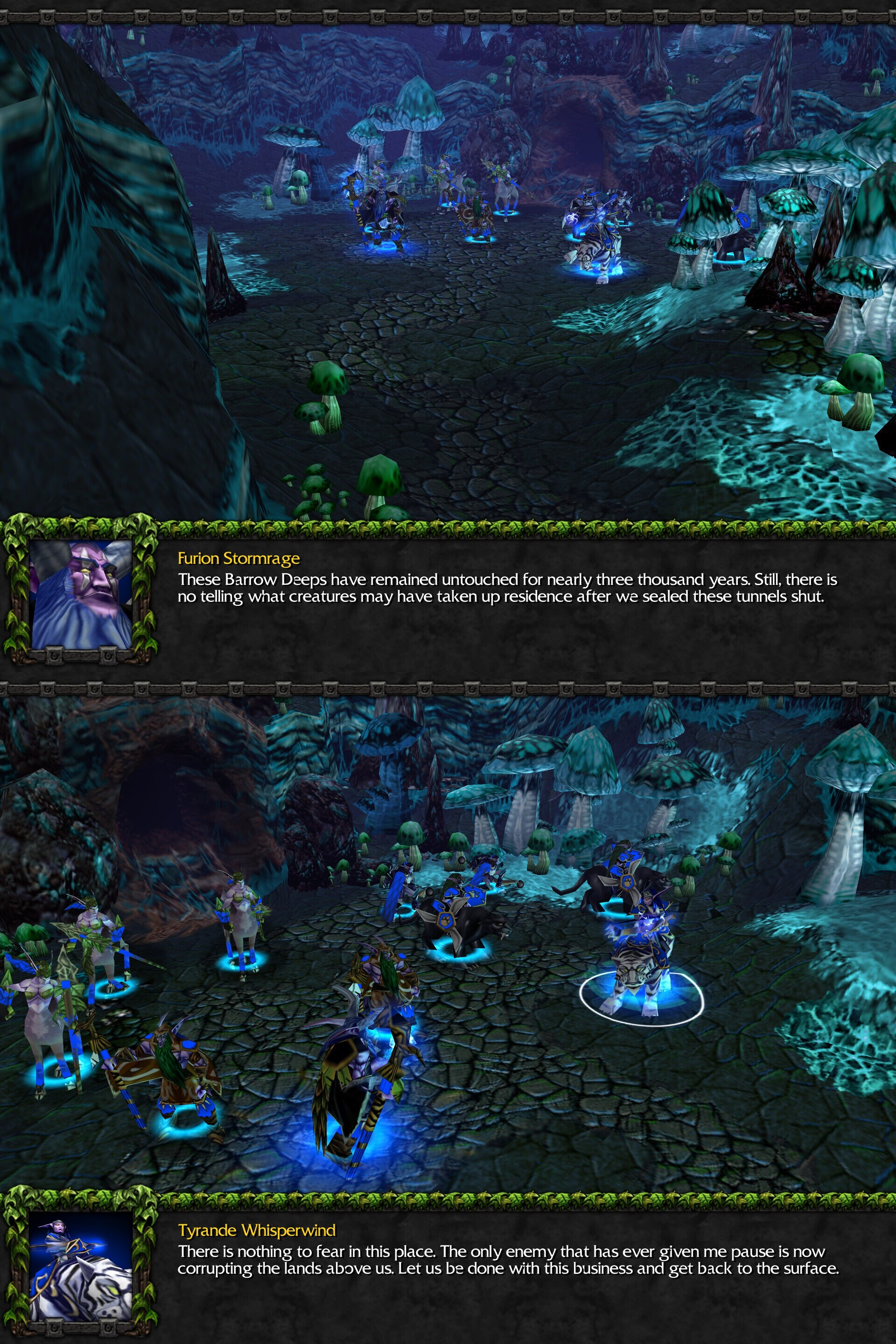
And then Furion is just like “Agreed. Just be careful.” I like how every time Tyrande rebukes him, he just goes along with her, as if he knows that arguing with her is a waste of time.
This is another dungeon crawl. Like Thrall’s Far Sight earlier, Tyrande’s Owl Scout is disabled here to avoid trivializing exploration. Unlike Thrall, it stings even more because while scouting abilities aren’t that useful in the campaign4, Tyrande starts with this ability, meaning that one of her skill points is permanently sunk into a very situational exploration ability rather than one useful in combat.
Once again, Tyrande’s reaction to meeting everything tainted by evil is to exterminate it with extreme prejudice.
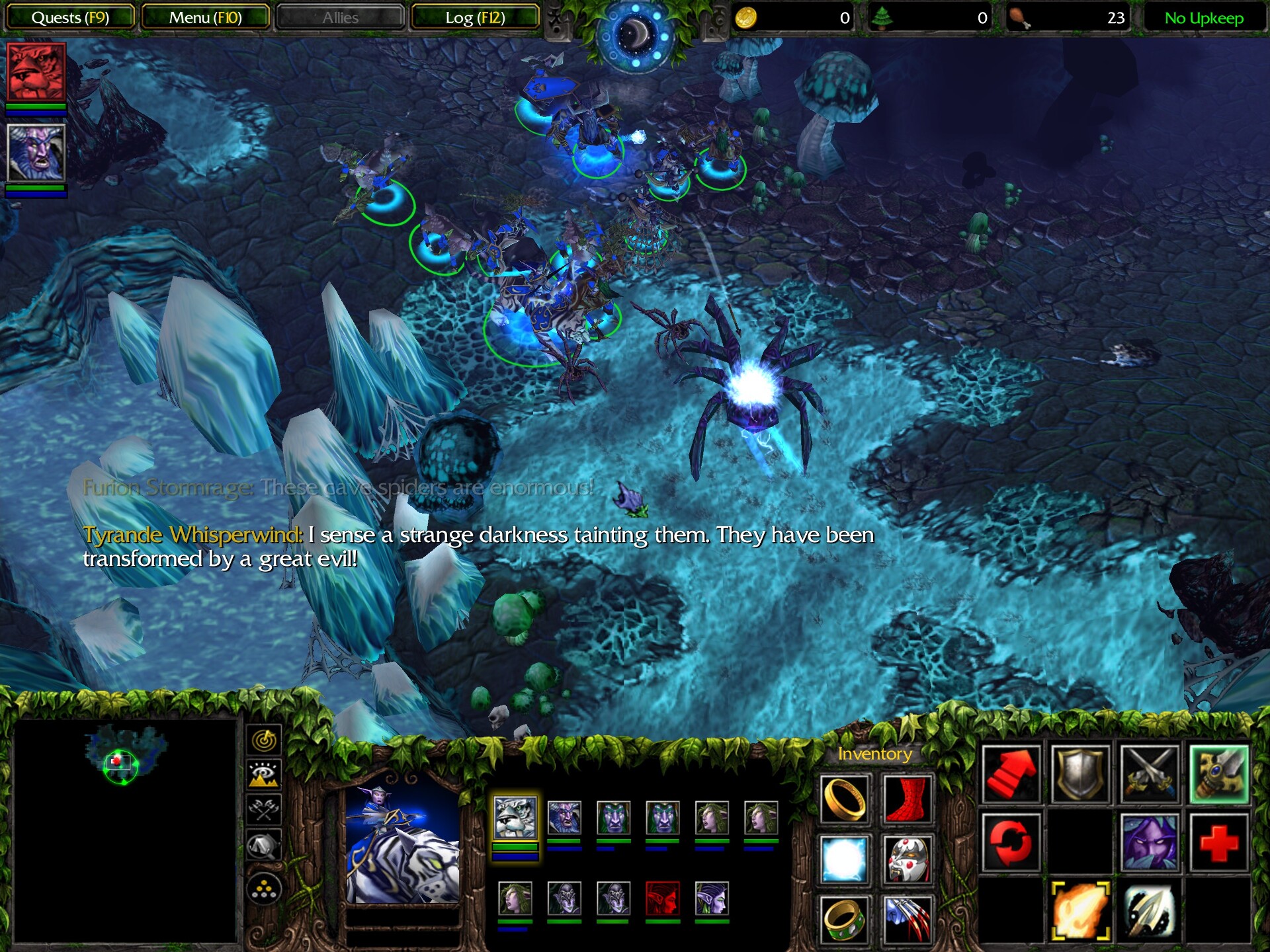
We’ve unlocked druids of the talon, whom, I hate to say, I haven’t found that useful in this campaign. They have an autocast debuff (Faerie Fire)… but it’s most useful against small numbers of strong units, while our primary enemy favors spamming large waves of individually weak units. They can transform into birds that can only attack air… in a campaign that has almost no flying enemies.5 Finally, Cyclone tosses an enemy into the air without damaging it, useful for disabling enemy commanders while we make work of their minions… which does come sporadically useful, but mostly later in this mission.
Eventually we come upon this suspicious growth of giant mushrooms, and it seems there’s a passage behind them.
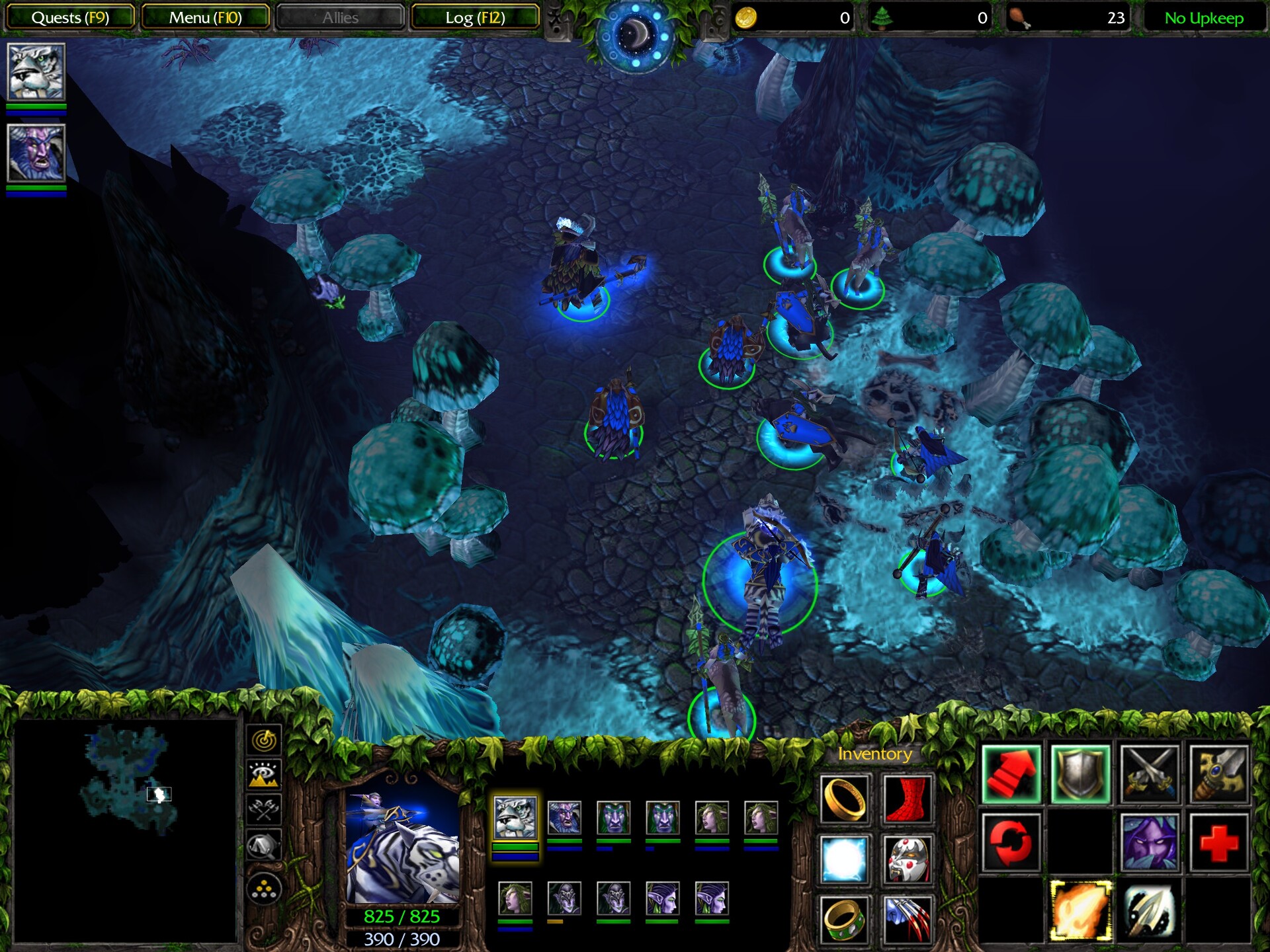
This is a map secret. The game doesn’t explain this, instead relying on you to figure out by yourself that:
- The giant mushrooms work as trees game-mechanically.
- You have a hero who can turn trees into walking trees.
- If you clear enough of the mushrooms, you will open an entrance to the blocked passage.
And you might have discovered the first two if you’ve regularly made use of Furion’s Force of Nature ability (and you should). “Hmm, this map has no trees, but these giant mushrooms are about tree-sized. I wonder what happens if… Oooh!”

The passage is littered with menacing bones and is home to… THE LARGEST PANDA EVER!6 It drops a Necklace of Spell Immunity, one of the best items in the game that will make the final mission a lot easier.
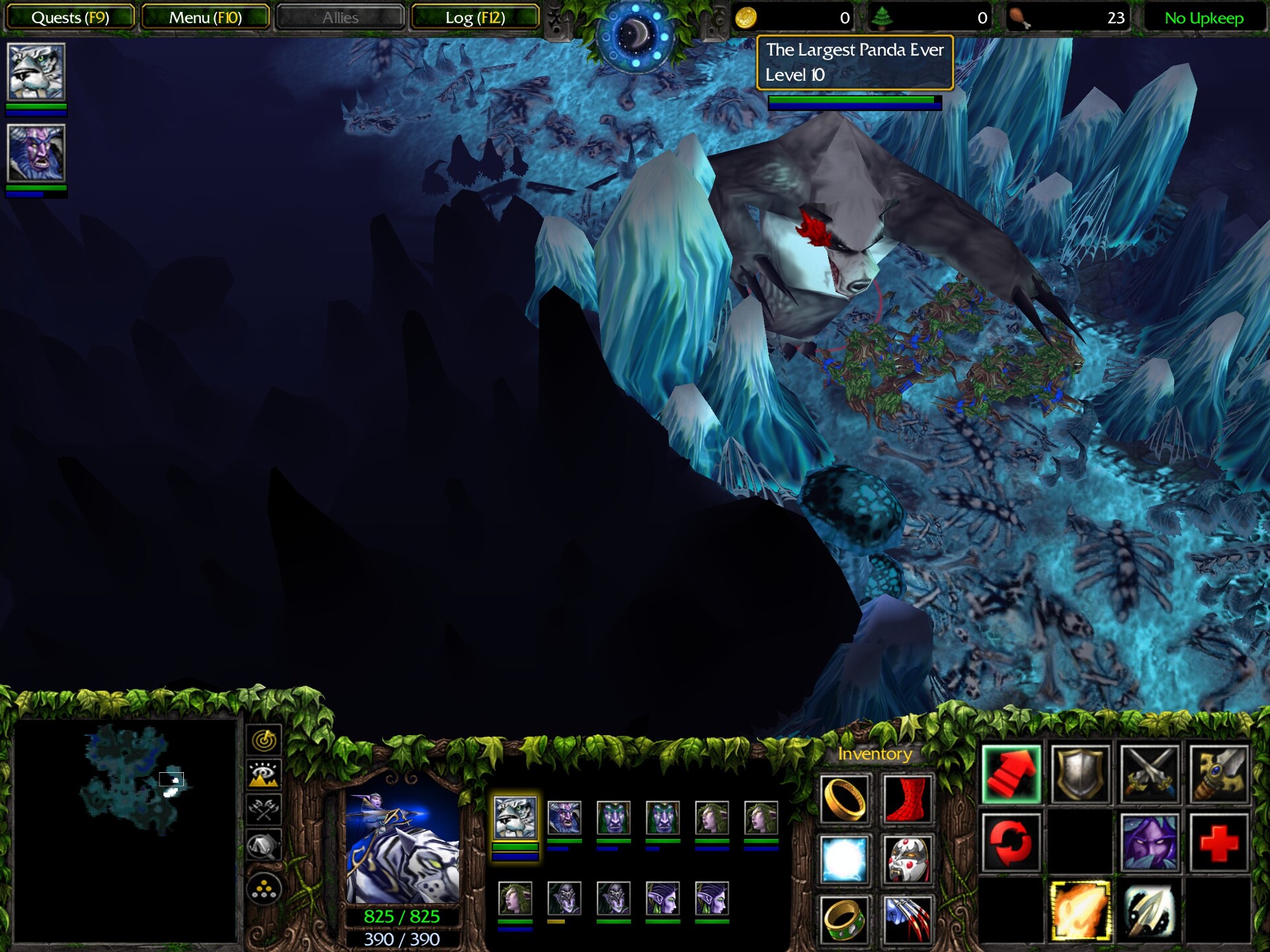
There’s another encounter with giant spiders at a defiled fountain, and Tyrande and Furion both reach level 6, unlocking their ultimate abilities. I don’t know if it’s intentional — after all, their gameplay mechanics are the same as of the generic Priestess of the Moon and Keeper of the Grove hero classes — but I like how even their ultimate abilities make a contrast with each other that fits their personalities. Tyrande gets Starfall, a channeled AoE damage spell that rains falling stars on the heads of nearby enemies. Furion, meanwhile, gets Tranquility, a channeled AoE heal that rains revitalizing… er, rain on the heads of nearby allies. One takes lives and the other saves them. Perfectly balanced, as all things should be.
Now that we’ve got a powerful combat heal that recharges fairly quickly, we no longer need healing items and can afford to be less cautious.
Past the spiders, we reach another group of furbolgs who have a side quest for us. While I’m gushing about Warcraft 3, I have to mention how much I admire the furbolg chieftain’s diction. The voice acting in this game is almost universally superb.
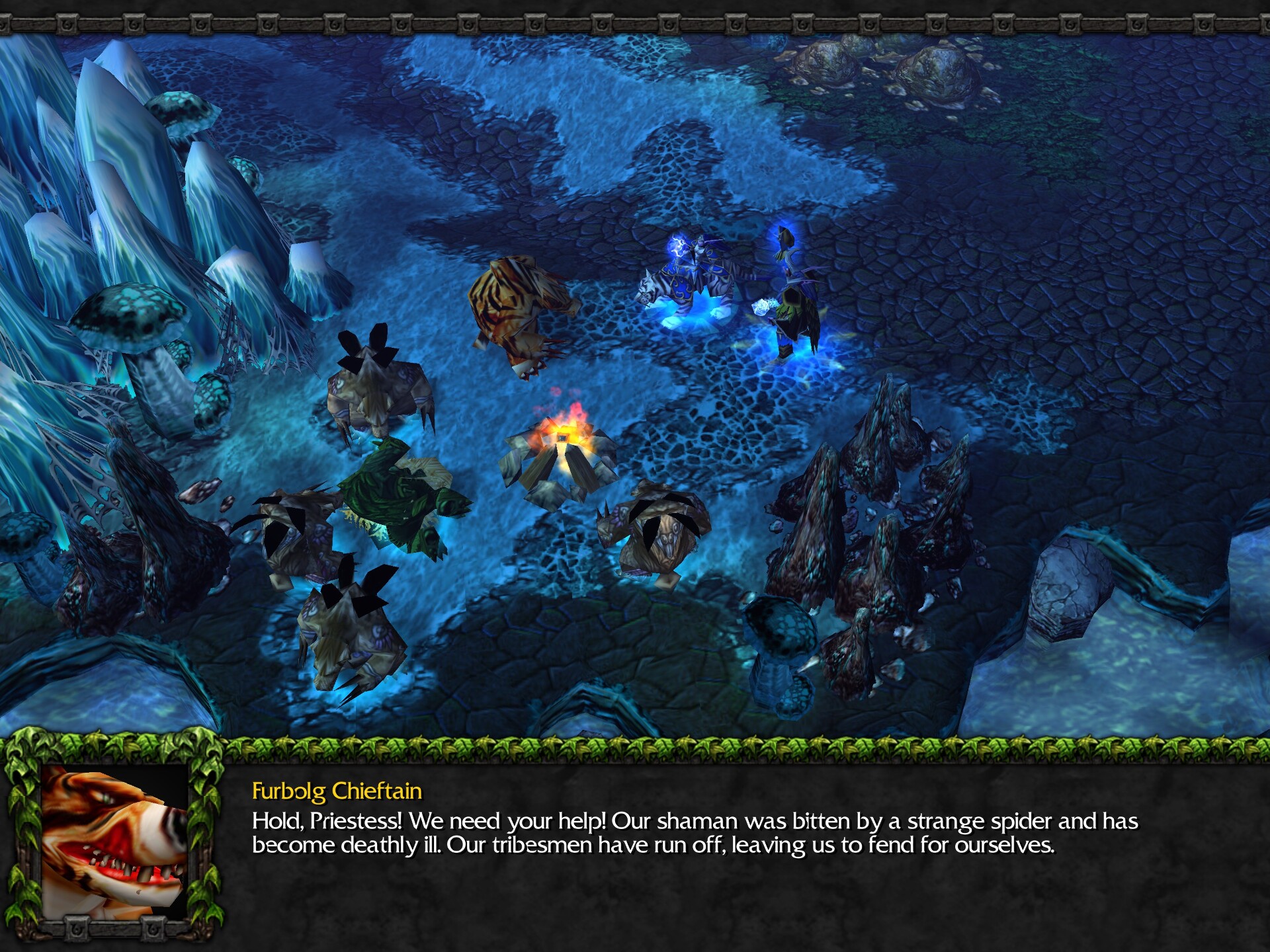
These furbolgs have escaped the corruption that claimed their surface brethren, but their shaman has been bitten by a radioactive spider and poisoned, and only water from the nearby fountain of life — overrun by hostile creatures — can save him. We kill the undead and lightning lizards, fill the vial, return it (after healing our own units at the fountain), and as a reward, we get a talisman that will let us summon up to three furbolgs to temporarily fight at our side in a pinch.
It’s a small and wholesome quest, and I like it because it emphasizes two points:
- For all of Tyrande’s flaws, the forest creatures are her charge, and she’s always willing to help.
- While the furbolgs don’t have much in terms of magic items to spare, they’re always ready to spare some of their own warriors to fight alongside the night elves.
Next I save the game, because we’re about to hit a point of no return. The heroes reach the entrance to some kind of underground complex, and Furion is alarmed.
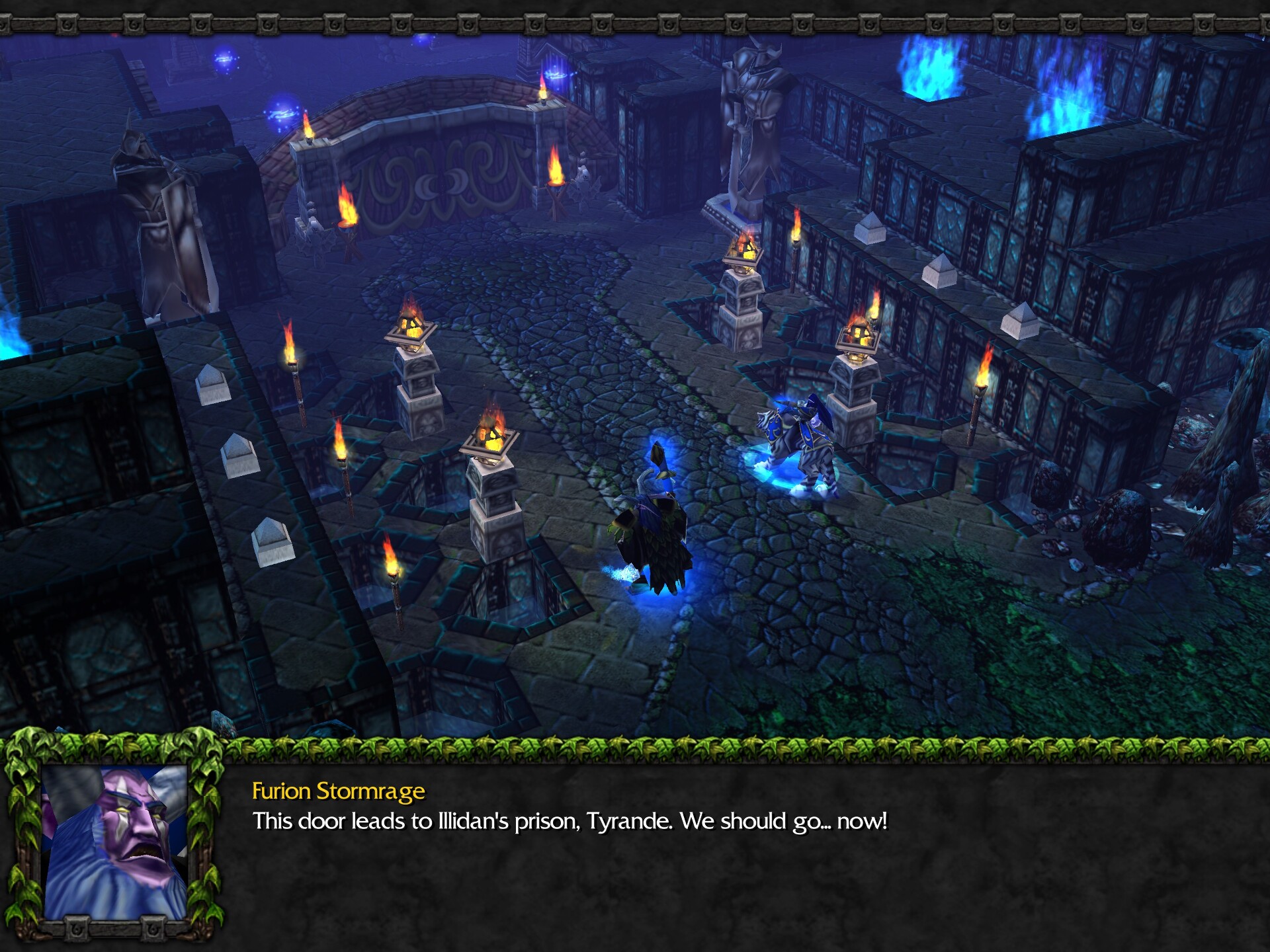
Whoever this Illidan is, Tyrande thinks he would be the perfect ally against the demons if freed, but Furion is adamant that this “beast” — who is his own brother, incidentally — is too dangerous to be set free. He forbids Tyrande from doing it — and, of course, she doesn’t listen. Again.
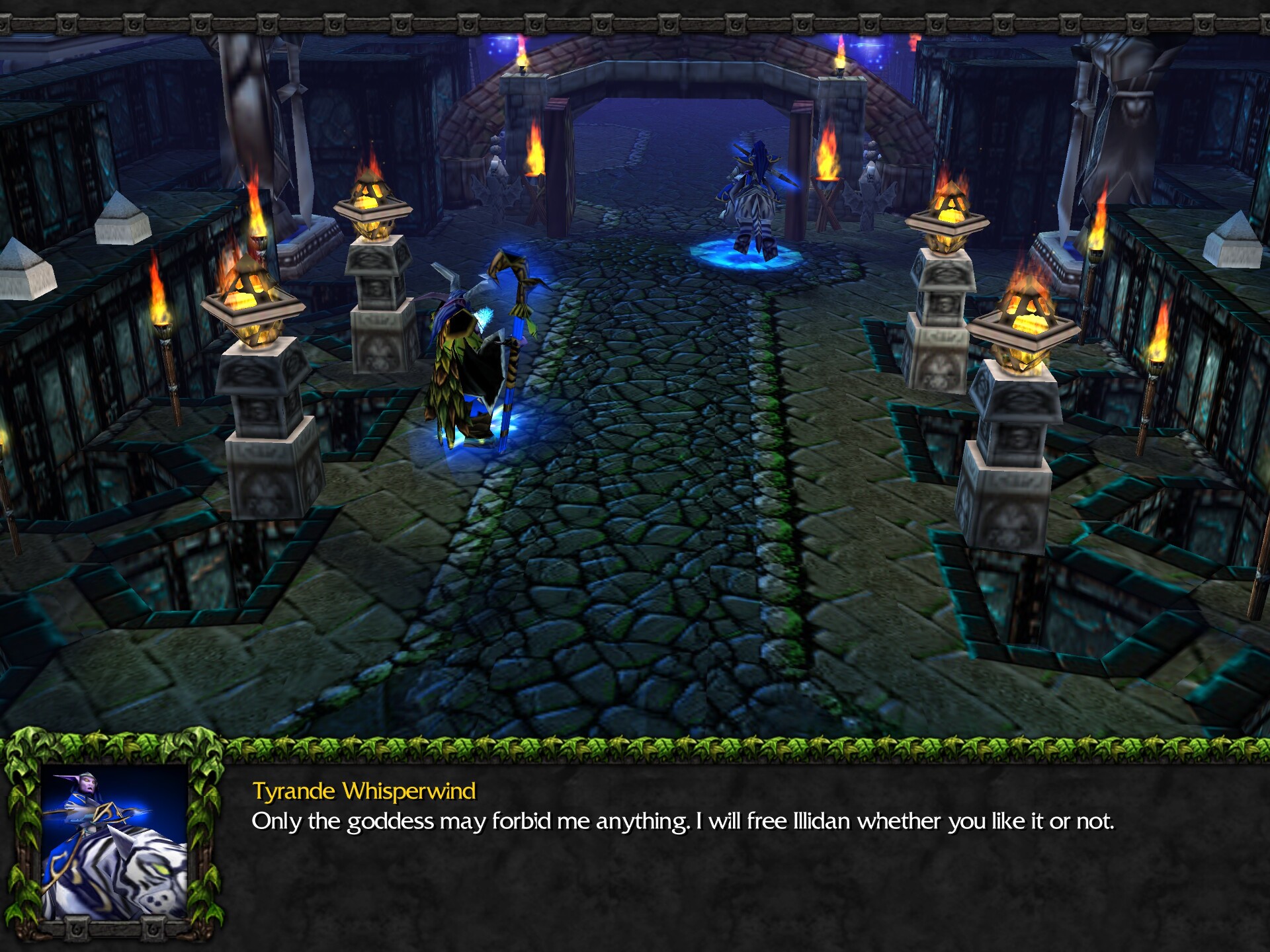
Furion’s Quest: Awaken Druids
The two split up. Tyrande takes all the archers and huntresses with her, and we’re left controlling Furion, druids of the talon, and dryads. Furion still aims to awaken the druids of the claw, and they set off, reaching another circle of power that’s supposed to activate a spirit bridge.
Unlike the orc campaign’s dungeon crawl, where we spent half the mission looking for the enchanted gemstone to activate the bridge, here Furion just has to say a word to pass. This helps reinforce the idea that he’s not only a knowledgeable sage, but also the legitimate authority here, while everyone else has to jump through hoops to override magical security systems.7
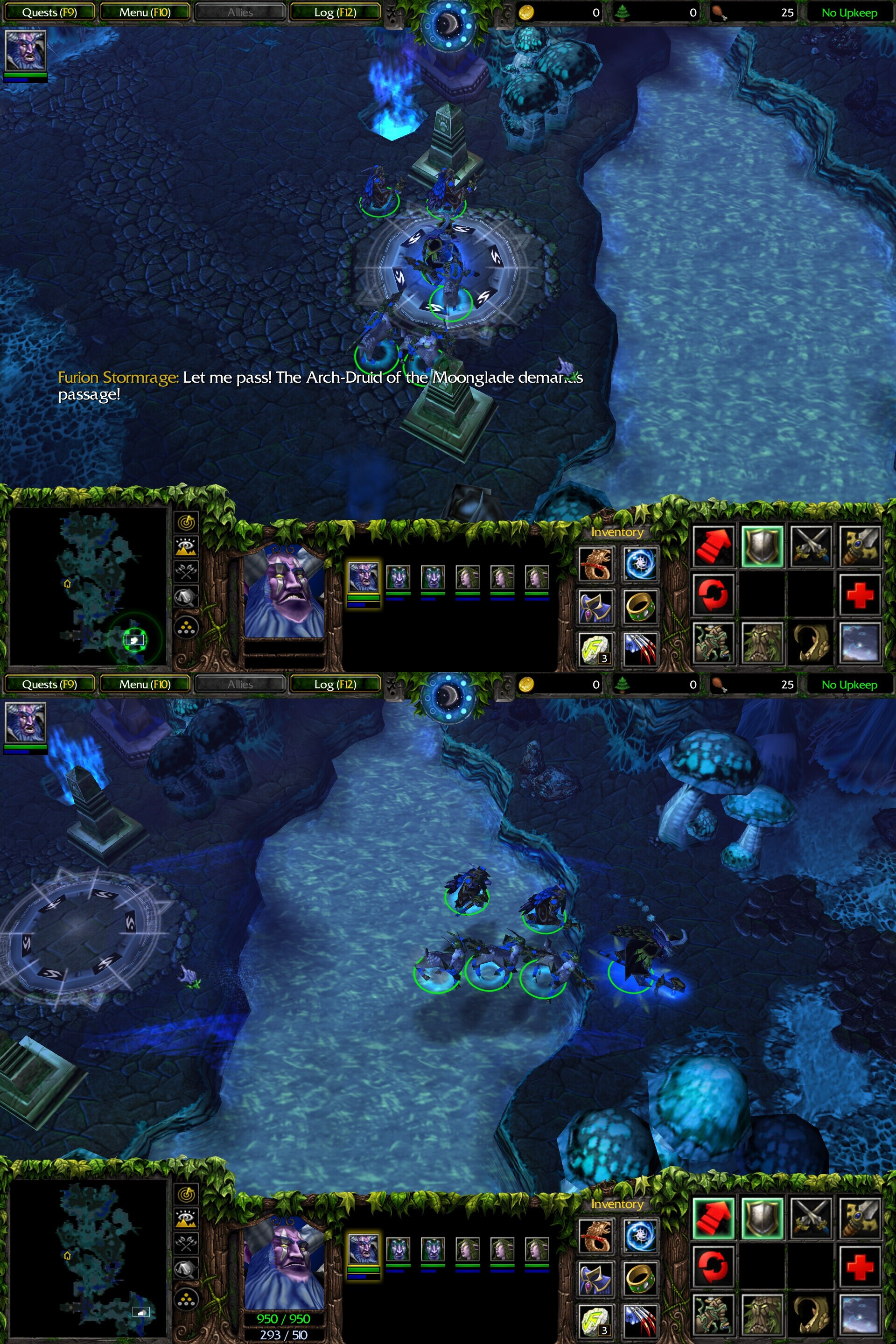
On the other side, the party runs into hostile owlbears who declare them “unworthy of the bear gods’ presence”. Furion realizes they must be referring to the druids of the claw. Then we fight some black dragon whelps, whom Furion identifies as “foul spawn of Deathwing” who have taken refuge beneath the earth. Perhaps he has some kind of history with Deathwing? Hmmm.
The druids of the claw, as it turns out, are awake already, but have lost themselves to their animal instincts and turned feral, attacking Furion’s forces. In a cutscene, the druids of the talon use Cyclone to disable them, thus showing the player what they need to do to pass through the druids of the claw without harming them.
Furion then has this genius insight:
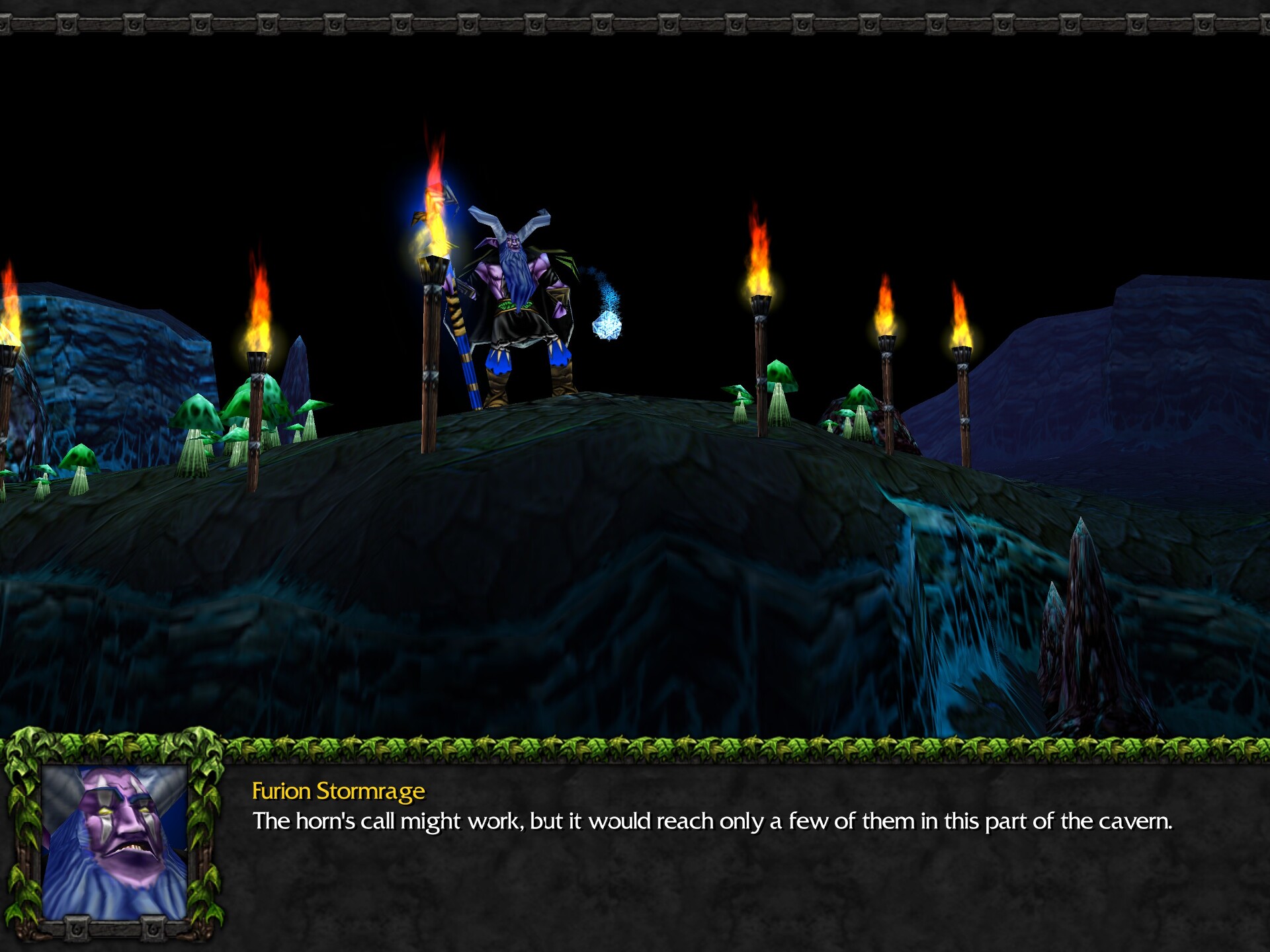
I don’t really understand what stops him from sounding the horn right here anyway and awakening the druids in the immediate vicinity, and then doing it bit by bit as they advance deeper into the cavern. Does the horn have a long cooldown or something?
But whatever. Thus begins a gauntlet where we have to navigate a long, twisting passage filled with hostile mobs, until Furion reaches the final circle of power from which he can sound the horn. It’s filled with hostile undead, spiders and sludges, whom we can kill, and hostile druids of the claw, who attack us but must not be killed. This section teaches us the use of Entangling Roots and Cyclone for crowd control. We can either advance methodically, killing the creeps, or we can just rush through without engaging, taking massive losses, but all that matters is that Furion reaches the end of the passage.
As before, Furion sounds the Horn of Cenarius, and his brethren awaken.
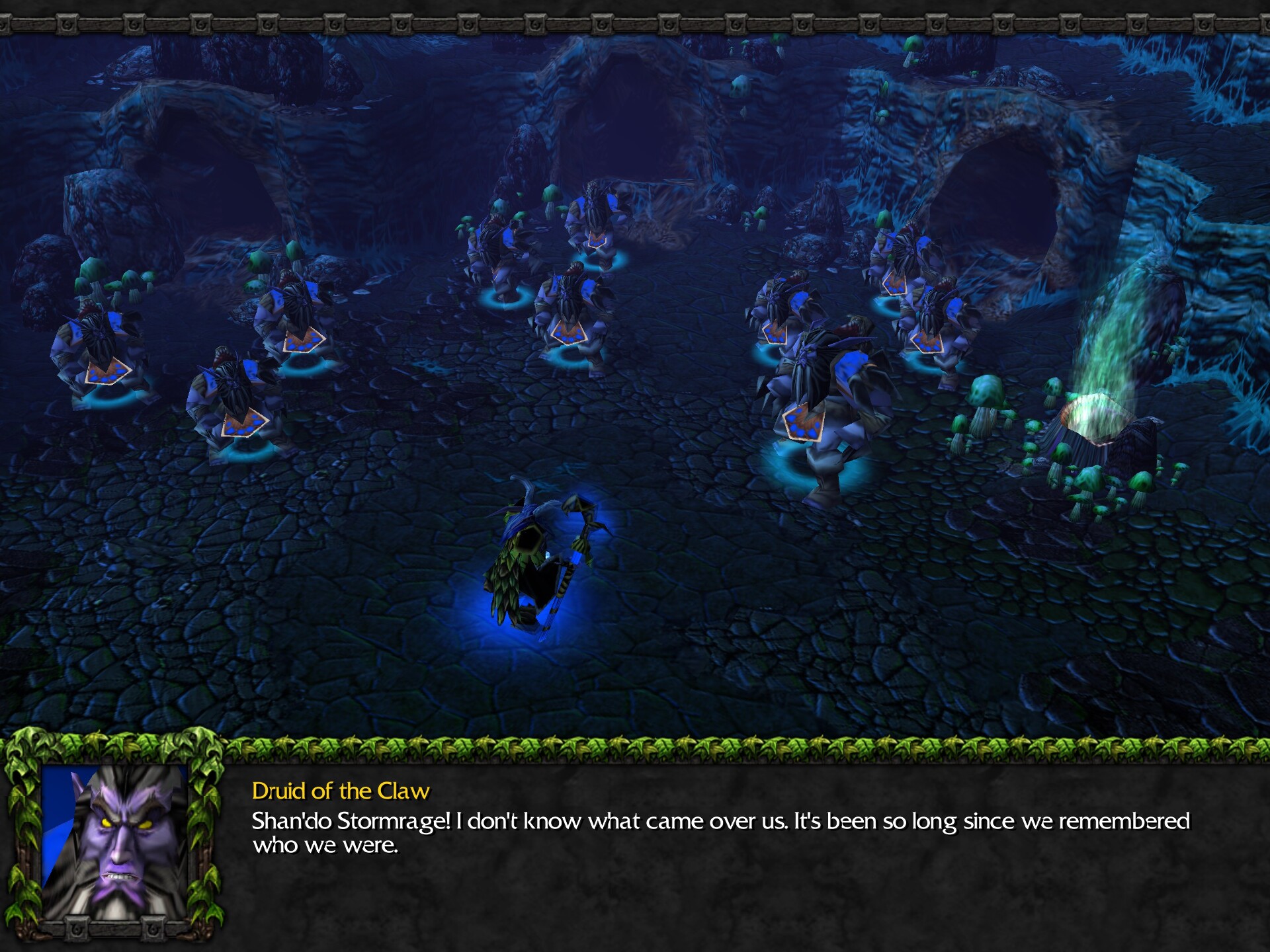
Tyrande’s Quest: Free Illidan
Meanwhile, Tyrande and her Sentinels enter the prison complex.
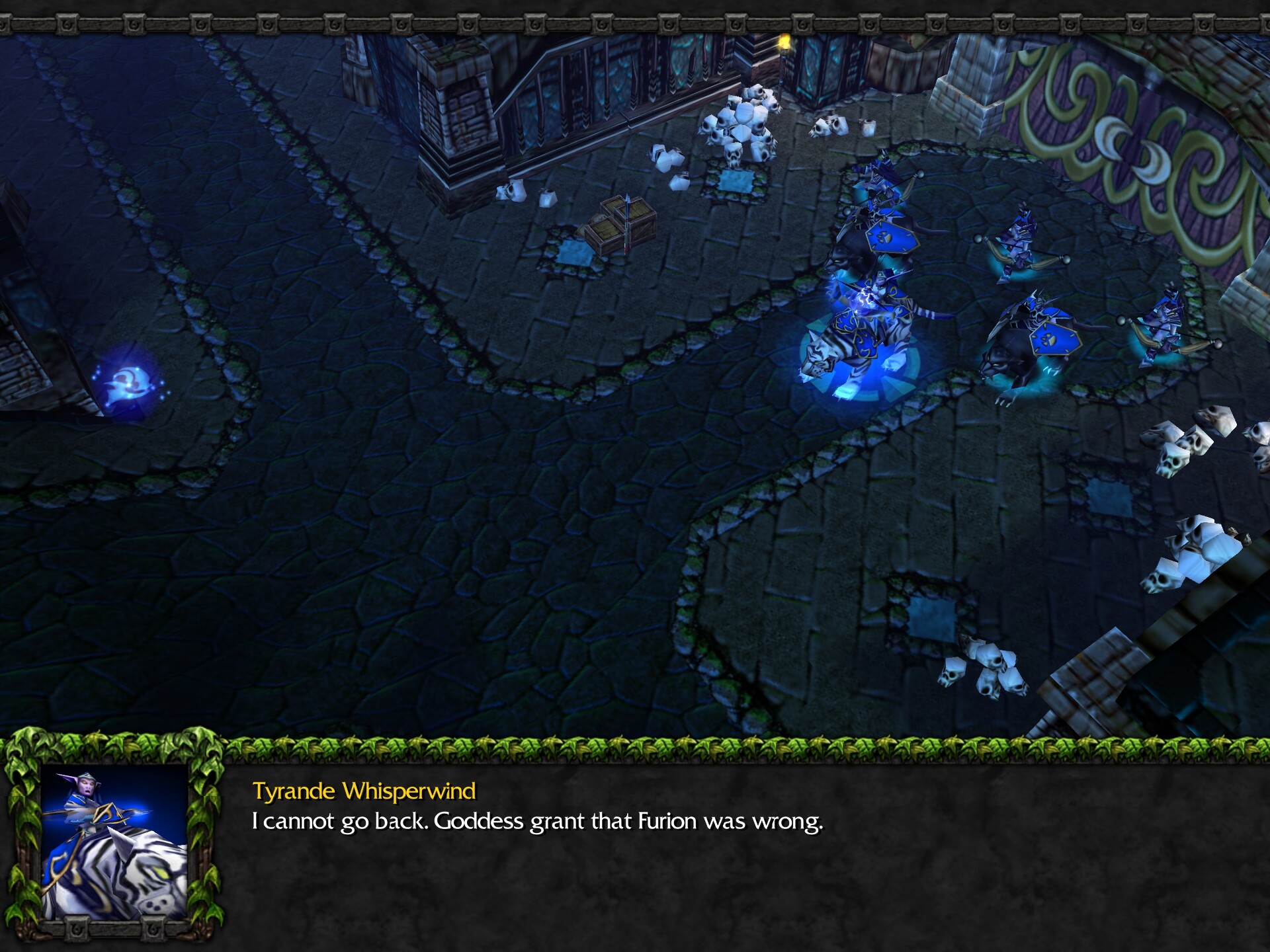
They’re faced with an owlbear who happens to have a theological disagreement with Tyrande about the goddess’s intentions. Instead of discussing the matter peacefully at an ecumenical council, they, of course, just attack. If I had a coin for every armed conflict in Warcraft 3 that could be solved by the belligerents lowering their arms and talking, I could fund an actually good remaster of the game.
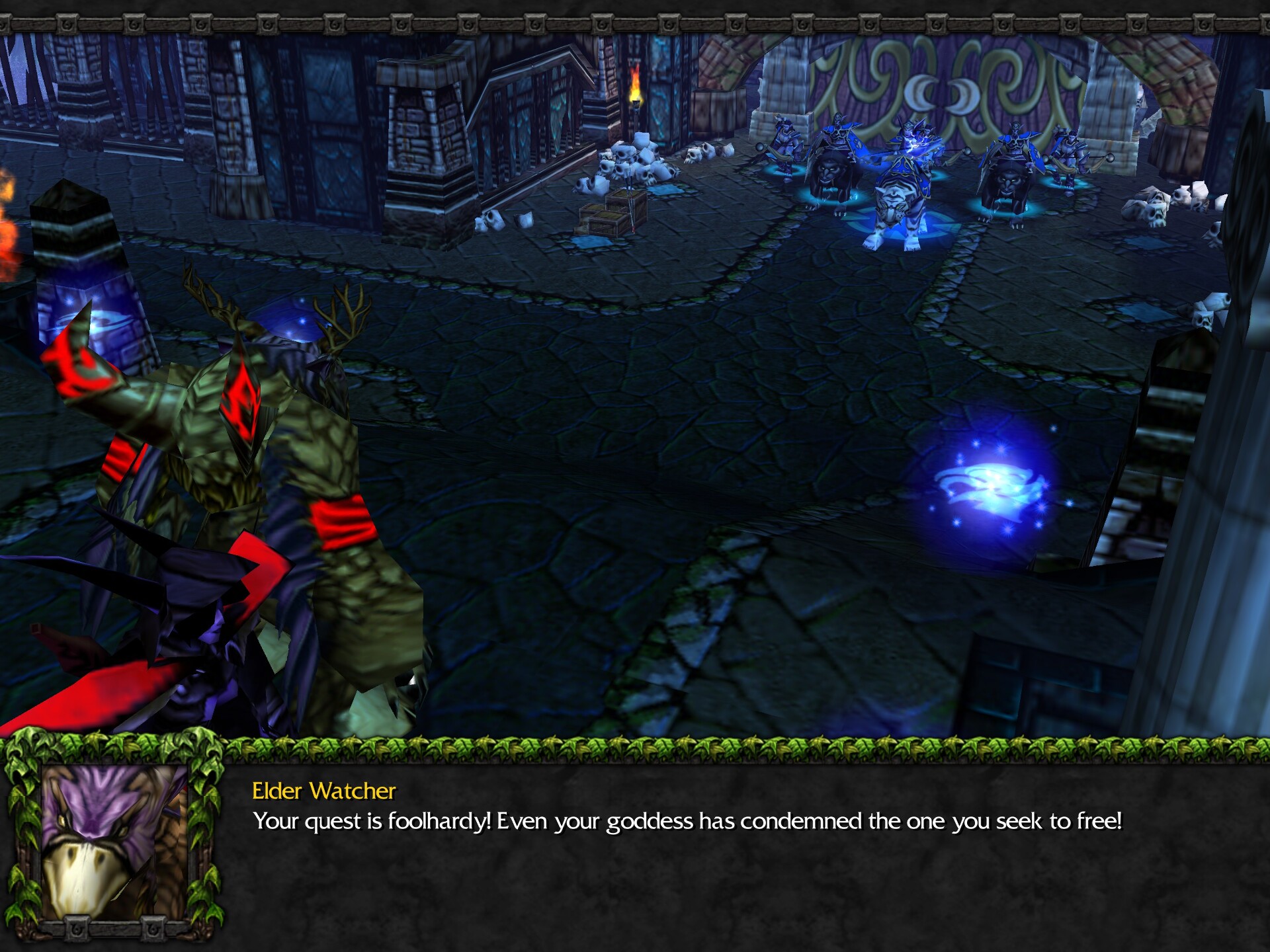
First of all… owlbears can talk? They’re people and not just feral beasts? This makes Thrall’s wildlife-purging spree in the orc campaign even more suspect.
Second of all, this entire segment of the mission makes no sense and baffles me to this day.
Tyrande is the High Priestess of Elune, the leader of the kaldorei nation. This prison complex is full of hostile guards, who consist of owlbears and campaign-only night elf units. Can’t she just order them to stand down? Or are they not subject to her authority? Do the night elves believe in separation of powers unlike every other culture seen in this setting?
The puzzles don’t end here. The prison wardens are clearly engaged in some kind of arcane research:
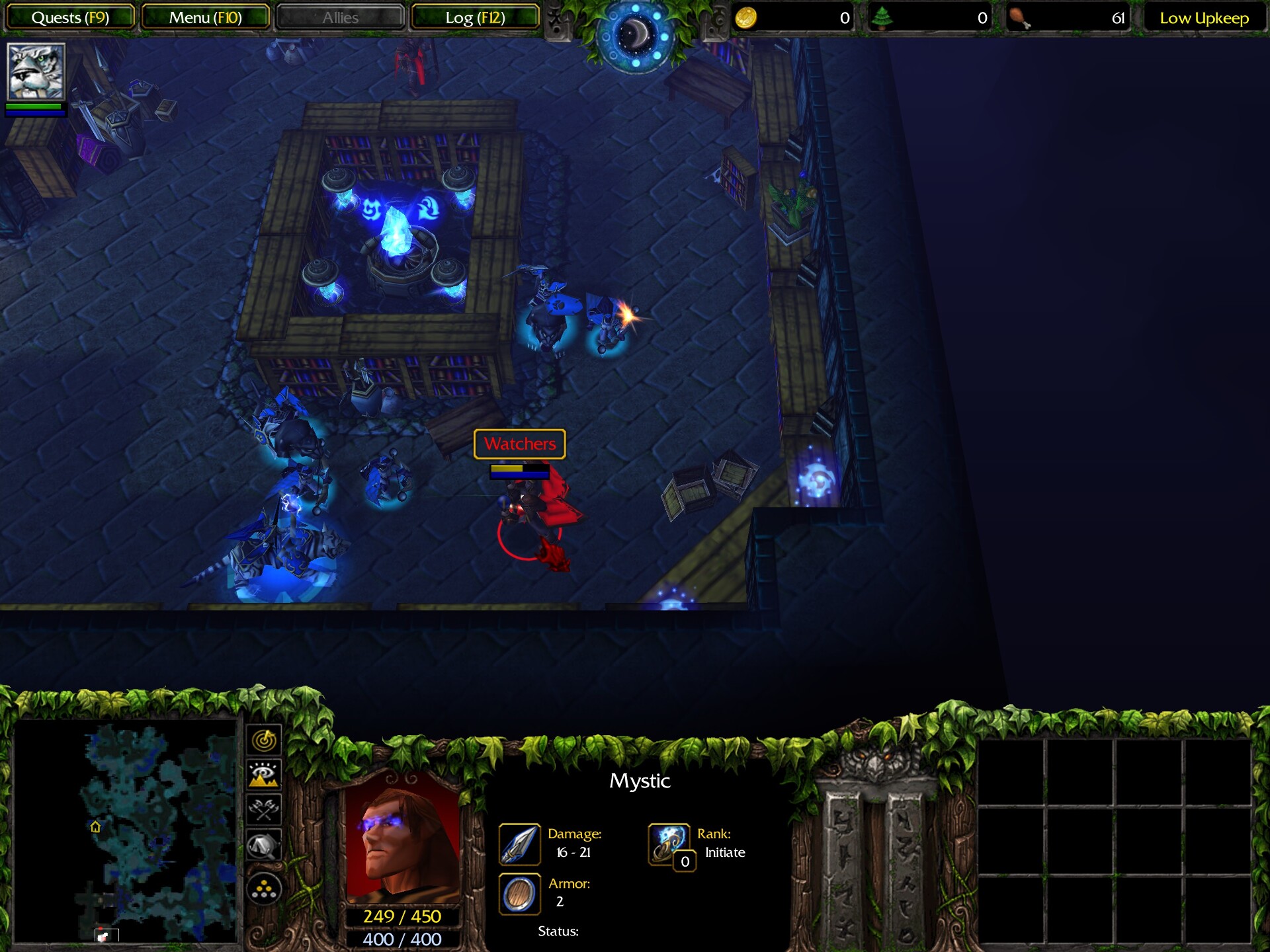
These mystics reuse the emissary model from the human campaign. They’re apparently supposed to be either humans or high elves (in Reforged, they use high elf models). How did they get here? What is their goal here? Why are they on the prison wardens’ side?
They’re holding Sentinels prisoner? For what crimes?
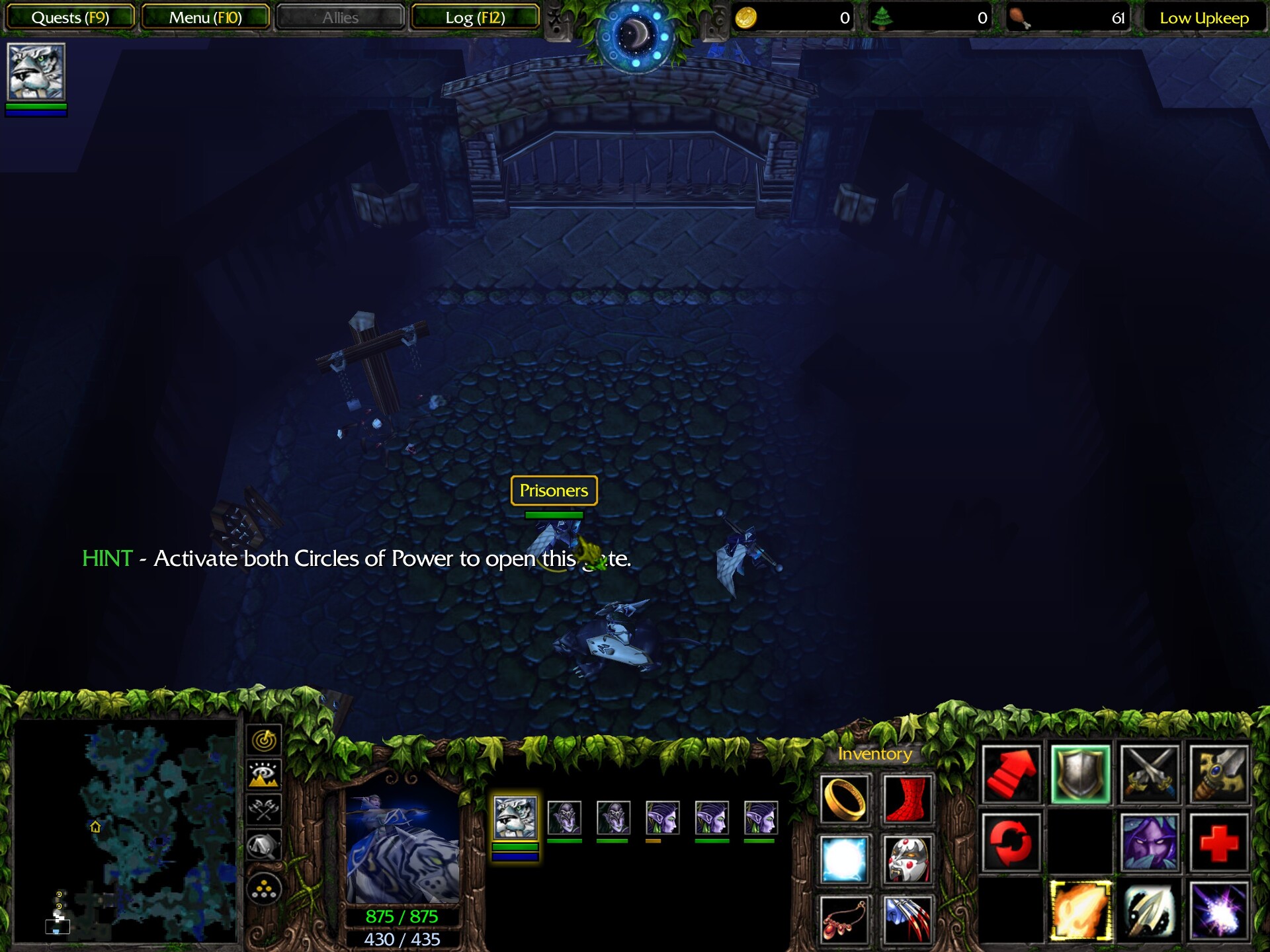
Tyrande can kill wardens in their sleep! (Which admittedly fits her pragmatic personality.)
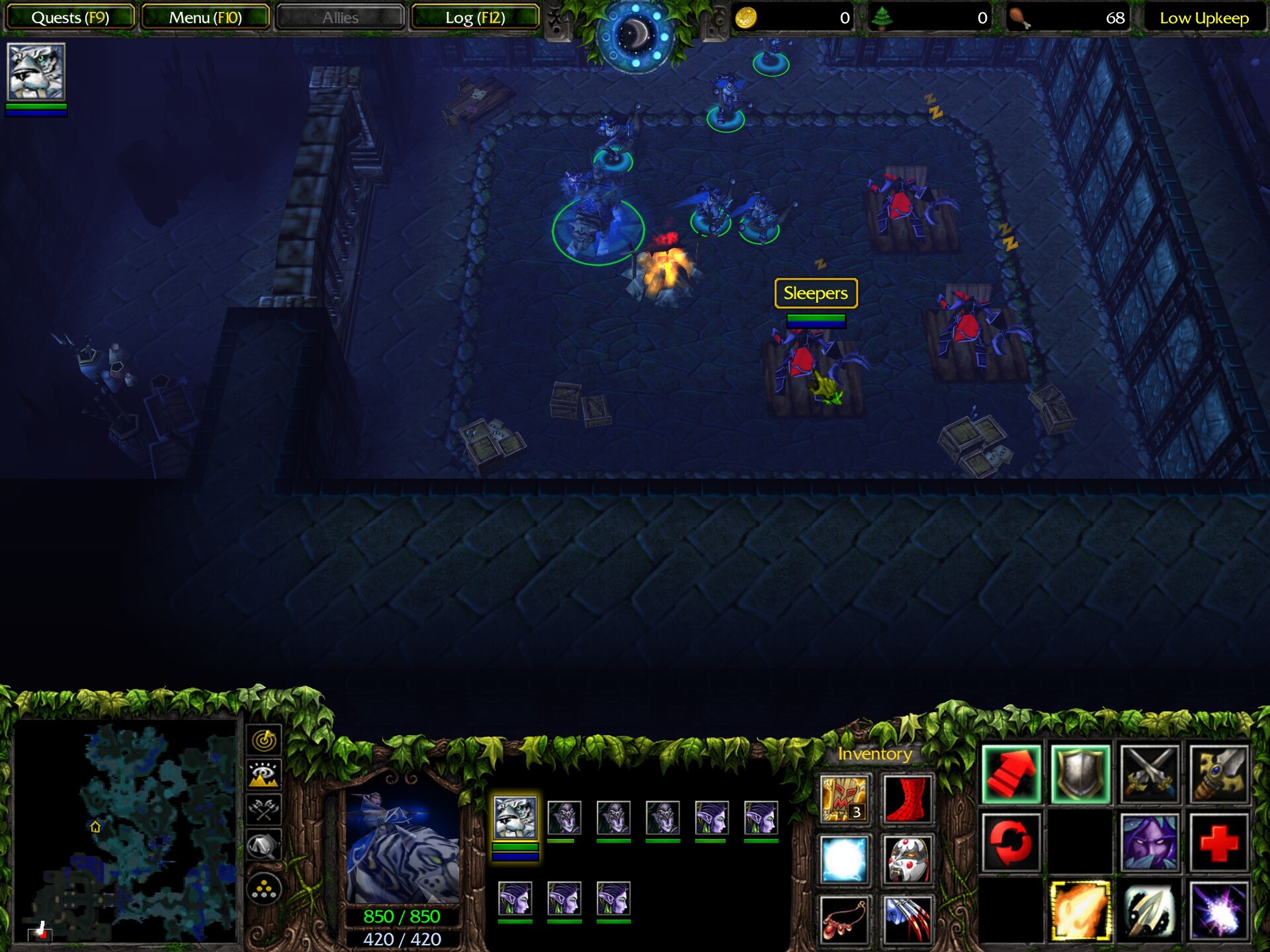
There are piles of skulls everywhere? The final boss is a level 3 keeper of the grove surrounded by trees growing on hard rock, underground?
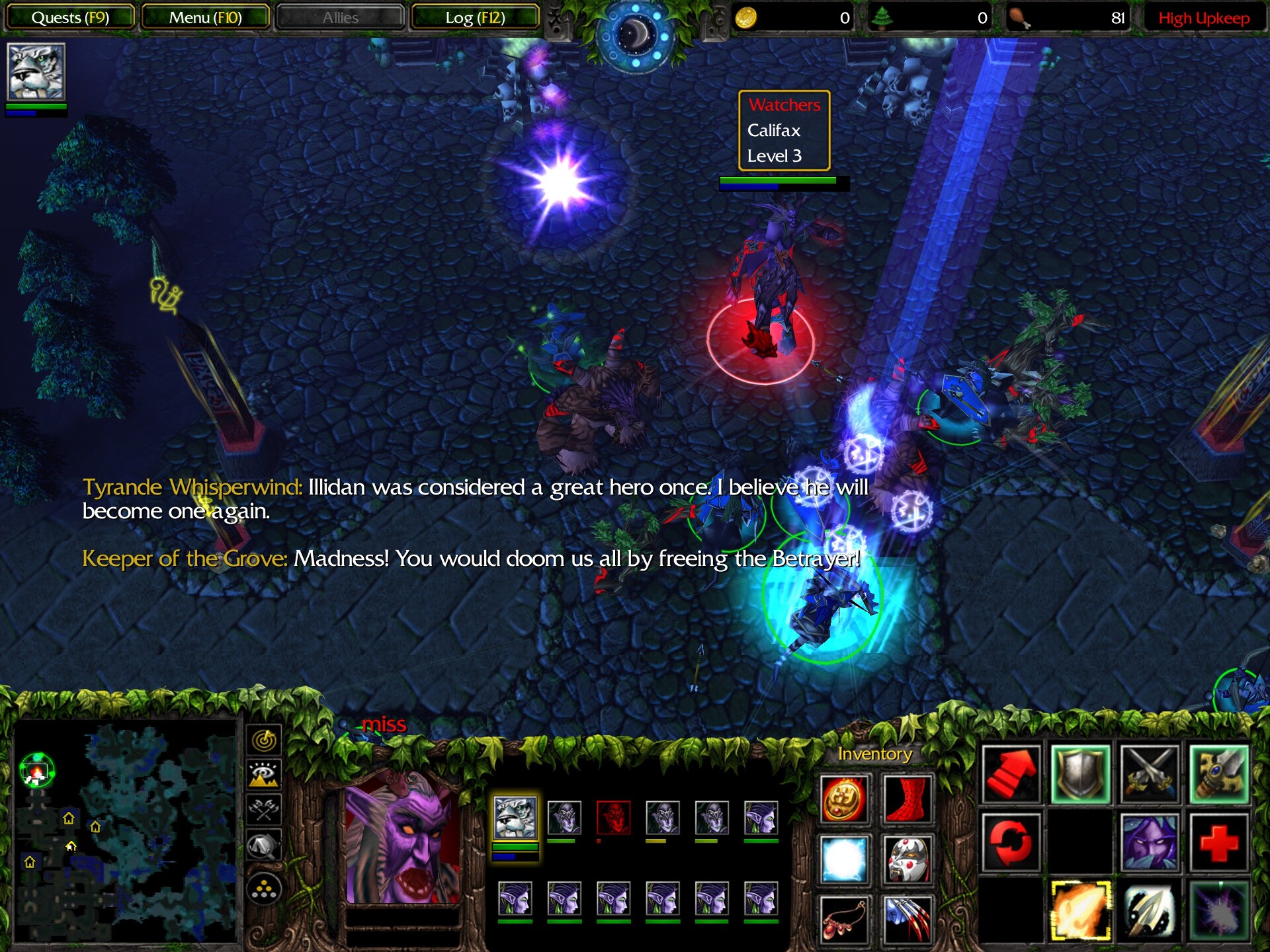
This feels like a bizarro episode and almost nothing seen here comes up again.8 I wonder if we were originally supposed to fight some kind of renegade night elf faction, maybe a secret group of Highborne who hid from their forest-dwelling kin underground, but the developers ran out of time and filled the dungeon with generic and cut units instead.
Tyrande finally reaches Illidan’s cell…
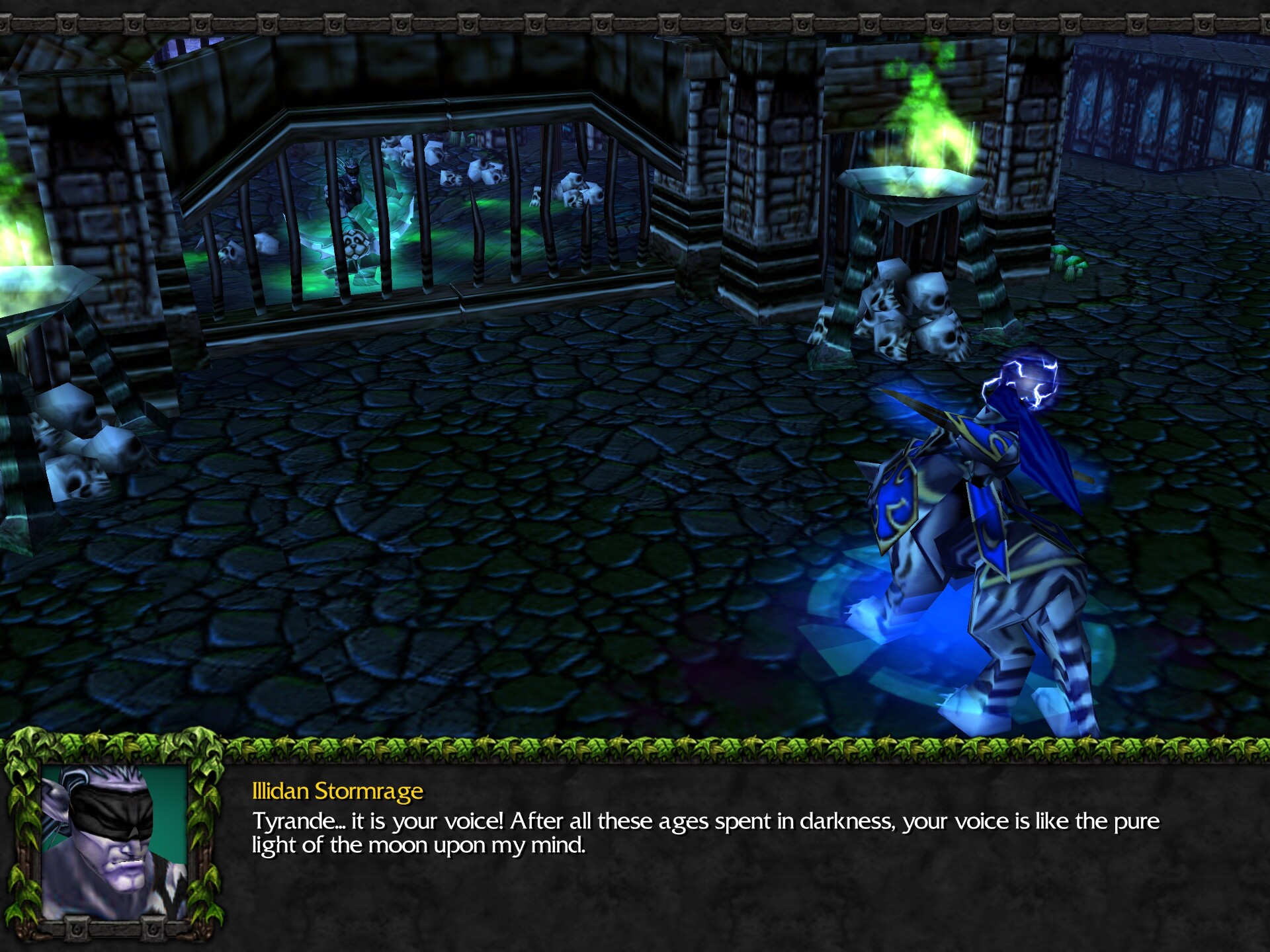
And… I’m sorry, every time he appears on screen or opens his mouth in Warcraft 3, he just cracks me up. I can’t help but think of this.
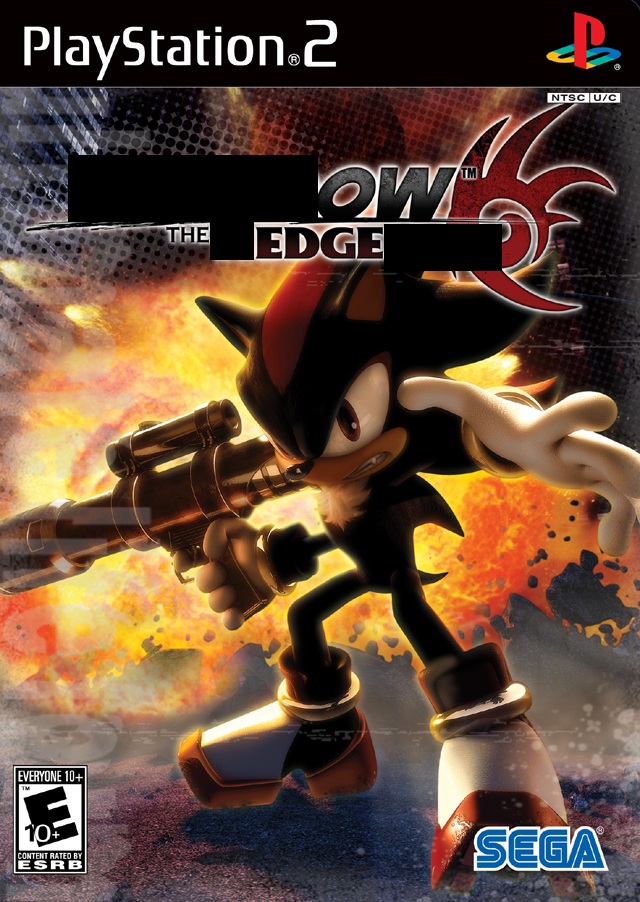
He looks and acts like someone had an idea of a “cool” character, but way overdid it and ended up with a delinquent 14-year-old’s idea of “cool” instead. He’s tattooed out the wazoo, goes barechested, wears a blindfold, wields double crescent glaives and is constantly making some kind of acrobatic movements while idle. He does admittedly provide a very stark contrast with mainstream night elf aesthetics, establishing him as an outcast from the first seconds you see him on screen.
When he hears that the Burning Legion has returned and his people have need of him once again, he effortlessly breaks out of his cell, and the two brothers have a very much non-cordial reunion.
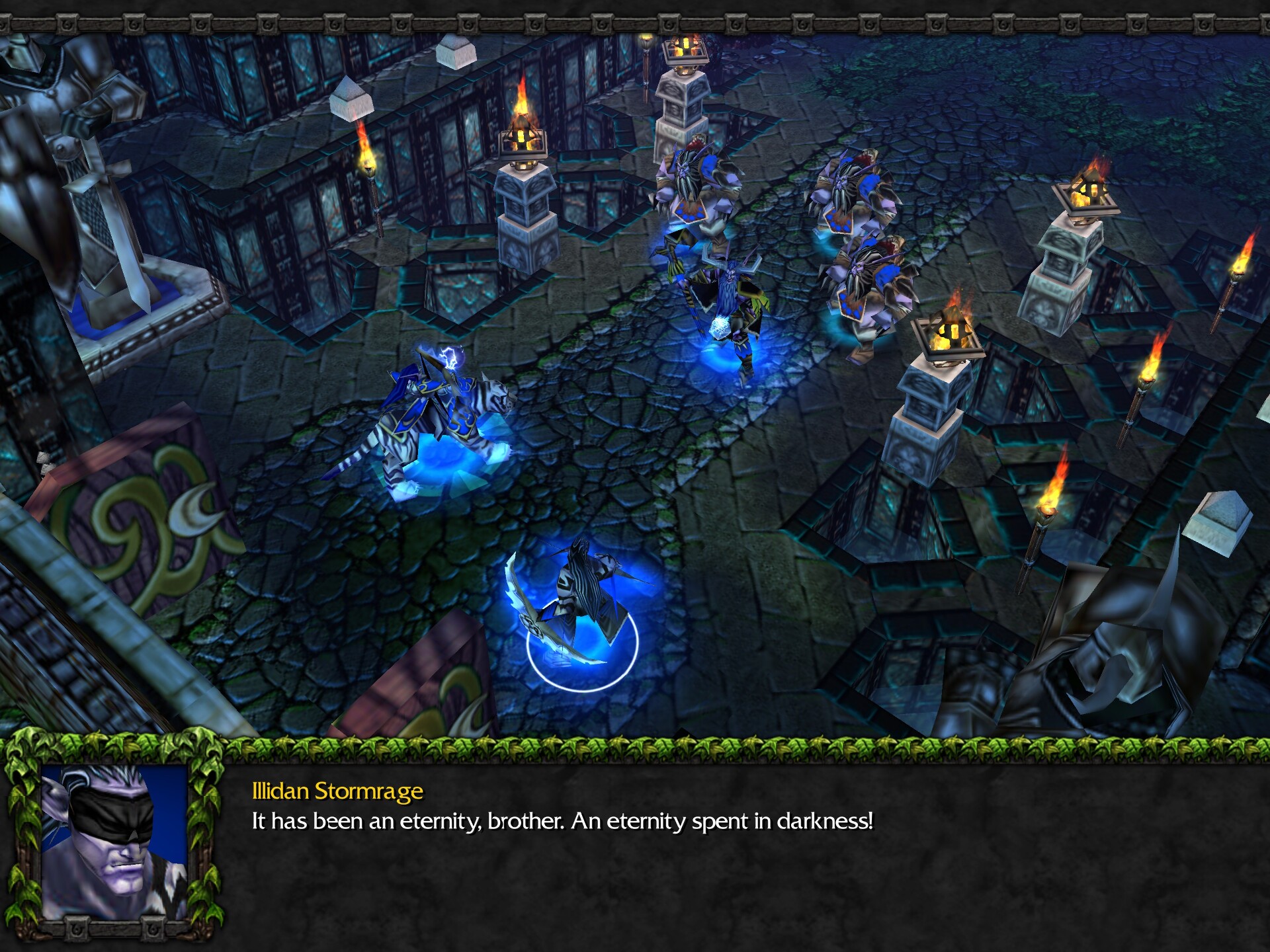
Furion says that he was “only” sentenced to pay for his sins, nothing more. Tyrande shuts down their angry banter, saying that Illidan will help them drive the demons back, but Furion asks if she has considered the cost. He will have nothing to do with this.
And I like it! It’s a nice reversal of their regular dynamic. Tyrande, usually the unforgiving one, is in favor of cooperation for pragmatic reasons. Furion, usually the softer and more diplomatic one, can entertain the notion of allying with complete strangers, but can’t forgive his own brother for a deed committed ten thousand years ago. This establishes him as a person with flaws and an occasional harsh streak, rather than an infallible saintly goody-two-shoes.
Later Warcraft writers could learn from this.
A Destiny of Flame and Sorrow

Illidan is talking to himself.
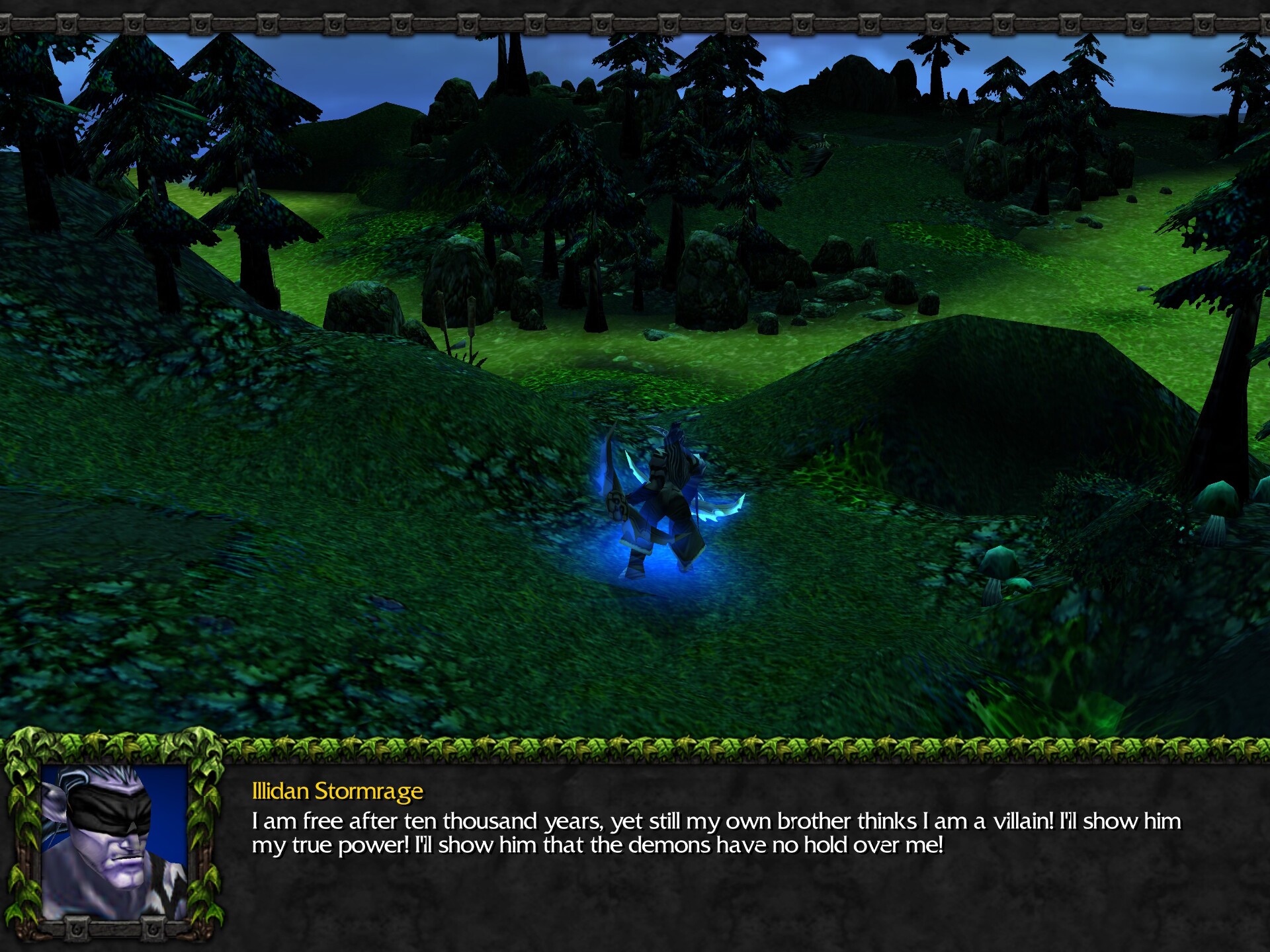
Suddenly, his soliloquy is interrupted by… Arthas?!
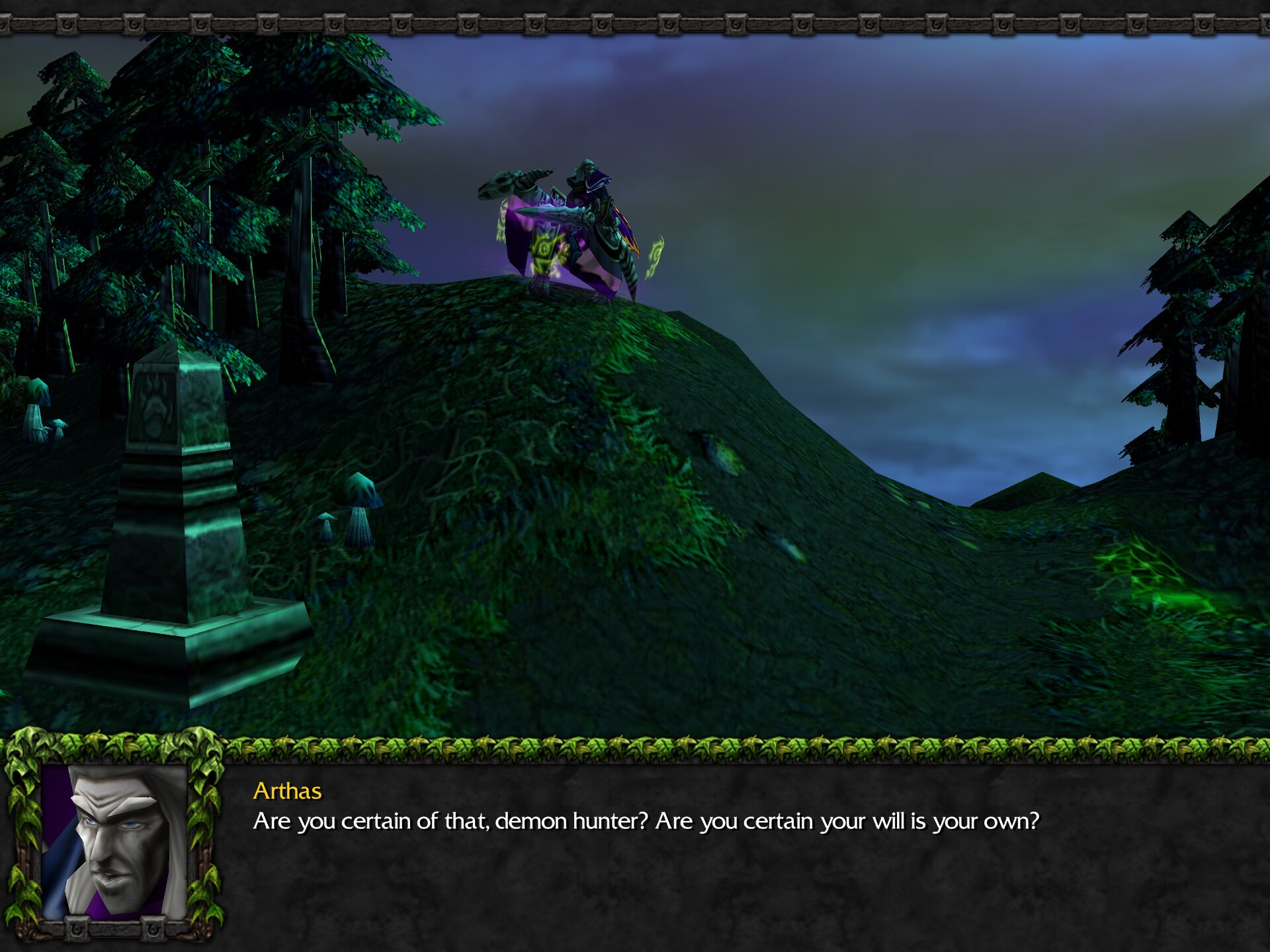
How is this even possible? Yes, the Burning Legion took undead with them to Kalimdor, and they evidently possess the ability to teleport across the world, but I assumed they only took forces loyal to them. Arthas is on Team Lich King, and Tichondrius and company know this. I just assumed both he and Kel’Thuzad stayed back in Lordaeron, and neither of them have been shown to have the ability to teleport across continents. (And if they did, as we’ll later see, it would come very useful in the expansion, short-circuiting the plot.)
I’m not saying the game should have explained this, but it comes completely out of the blue. If anything, showing Arthas’s silhouette in the shadows, watching, at the end of one of the previous Kalimdor missions would have helped.
Illidan tries to repel the intruder with — of course — violence. Arthas says he’ll find out they’re evenly matched — so I’ll assume he knows who Illidan is. Somehow.
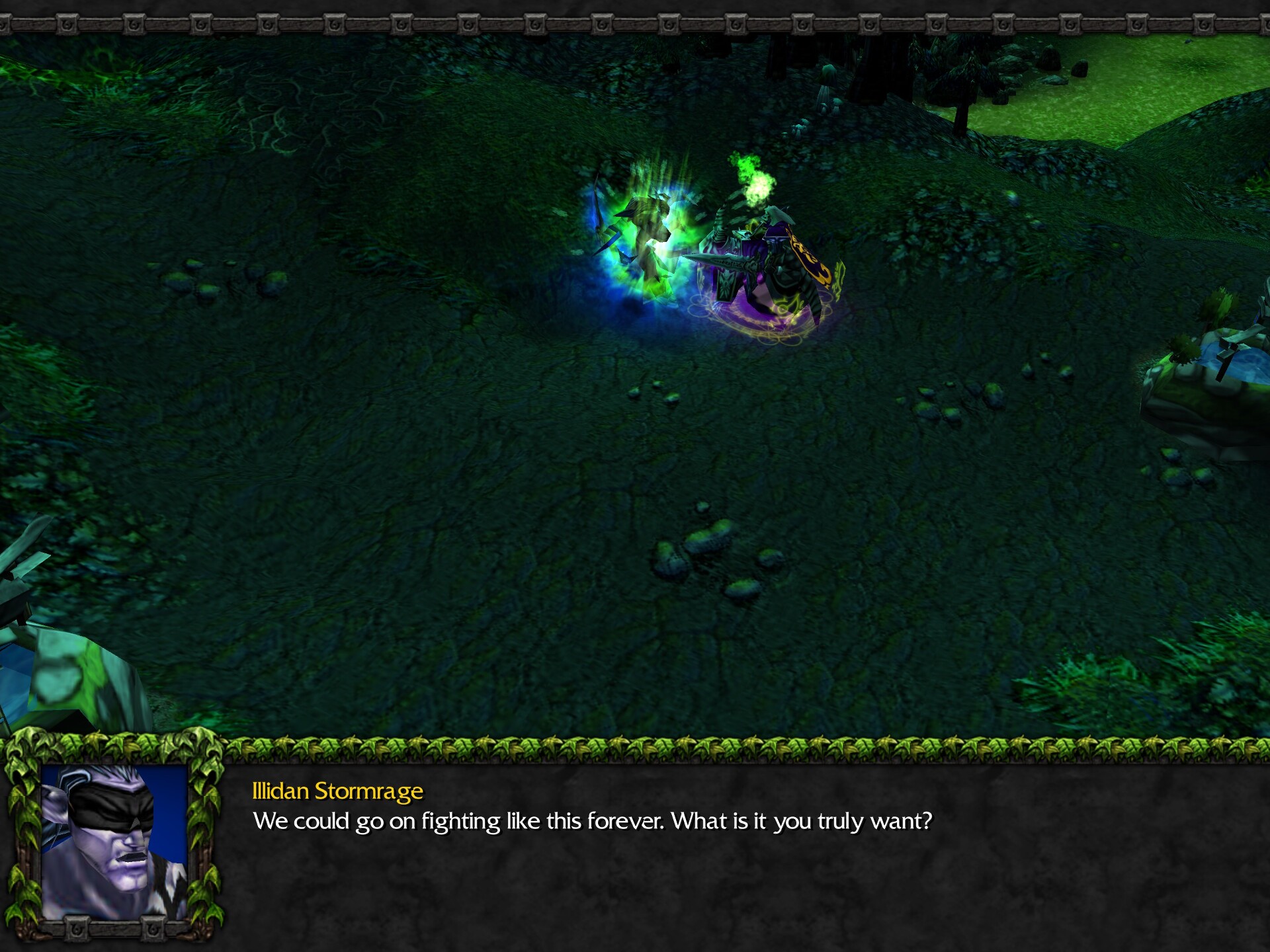
And Arthas reveals what he wants — by talking while still fighting.
The demons are corrupting the forest with the help of an artifact called the Skull of Gul’dan. Arthas wants Illidan to steal it, to the latter’s confusion.
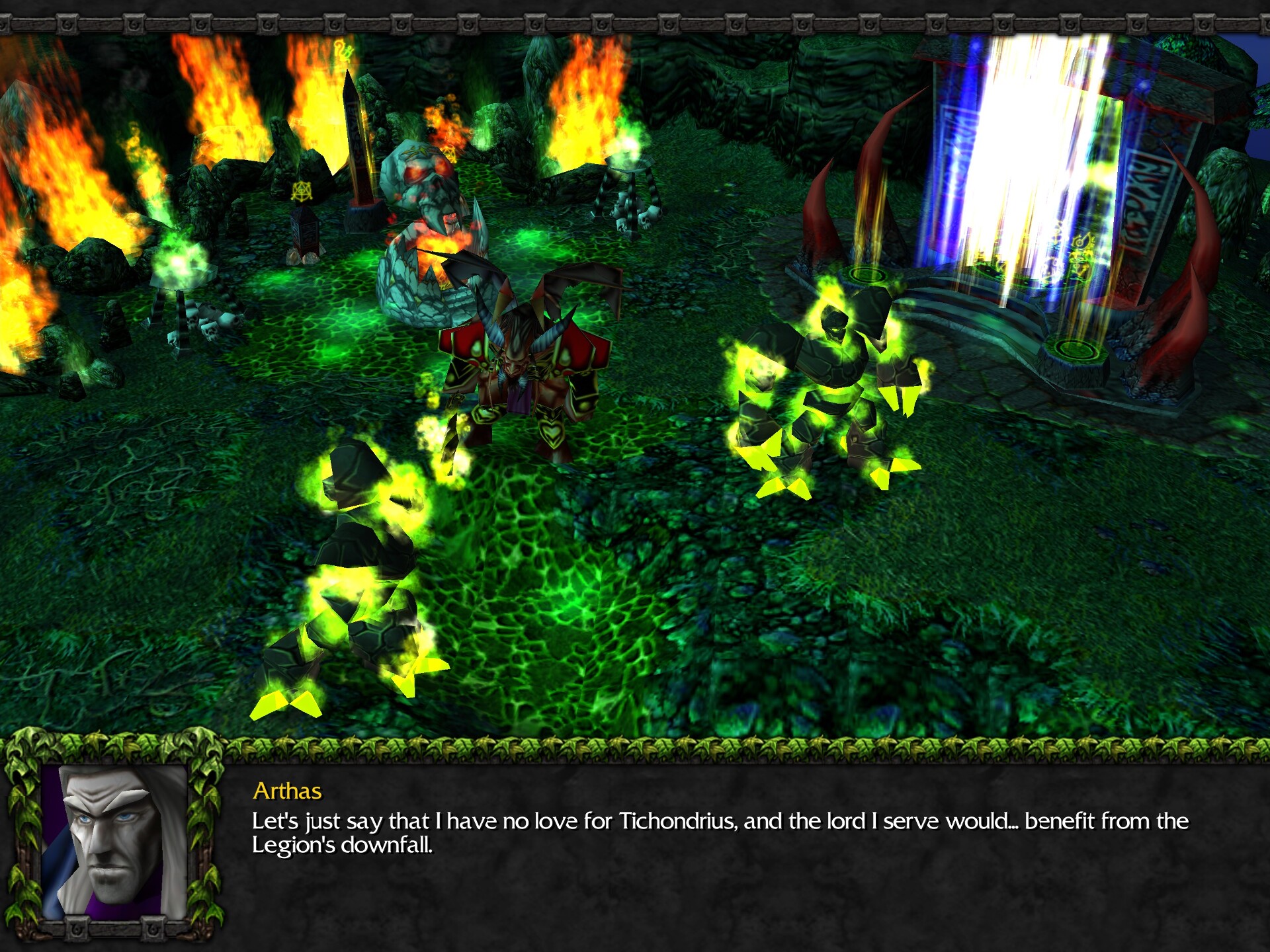
And yes, it turns out that Arthas’s master does know who Illidan is, and that he’s sought power his entire life. Now, through Arthas, the Lich King is tempting Illidan with the power of the Skull. Should he seize it, his enemies will be undone.
Which is all well and good, but… how did the Legion get the Skull?
Last time we saw it, it clattered on the ground on Draenor after Khadgar used it to absolutely certainly for good seal the Dark Portal from that world’s side. Then the Alliance Expedition left through one of Ner’zhul’s portals just before Draenor exploded. For all intents and purposes, the Skull of Gul’dan, if it’s even still intact, should be floating somewhere out there in the Great Dark Beyond alongside Draenor’s debris.
How did the Legion recover it? And what makes the skull of a mortal warlock so special compared to body parts of actual demons?
Whatever. The mission begins.
Compared to the previous two missions, which had lots of objectives and lots of scripted events, this one is very straightforward. Build a base, build an army, fight through everything, take the skull. Our enemies here are corrupted ancients, satyrs, and demons. But there are a few nuances here worth mentioning.
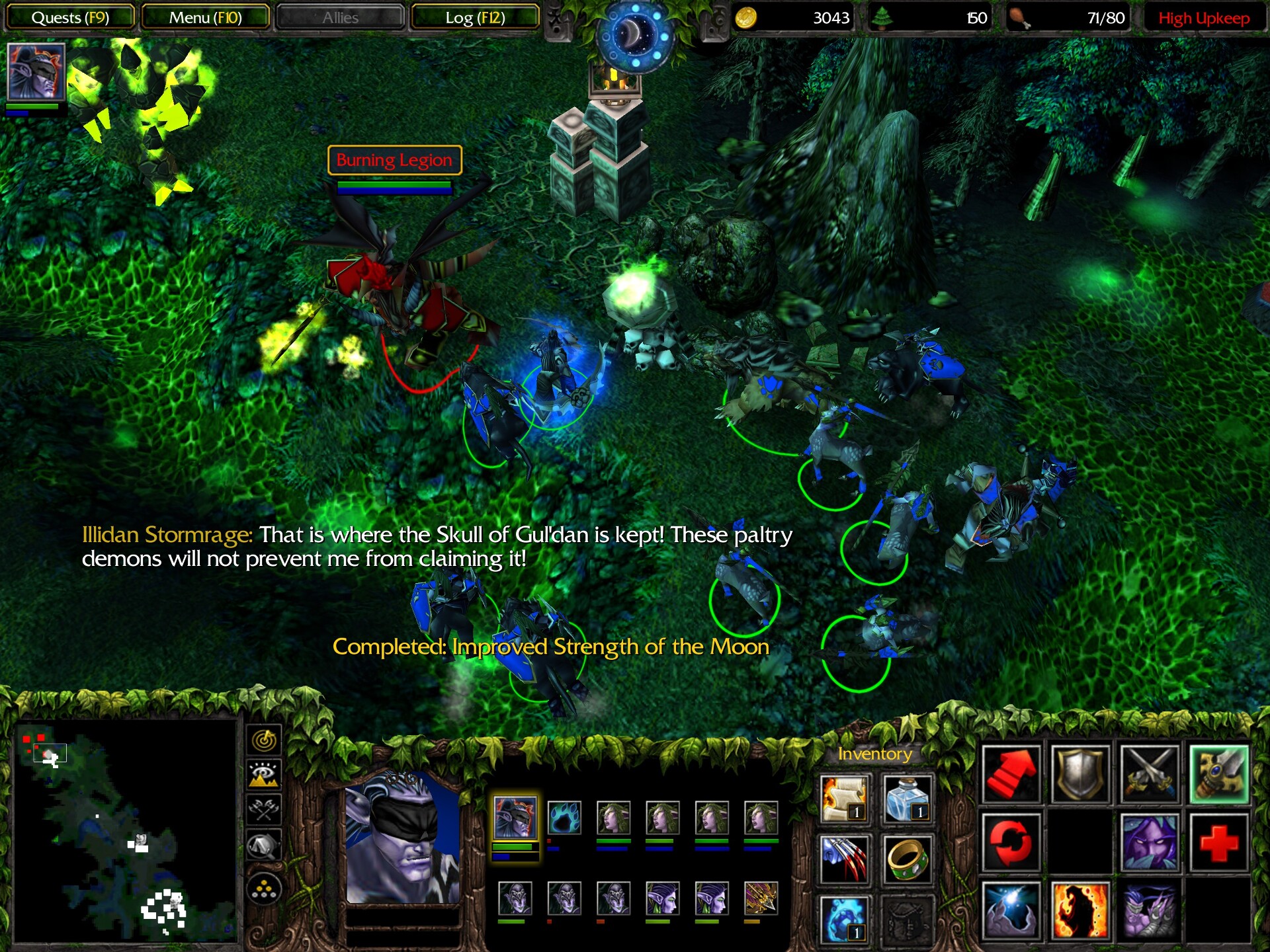
Tyrande and Furion are sitting this one out (actually they’re probably busy elsewhere). We control Illidan, a demon hunter — a very edgy agility hero. He has a passive chance of evading enemy attacks, and his active abilities are Mana Burn, which drains mana from a spellcaster at the expense of the demon hunter’s own mana, and Immolation, which activates a fiery shield that damages nearby enemies, at the cost of steadily draining the caster’s mana.
We also unlock the druids of the claw. These guys are versatile and very useful as both tanks and healers, thought not both at once. In caster form they can cast Roar, which gives nearby allies a whopping 25% boost to damage for 45 seconds, and Rejuvenation, which heals a single ally over time. In bear form, they can’t cast either of these, but become bulky and tanky damage sponges on par with the heavy melee units of the other races.
The map design here is also interesting. As far as I can tell, one of the purposes of this mission is to teach the player the value of building expansions9, which will be pretty much mandatory for the final mission. While on hard mode, the player is likely to have used expansions already, on normal mode they’re optional and it’s possible to get this far without making use of more than one gold mine at once. This map is built in such a way that no matter where you go from your base, you will come upon a gold mine — one almost unguarded and two used by enemy bases. They’re practically begging to be used, so why not, indeed, use them?
We destroy the demon gate near the Skull of Gul’dan, and Illidan approaches it.
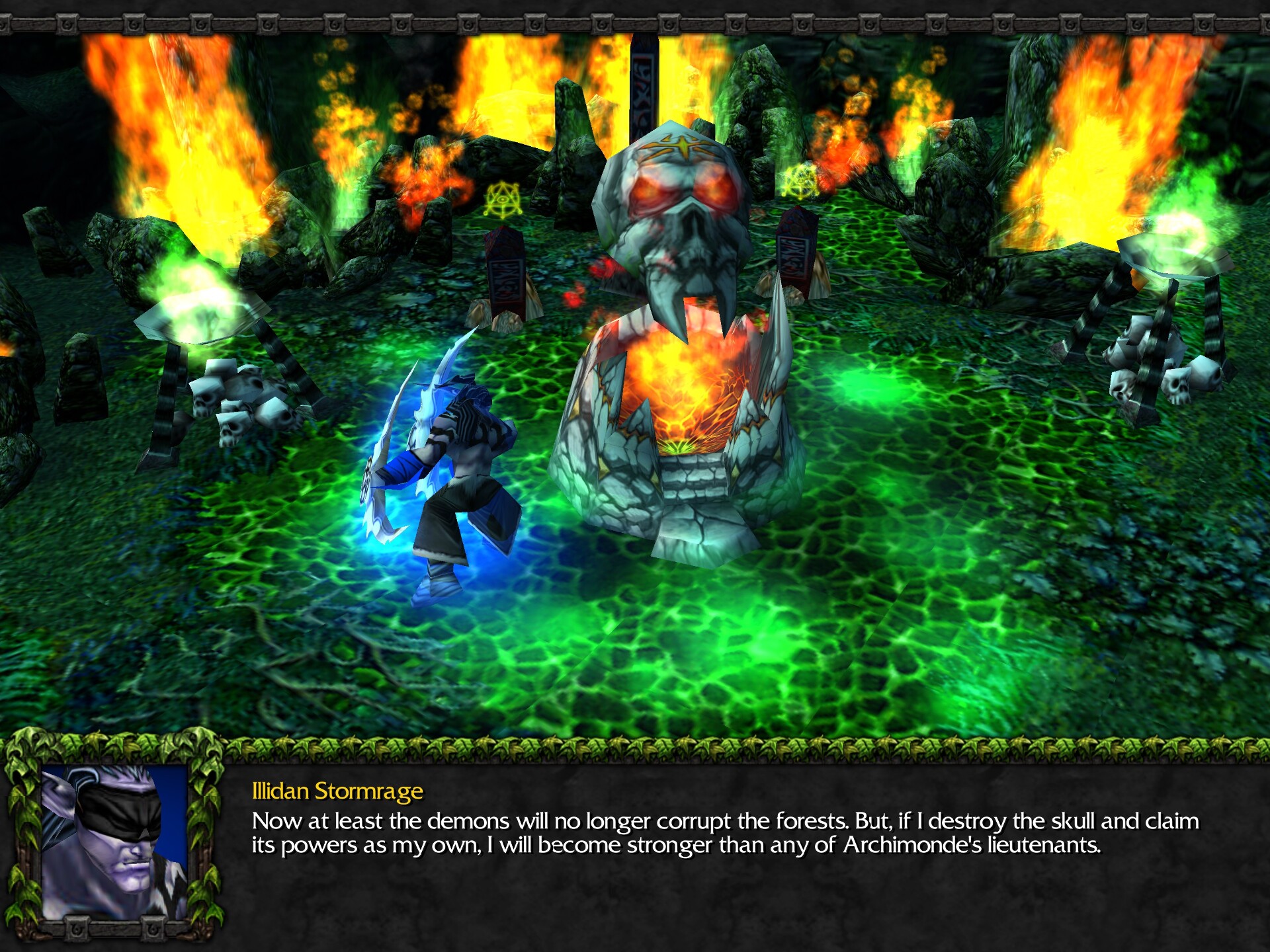
This is the part where the hero intends to claim a cursed source of power. We’ve seen this with Arthas versus Mal’Ganis and with Grom versus Cenarius. Both were offered a last-minute chance to reconsider by their less unhinged and more doubtful allies. Both rejected it.
Illidan decides to claim the Skull’s powers for himself. Any moment now, some concerned night elf is going to object to this plan.
…Aaaany moment now.
Nobody? Well then.
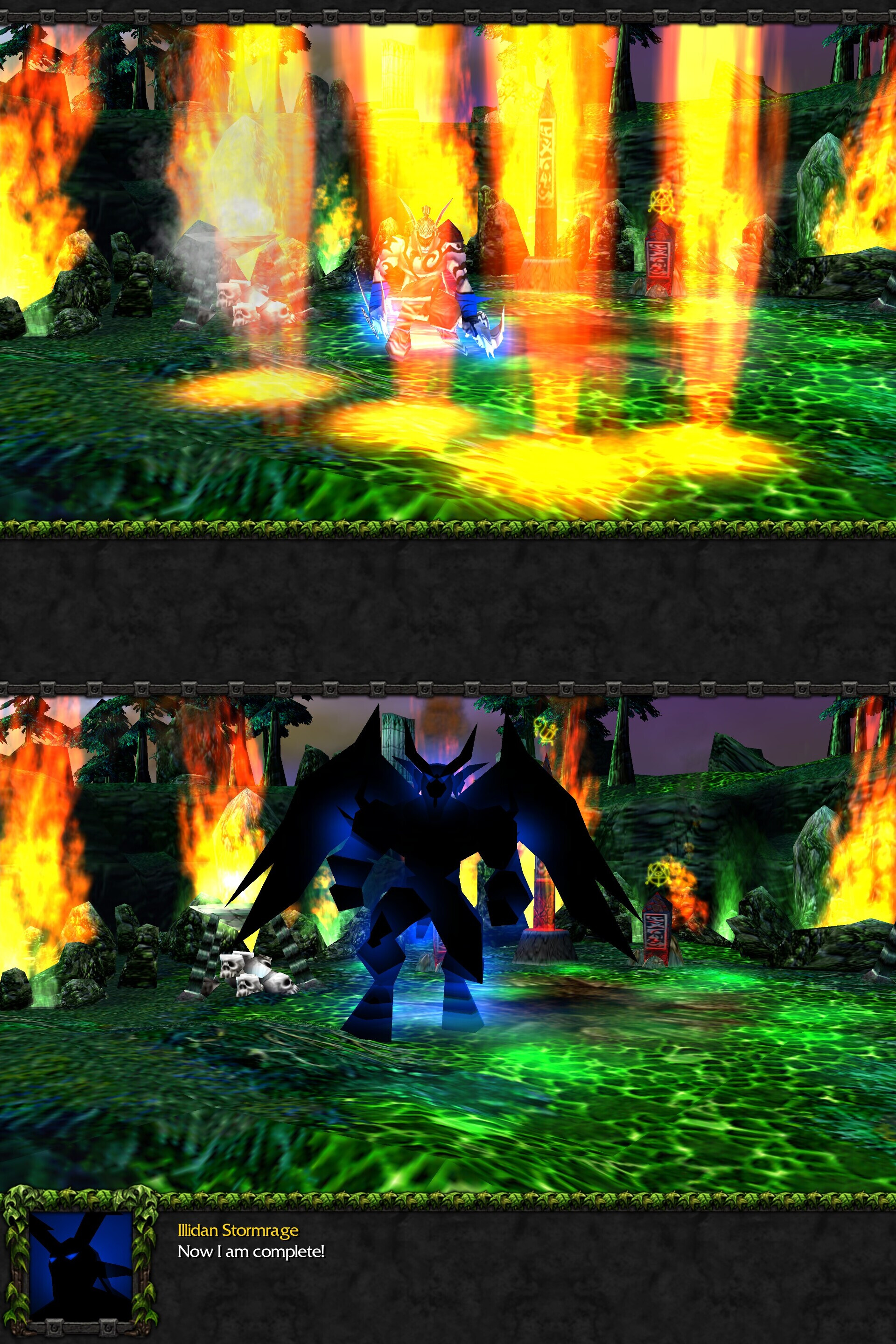
Illidan consumes the Skull and is transformed, becoming a one-man army with — of course! — Chaos damage. For a regular demon hunter hero, this ability, Metamorphosis, lasts for 45 seconds with a three-minute cooldown. Illidan gains this form permanently, at least for the remainder of this mission. Now he’s more than equipped to destroy Tichondrius–
Our sacred grove is being desecrated!
…But meanwhile, the satyrs are getting persistent in their attacks on my expansion. So I take out their base (whose defenses include a Skeleton King) with my army led by a supercharged Illidan, before heading to the corner of the map where Tichondrius patiently waits in a company of doomguards and infernals. Only Illidan can damage Tichondrius, and he tears through the poor dreadlord in a matter of seconds while his army distracts the rest of the demons. Mission complete.
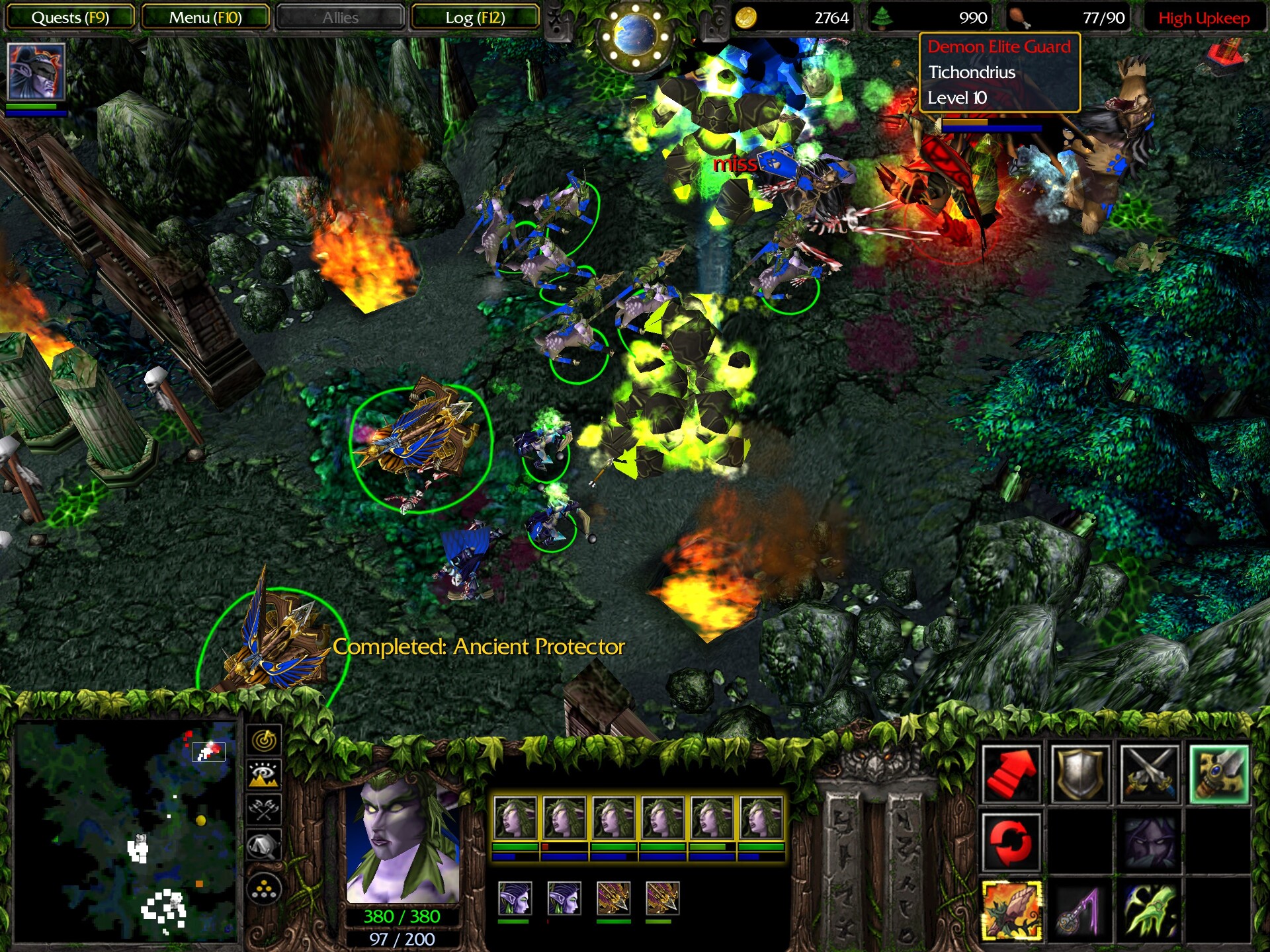
Tichondrius, the strategist behind the Legion’s invasion plans, is dead, which throws a second wrench into their plans after the death of Mannoroth, their heaviest hitter. The forest is saved and will heal in time. You’d think Illidan would be hailed and praised, but instead, Furion is furious.10
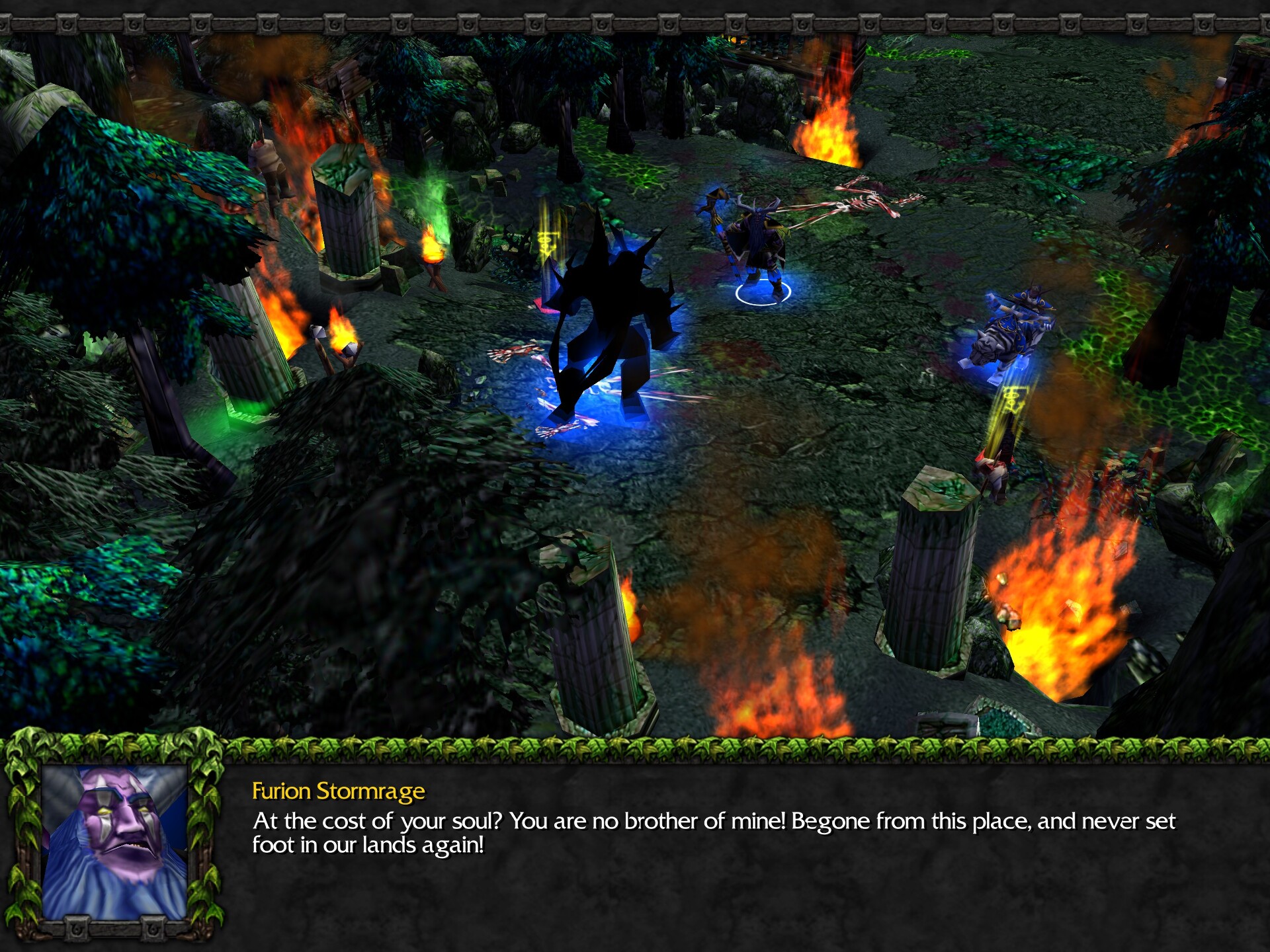
“So be it… brother,” says Illidan and leaves. Once again Furion falls victim to his unwillingness to let go of his prejudices against Illidan specifically, and it will be interesting to see what it will cost him — and others.
We’ve almost reached the climactic finale of Reign of Chaos. Before that, however, there’s something I’d like to point out.
This is now the third time throughout Warcraft 3 that a character has accepted a cursed source of power to beat a seemingly unbeatable enemy. All three times, it was part of someone else’s long game. Arthas fell into the Lich King’s trap specifically designed to corrupt him, with Mal’Ganis playing the bait. Grom was the Legion’s pawn for getting rid of Cenarius before the invasion proper began. Now Illidan was used by the Lich King, with Arthas as his messenger, to weaken the Legion before the assault on the World Tree, as part of a more long-term plan to break free from its hold over the Scourge.
With Arthas and Grom, the author intent was obvious. By taking in their respective curses, they became their schemers’ slaves. The message was clear: it’s not worth damning yourself, even to do the otherwise impossible.
But Illidan, by all appearances, is still himself. He retained his sanity. He’s not a slave to the demons, in fact he’s still opposed to them. It’s Furion who’s in the wrong here by pushing away a willing and powerful ally — and his own brother, to boot. So the message here seems to be “power is just that, power, what matters is the ends for which you use it”.
And both of these messages are fine! There are popular and well-written fantasy works that have used both of them. But having both of them present in a single work sends a weird mixed message and ends up not really saying anything. Is the intended moral supposed to be “cursed power will corrupt and enslave you, unless you’re the right kind of person to handle it, in which case go right ahead”?
Ehh. I’m not sure the writers even thought about it that much. It’s not fatal to the story now, but later, as the Warcraft setting develops, the inability to take one of these two messages and stick to it will harm its worldbuilding in the long run.
The Last Guardian
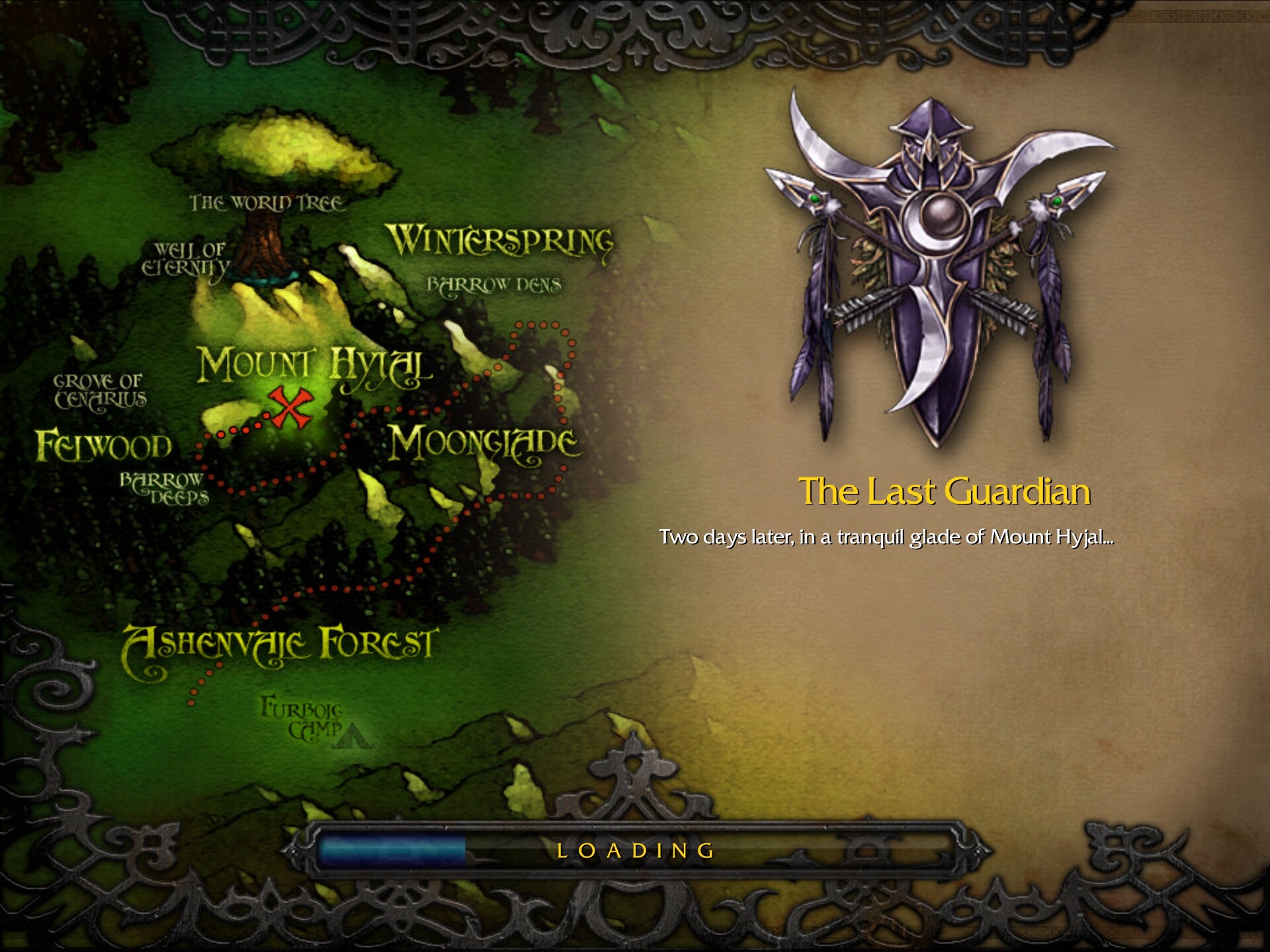
A raven — or should I say, the Prophet in raven form — is soaring over the waterfalls of Mount Hyjal while Tyrande and Furion are arguing.
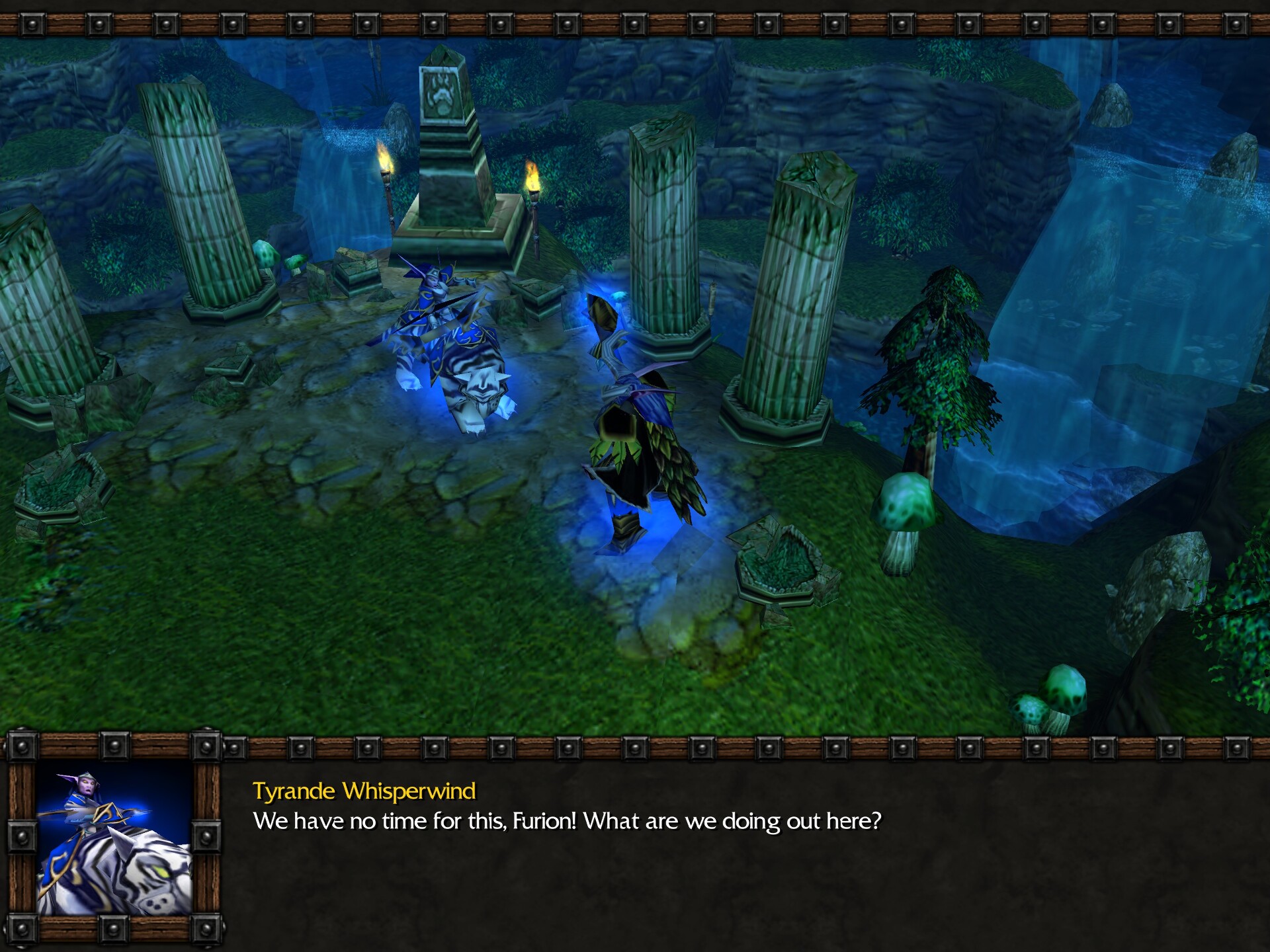
Turns out that last night in a dream, a raven spoke to Furion and summoned him to this place. Thrall and Jaina were also summoned, and introduce themselves. Inexplicably, they can all understand each other without any language barriers getting in the way.
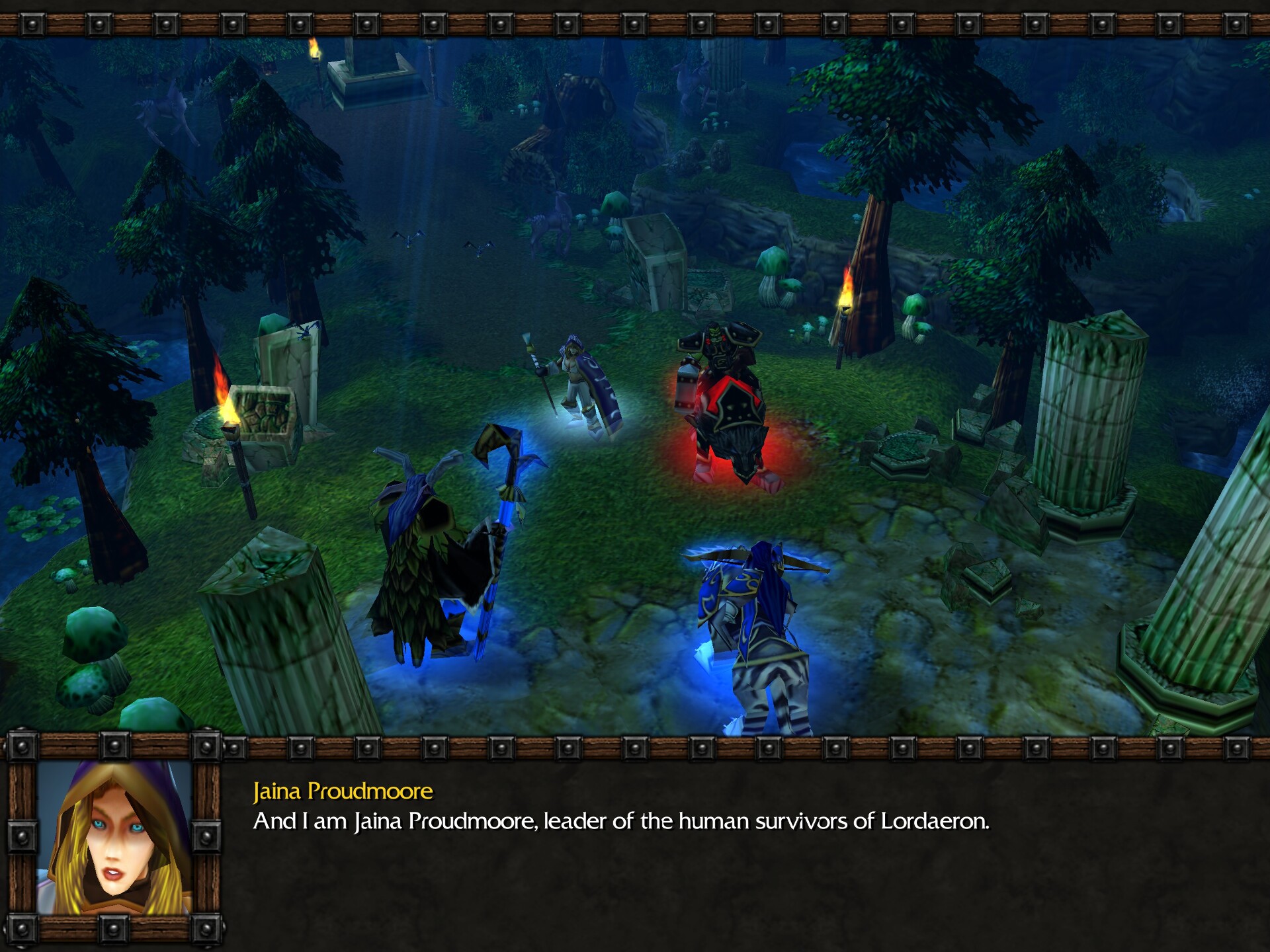
Tyrande says they’re not welcome here, but then the Prophet descends, assumes his real form, and says that he was the one who summoned them all here to unite against the Legion. Furion, very reasonably, for the first time in the entire story asks him the important question: who is he? And the Prophet, at long last, gives an answer.
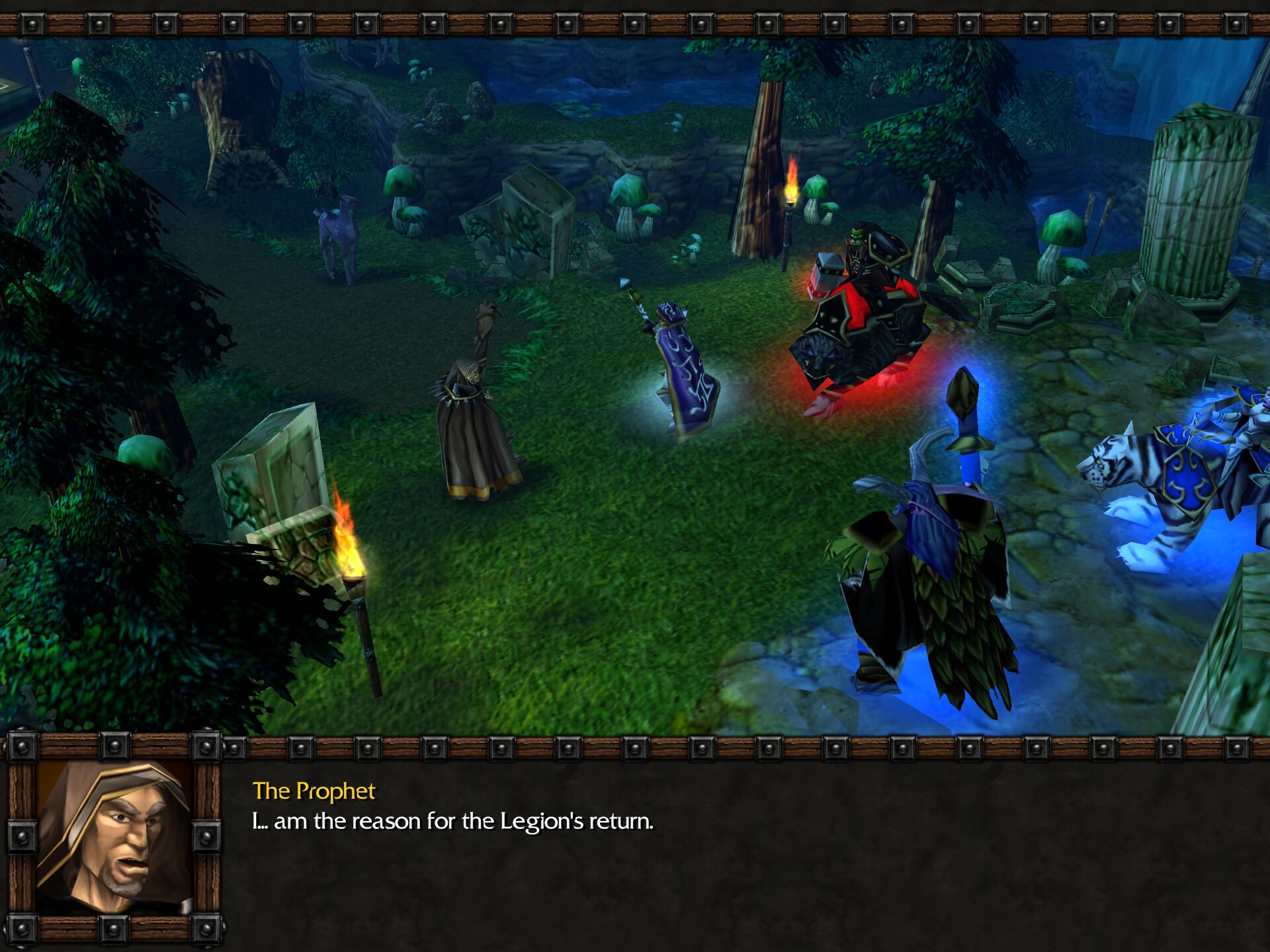
This is our “talking to Vigil on Ilos before pursuing Saren” moment: the final calm before the climactic confrontation, where questions are answered and the conflict properly contextualized. The Prophet explains everything. The entire history of the conflict, in a manner easy to understand, bringing up to speed players who didn’t play the previous games, and making people who read The Last Guardian say “I knew it!”
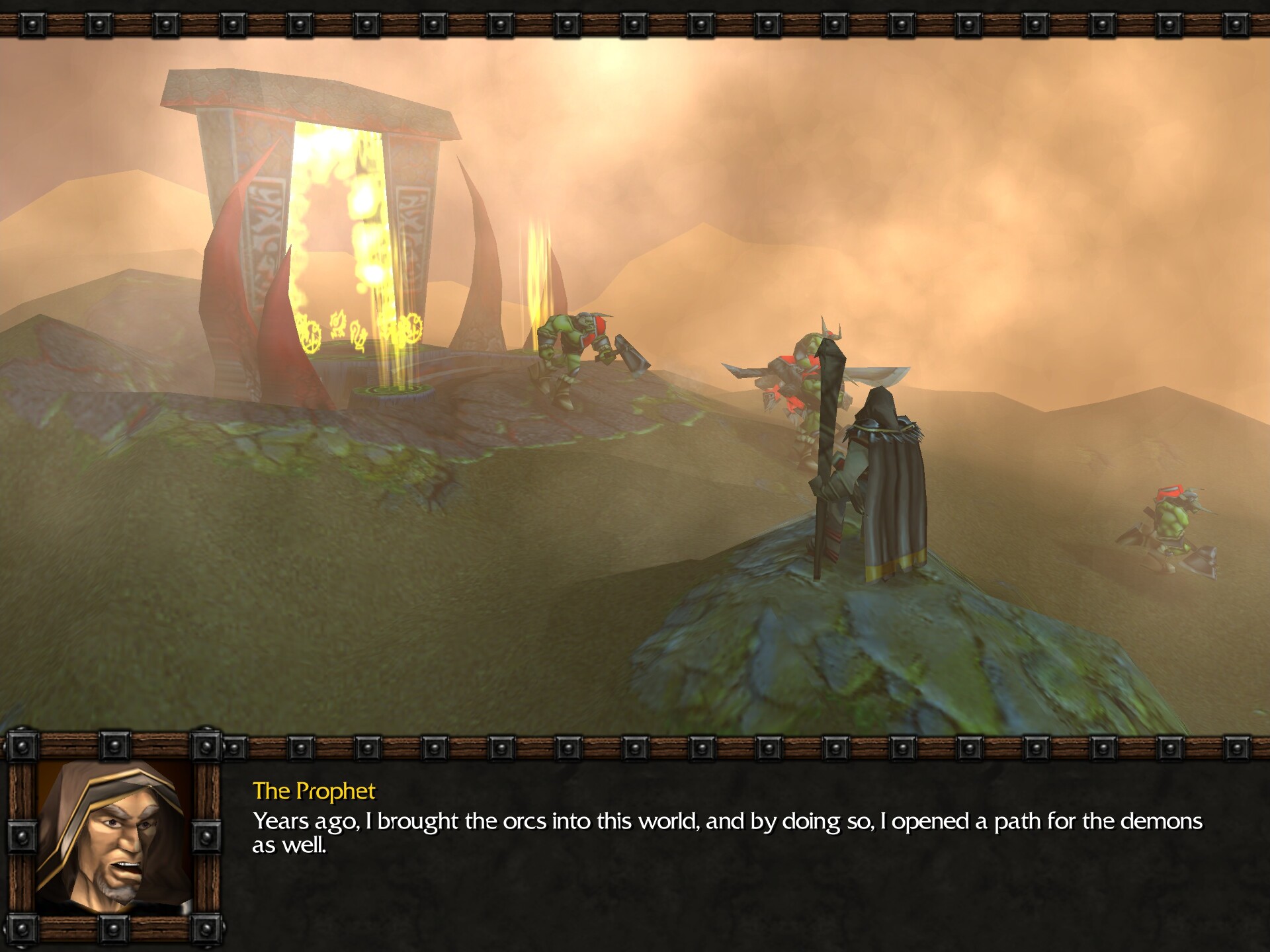
The Prophet is Medivh, the Last Guardian. Years ago, he opened the Dark Portal, and by doing so, paved the way for the orcs — and their demon puppeteers. For this, he was slain by those he cared for most, but despite his death, the war still raged on, leaving entire kingdoms devastated. Now he has returned (somehow) to set things right — by uniting everyone in arms against the enemies of all who live.
As good as this moment is, and as much as I hate to ruin it with my nitpicking, I have questions.
- One: just how did Medivh return? So far we’ve seen no evidence that resurrection is possible in this setting, and every death has been treated as final and permanent.11
- Two: why did his resurrection, however it was accomplished, purge Sargeras’s corruption (or possession) out of his soul?
- Three: why did he think that these cryptic prophecies and convoluted scheme to get everyone to Kalimdor was the best way to save the world? Did he scan all the possible futures and see only this one outcome where they won?
- Four: what motive do Tyrande and Furion have to believe him? As far as they know or care, he’s just another human mage, and now he has outright admitted to them that he was the one who started this entire mess.
- Five: how come nobody recognized him? Why did absolutely nobody, not even Jaina or Antonidas, who really should have known better, comment that this wandering doomsayer looked a lot like the most famous mage in human history whose portrait probably hung in every other classroom in Dalaran?
The Prophet being Medivh, one of the major antagonists of Warcraft 1, was a nice twist back at release — for people who knew or cared who Medivh was, at least.12 It was certainly a good narrative bookend, a redeemed villain returning one last time to make up for the damage he caused. But I feel like it’s the kind of twist that raised more questions than it answered.
Twilight of the Gods
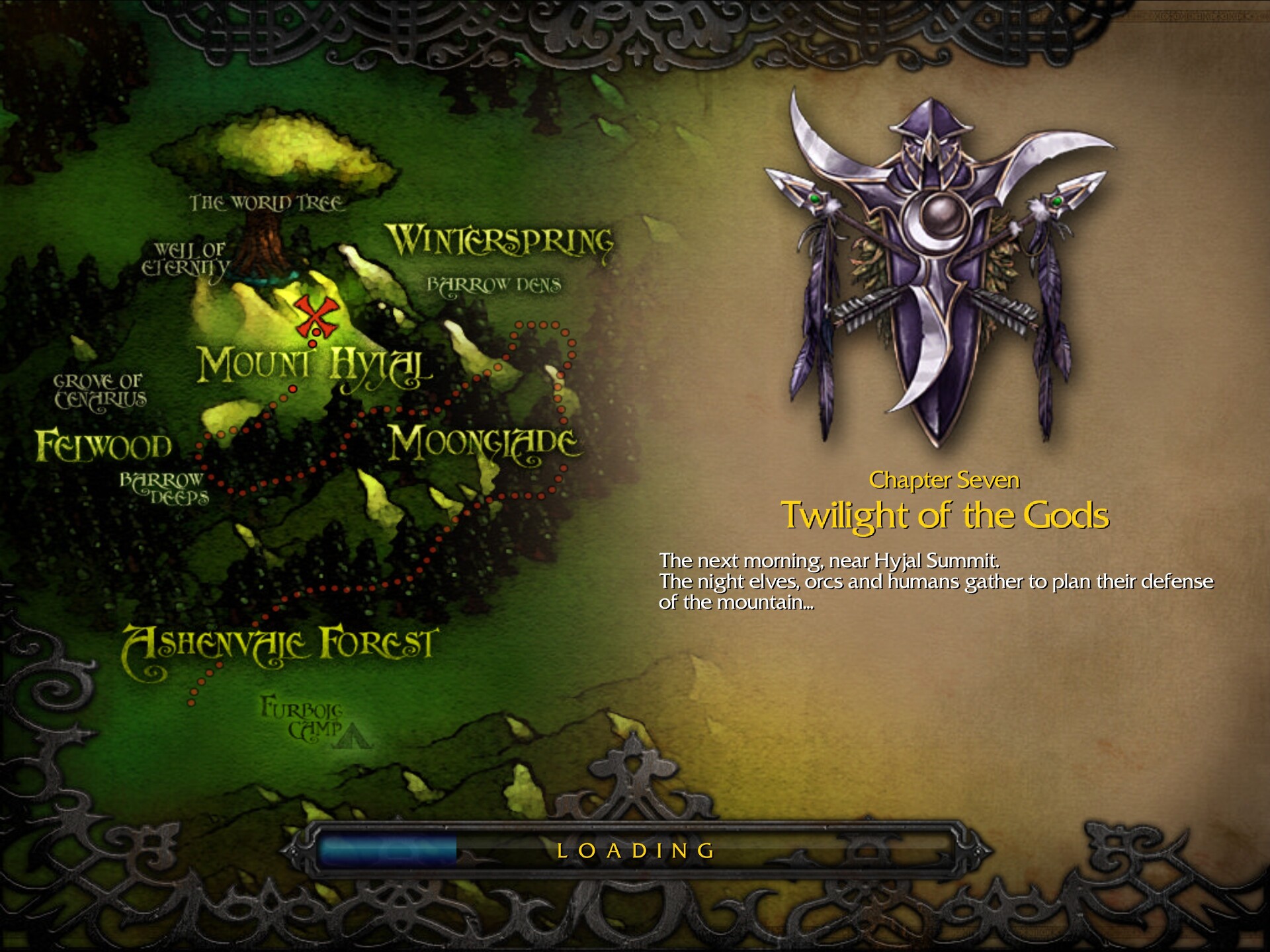
And so it has come to this. Everything, everything so far has led to this pivotal moment — the defense of Mount Hyjal and the World Tree against an advancing demon army led by Archimonde himself.
The heroes gather to discuss the battle plan, and Furion shares a bit of history — and explains to the others their goal.
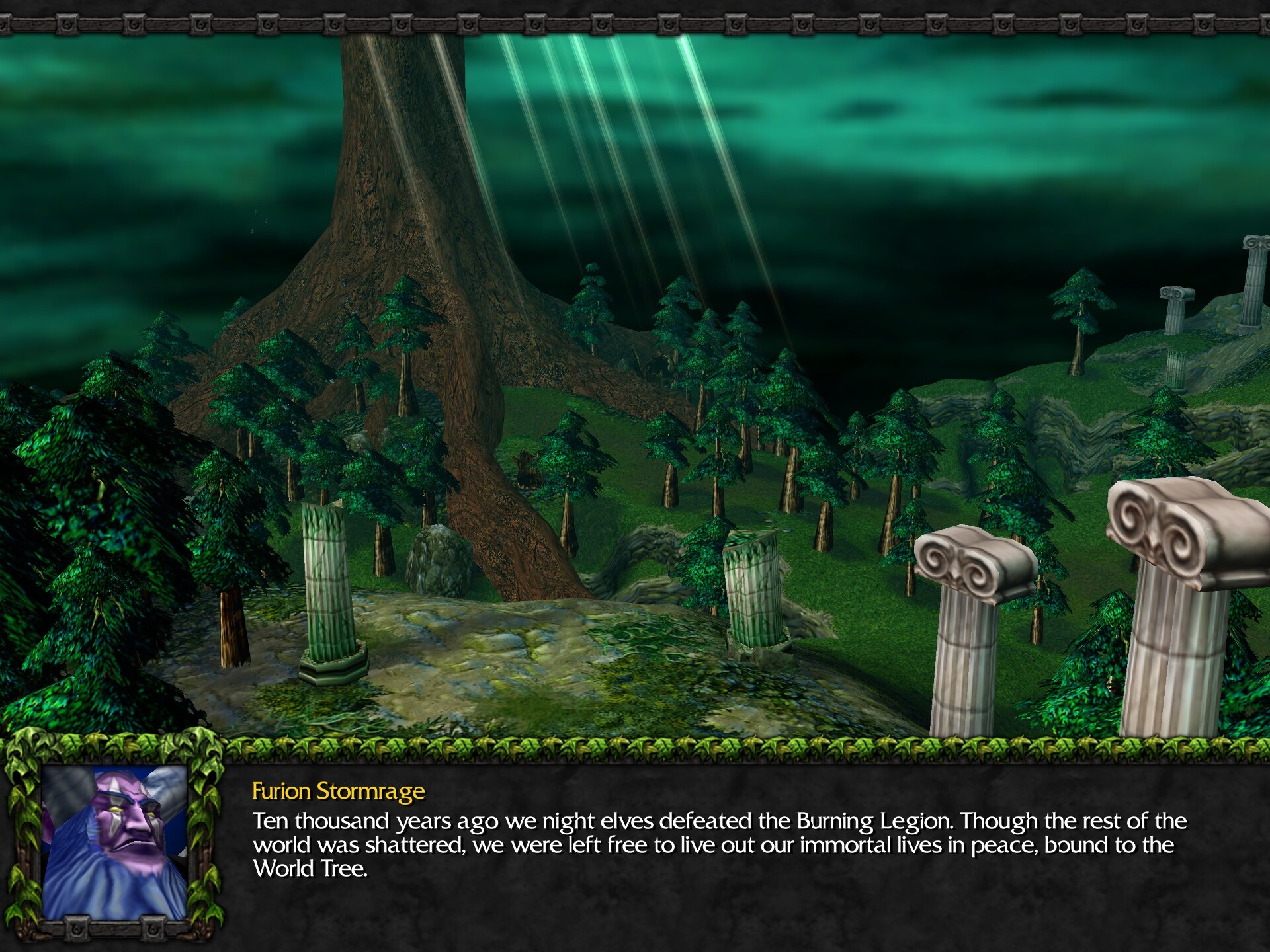
Now it is the time they give that power back. It does mean, as Tyrande notes, that they will age as mortals do, and that their powers over nature will wane over time.13 Furion, however, believes that they might have lived long enough already.
Yes, he’s single-handedly making this decision for the entire race — though in fairness, it’s not like they have many other options.
At this moment, Archimonde appears at the footsteps of the mountain, absolutely chewing the scenery with his evil gloating.
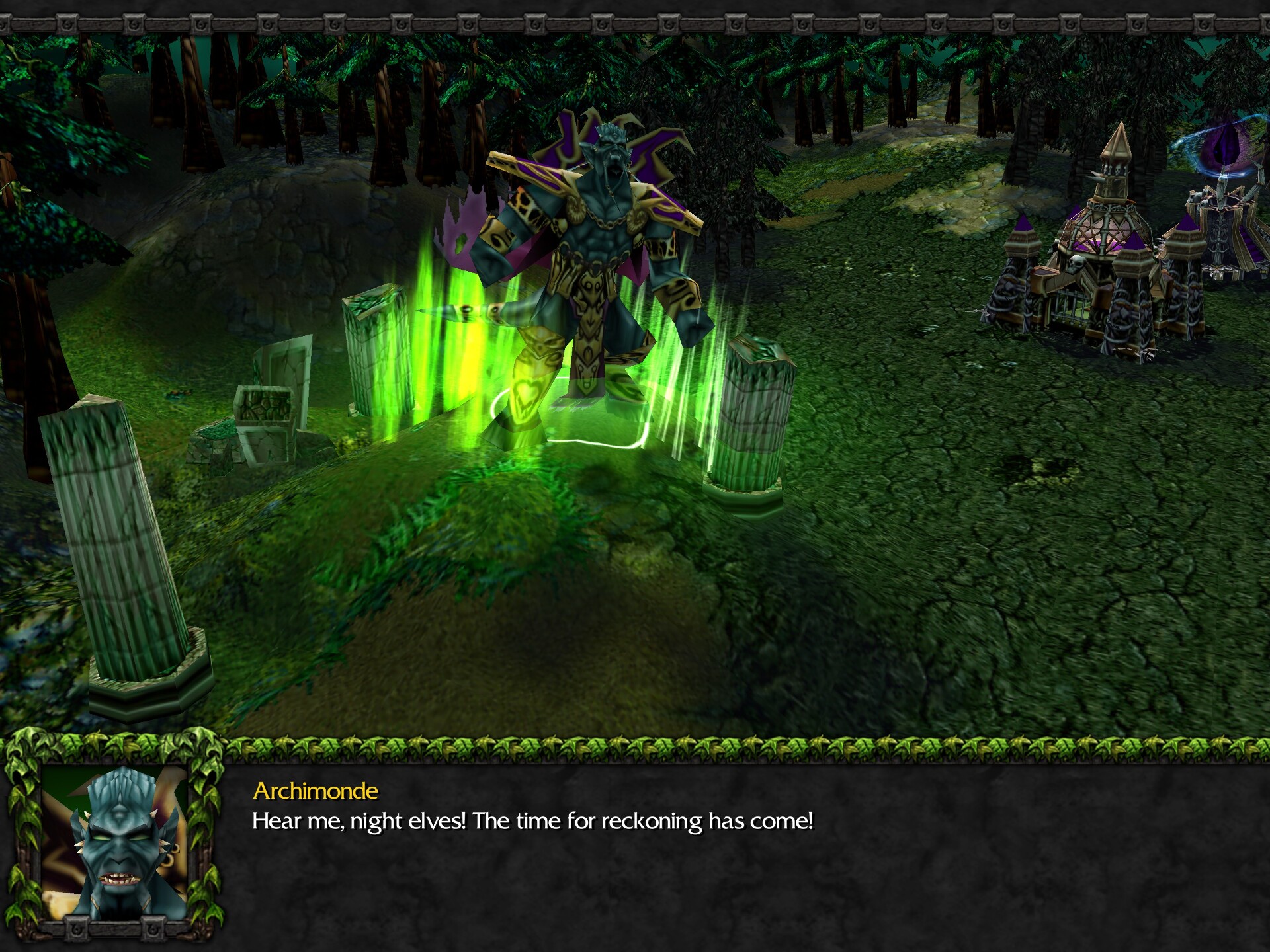
Jaina promises that she and Thrall will delay the invaders for as long as they can if the night elves can provide them with support and keep them from being overwhelmed. This earns her a bit of praise from Tyrande.
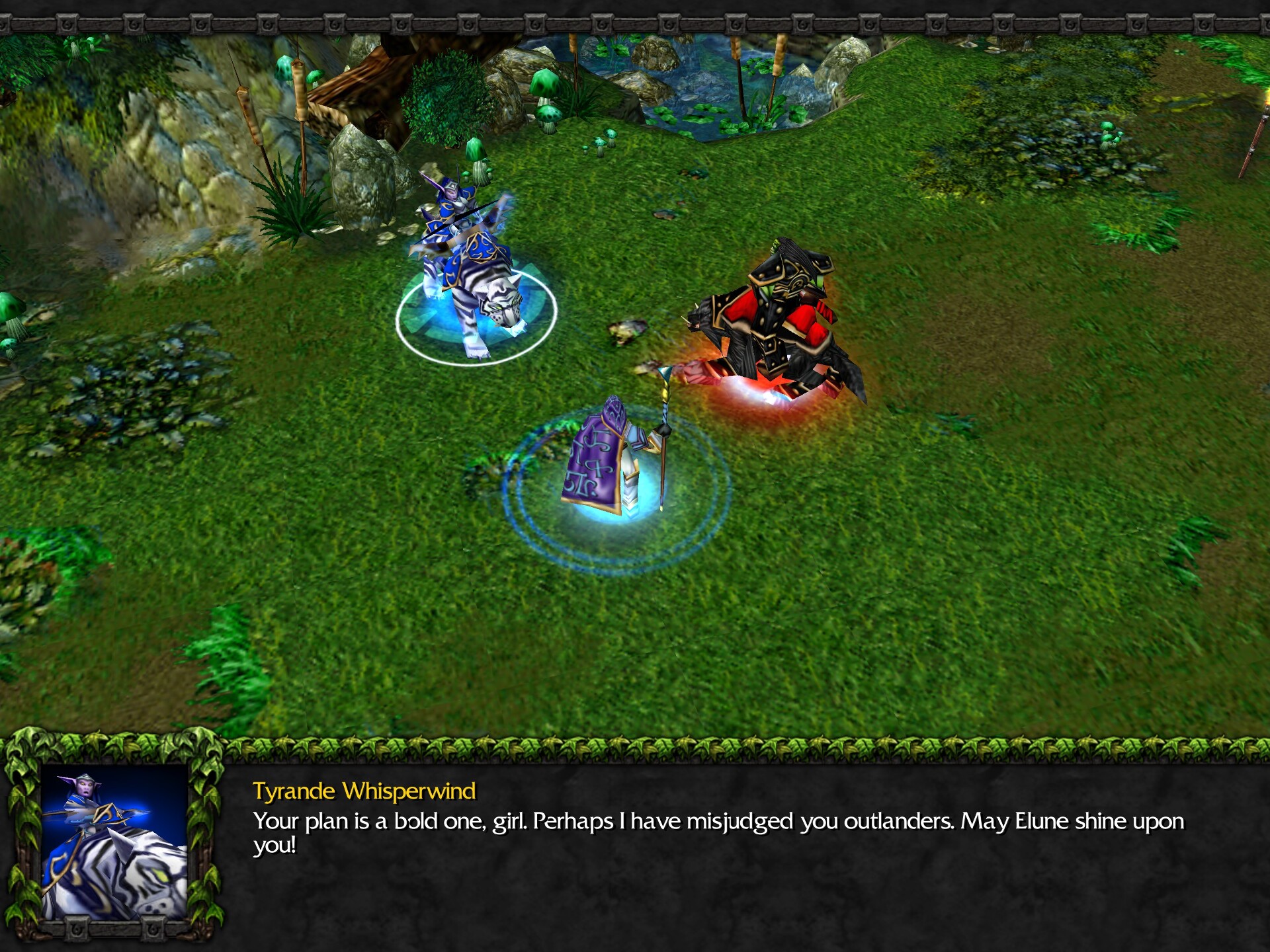
And so begins the campaign finale, where the objective is to hold the line for forty-five minutes. We have both Tyrande and Furion, a fully built base, and two computer allies with fully built bases of their own — and level 10 heroes.
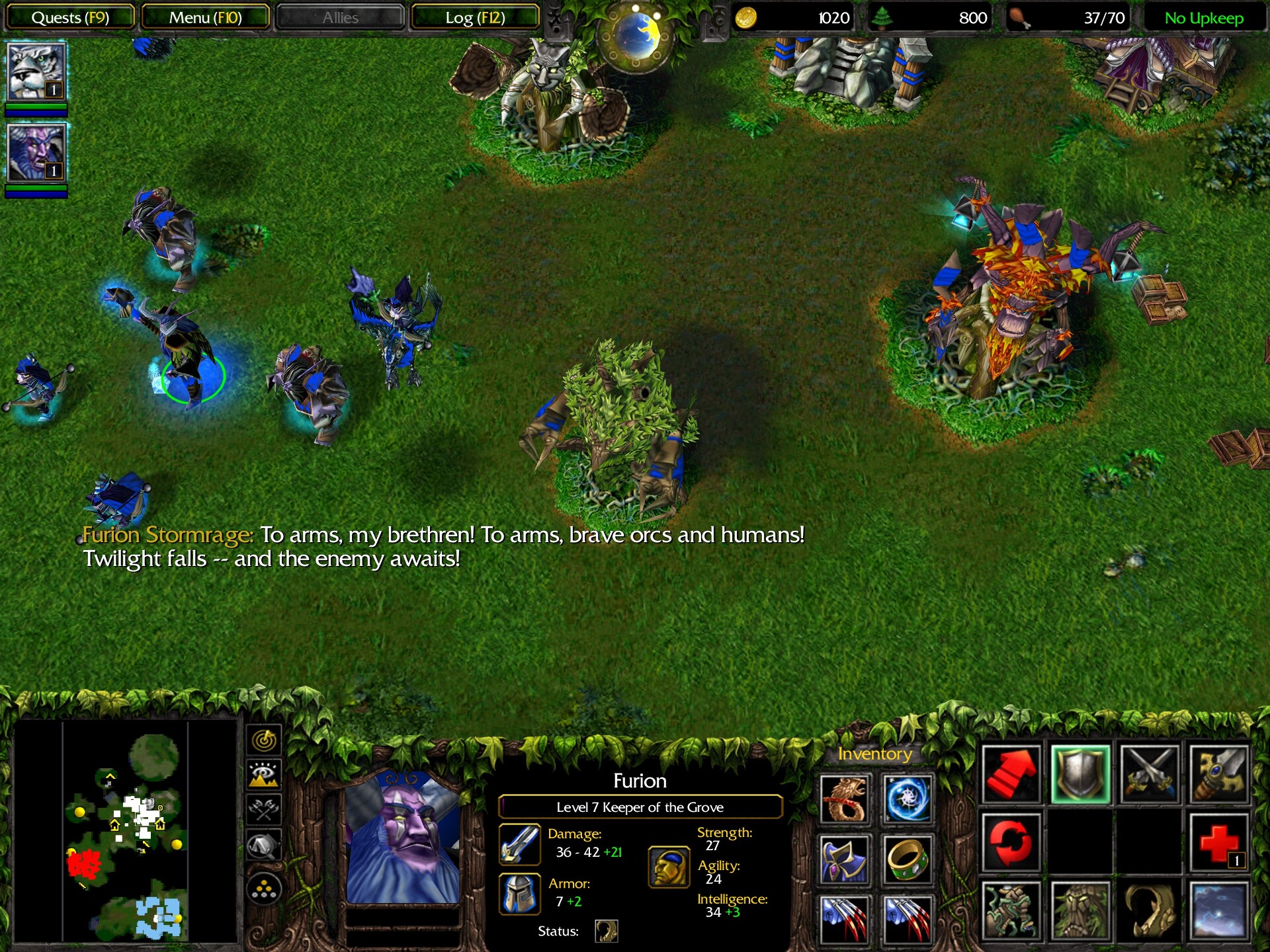
I have a confession to make. Ever since the game’s release, I never completed this mission without cheat codes until now because I was simply too afraid of its perceived mechanical complexity, until I did it for the sake of this post. It ended up not being as scary as I thought, at least on normal.
I won’t go too much into detail, since this is not a strategy guide or let’s play.14 Both of these can be found aplenty on the Internet. The game does expect you to claim the two unguarded gold mines as soon as you can, which ensures you have a steady supply of gold and can spend it on whatever you see fit. There is, however, one thing that will help, and that’s building moon wells and ancient protectors at allied bases.
Every faction has a “farm” building that provides supply, and each of them has a unique mechanic. Orc burrows let peons hide inside and throw spears at attackers, effectively acting as makeshift towers. Undead ziggurats are upgradable to spirit towers. Human farms… er… are cheap and take less space (though they provide less supply, too)? And night elf moon wells replenish the health and mana of nearby allied units through a supply of their own mana that regenerates at night.
Build them at allied bases. It will help your allies a lot: both the orcs, who have a lot of meaty tanky units and can bear the brunt of enemy attacks for you, and the humans, who build a lot of spellcasters.
I’ll just focus on the broad strokes of this mission that really does play like a satisfying epic conclusion to the story of Reign of Chaos.
In the top right, there is the World Tree. It’s Archimonde’s goal, and if he succeeds in reaching it, the world is doomed. Through Furion’s druidic know-how, it’s drawing wisps to itself, and our goal is to survive for 45 minutes until it draws enough of them, and the trap for Archimonde is set in place.
The World Tree is protected by three bases arranged at the turns of the S-shaped ascent from Archimonde’s undead base to the mountain summit. There’s Jaina’s human base, then Thrall’s orc base, then your own night elf base. You’re expected to help your allies hold out for as long as you can, against waves of enemies that start weak and grow increasingly stronger. Later waves throw in frost wyrms, infernals, and eventually level 10 heroes: a pit lord, a dreadlord, and a lich.

If, or more likely when, Jaina’s base is destroyed, Archimonde moves his operations to its former location, taunting her in a cutscene.
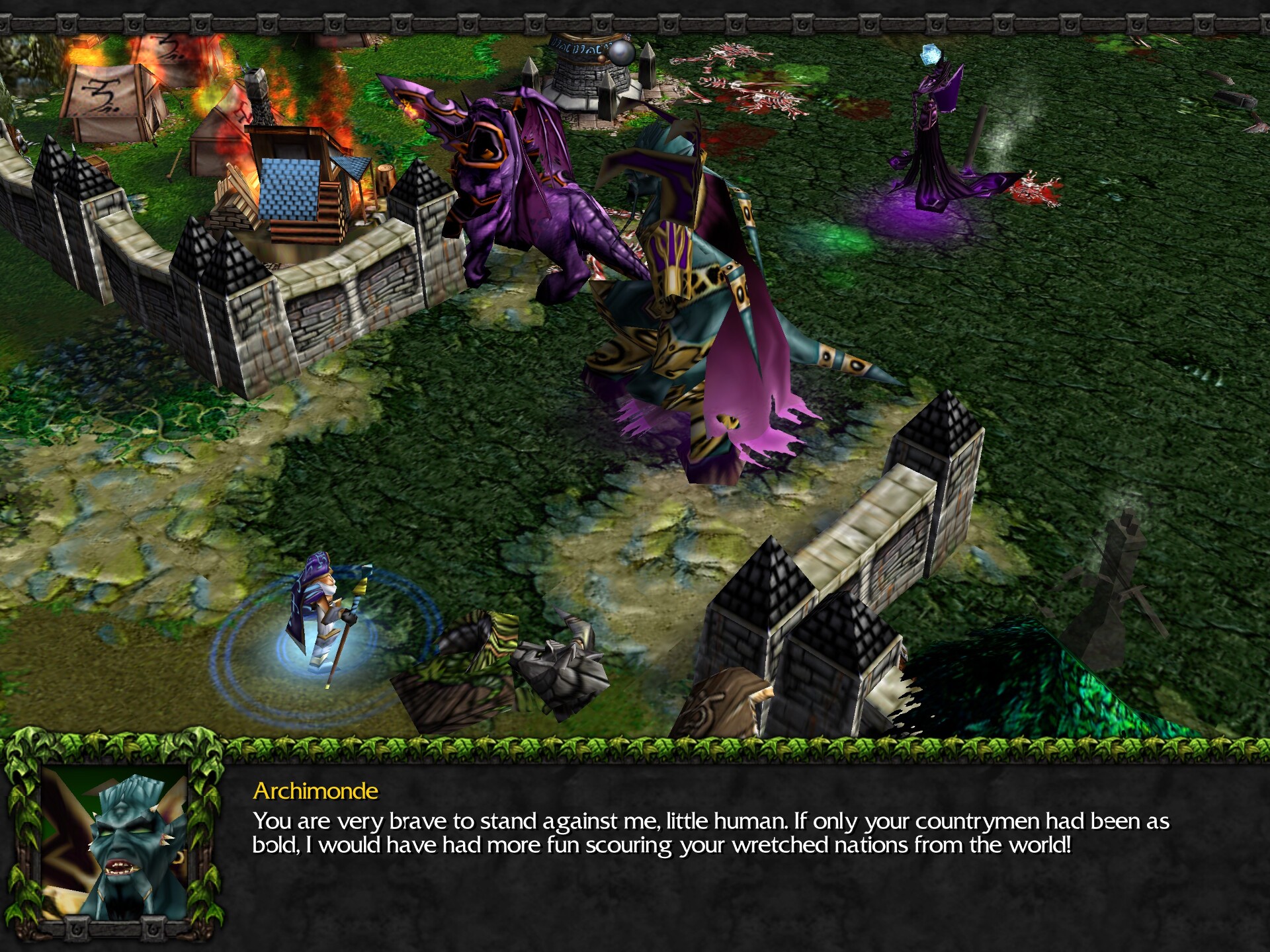
“Is talking all you demons do?” asks Jaina, then teleports away. The enemy waves then reset back to the weakest units (ghouls and crypt fiends), and we fall back to Thrall’s base and build up its defenses.
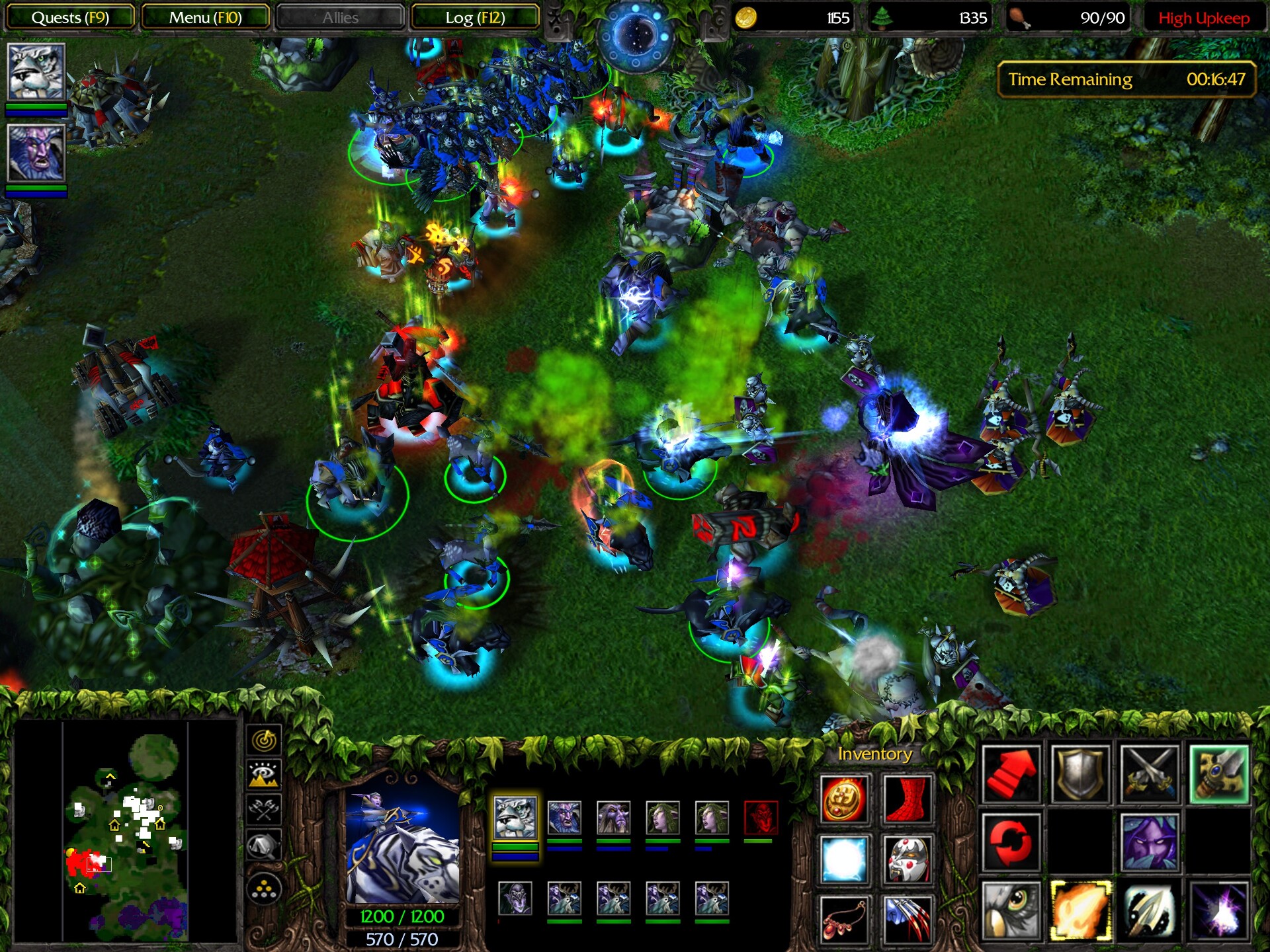
Oh right, I should talk about the new unit!
In this final mission, we unlock the hippogryph rider, the only (to my knowledge) combining unit in Warcraft 3. A hippogryph rider is just that: an archer, a regular old archer, mounted on a hippogryph. By themselves, hippogryphs can only attack air, which is almost useless in this mission (as the enemy builds very few air units, if any). However, you can combine a hippogryph and an archer into one unit, which adds their HP together and makes them efficient and versatile aerial cavalry.
Night elves have another air unit: the chimaera, a massive flying beast with a very powerful ground attack, but it’s not available in the Reign of Chaos campaign. Reforged does make them available in this mission, however.
It’s actually possible to hold Thrall’s base until the timer runs out (I did it in my playthrough), or maybe even Jaina’s if you’re a skilled player. If Thrall’s base does fall, another cutscene will play out, like with Jaina. Thrall will injure Archimonde, then teleport away.
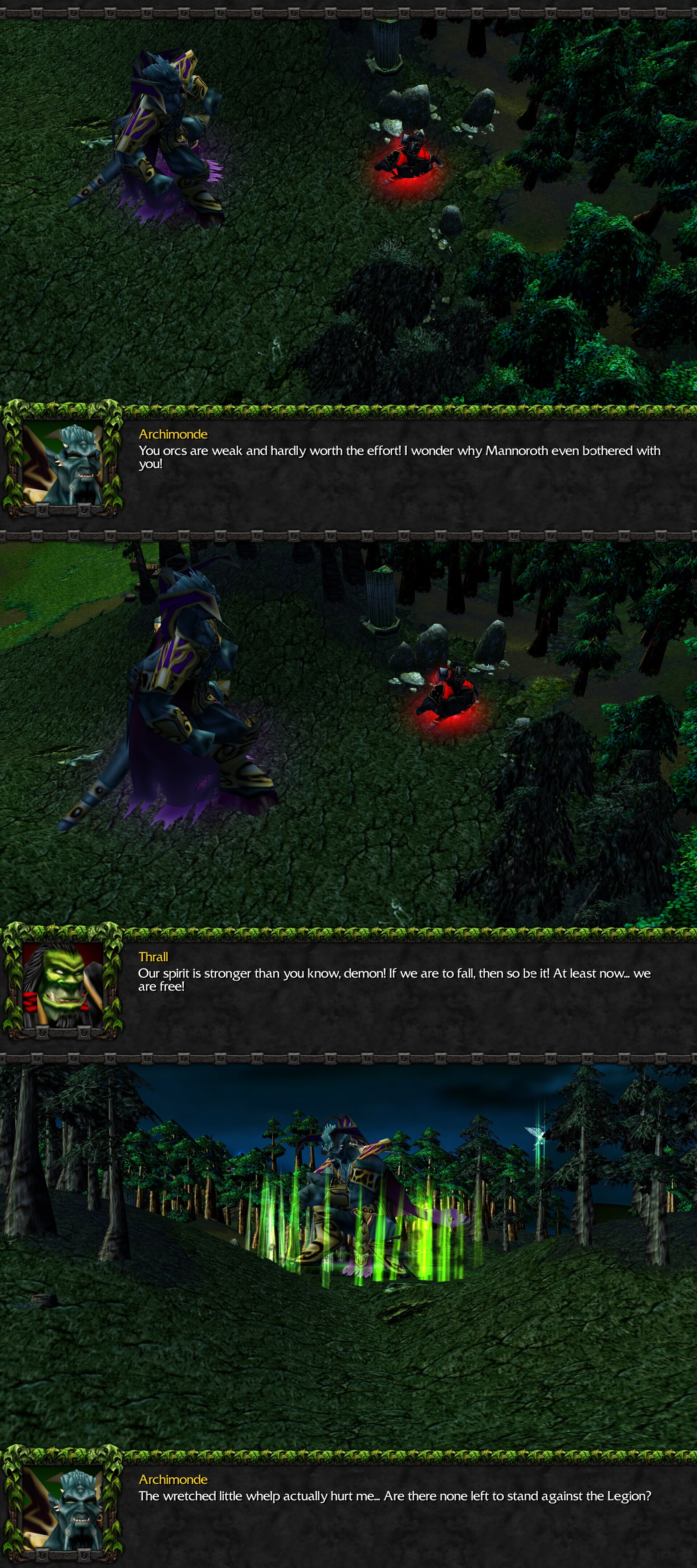
Again, the waves reset to the weakest ones. Defending our own base shouldn’t be too bad now if there’s not much time left, as they should start with ghouls and crypt fiends agai– OH GODDESS IT’S ARCHIMONDE HIMSELF AND HE’S HUGE
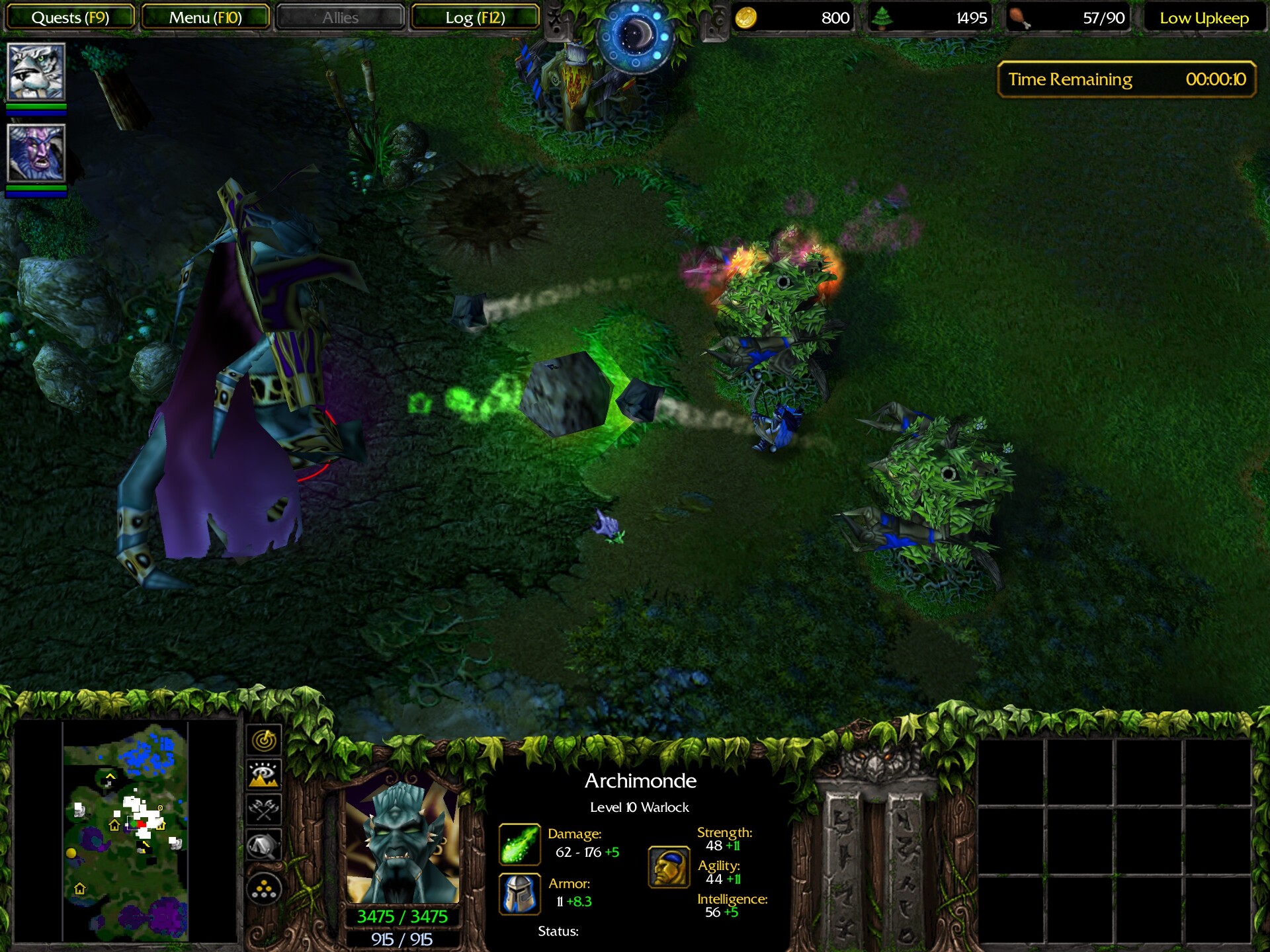
When there are thirty or so seconds left, Archimonde begins moving towards the World Tree himself from wherever he is, leaving a trail of blight behind and tearing through everything. As long as there are enough buildings left standing, there’s not enough time for him to reach his destination. The timer expires, and the quest is completed.
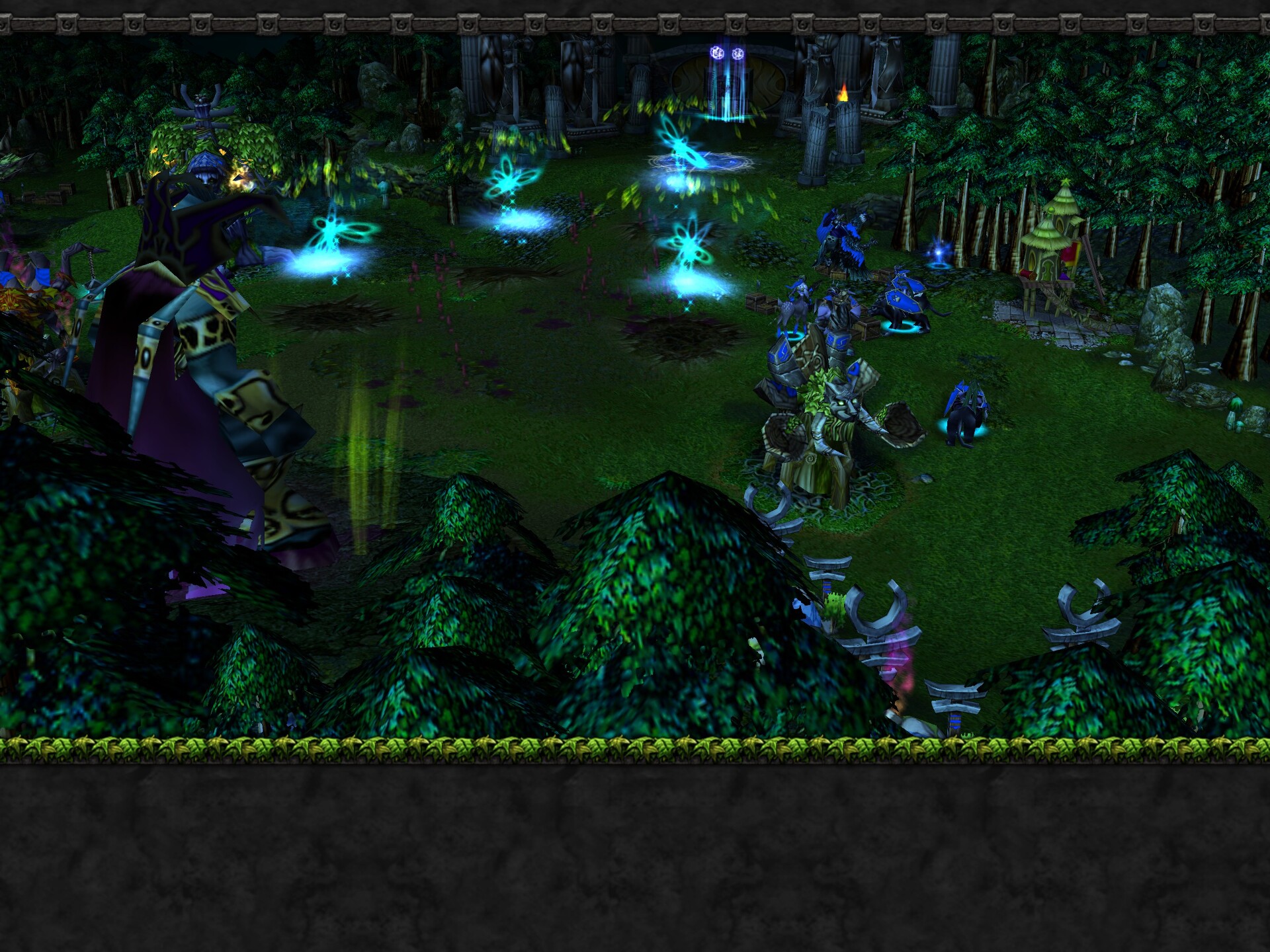
“Archimonde’s victory has made him overconfident,” remarks Furion. “He will not see the trap that I laid for him until it is too late.”
Tyrande joins him on his overlook.
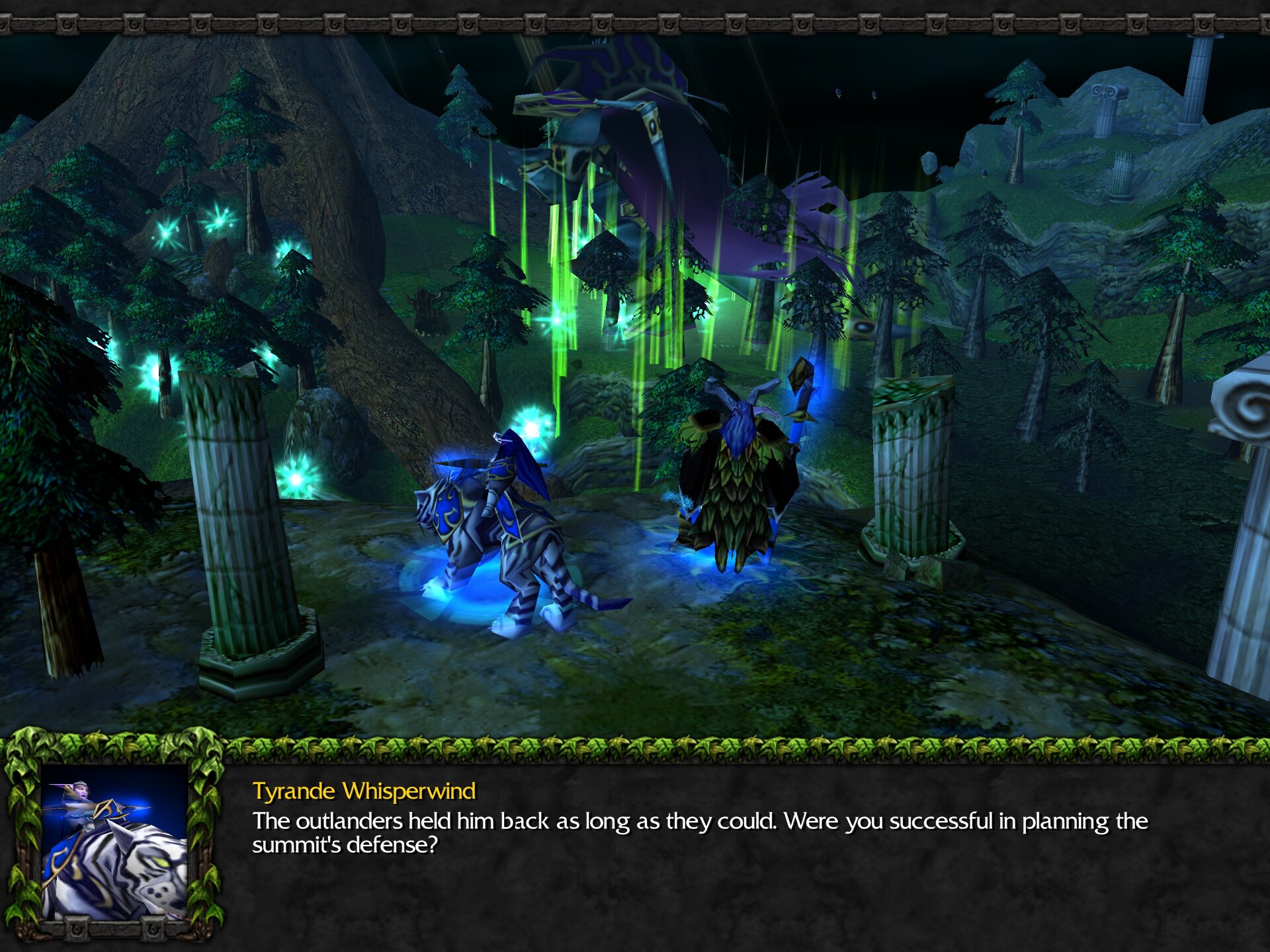
“Yes,” says Furion. “Now our victory is assured.”
And so, in his overconfidence, Archimonde walks straight into Furion’s trap.
Remember how, in the previous post, I mentioned that wisps can detonate themselves to damage summoned creatures?
While we were holding the line, Furion gathered a staggering number of wisps around the World Tree.
And Archimonde — while very, very powerful — is a summoned creature.
.
.
.
Hasta la vista, baby.
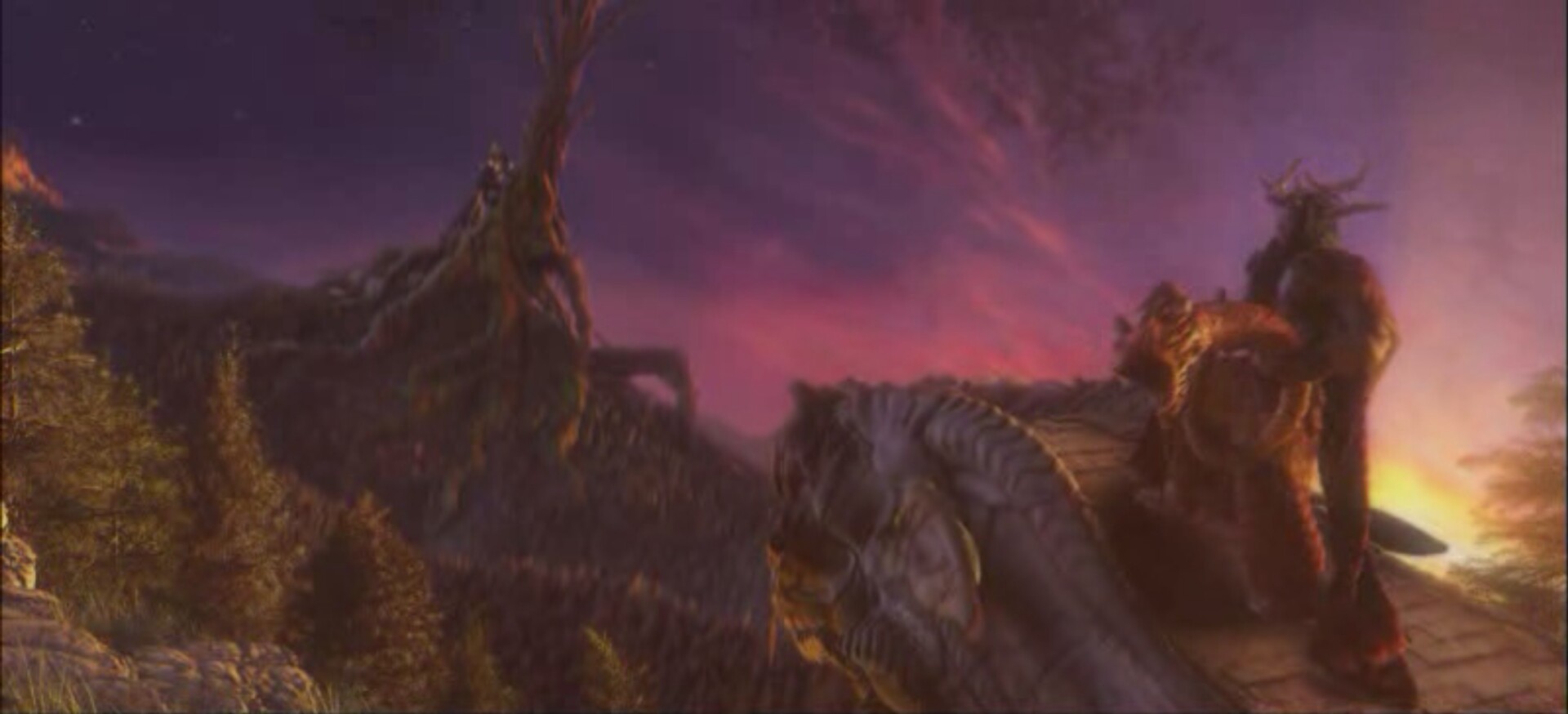

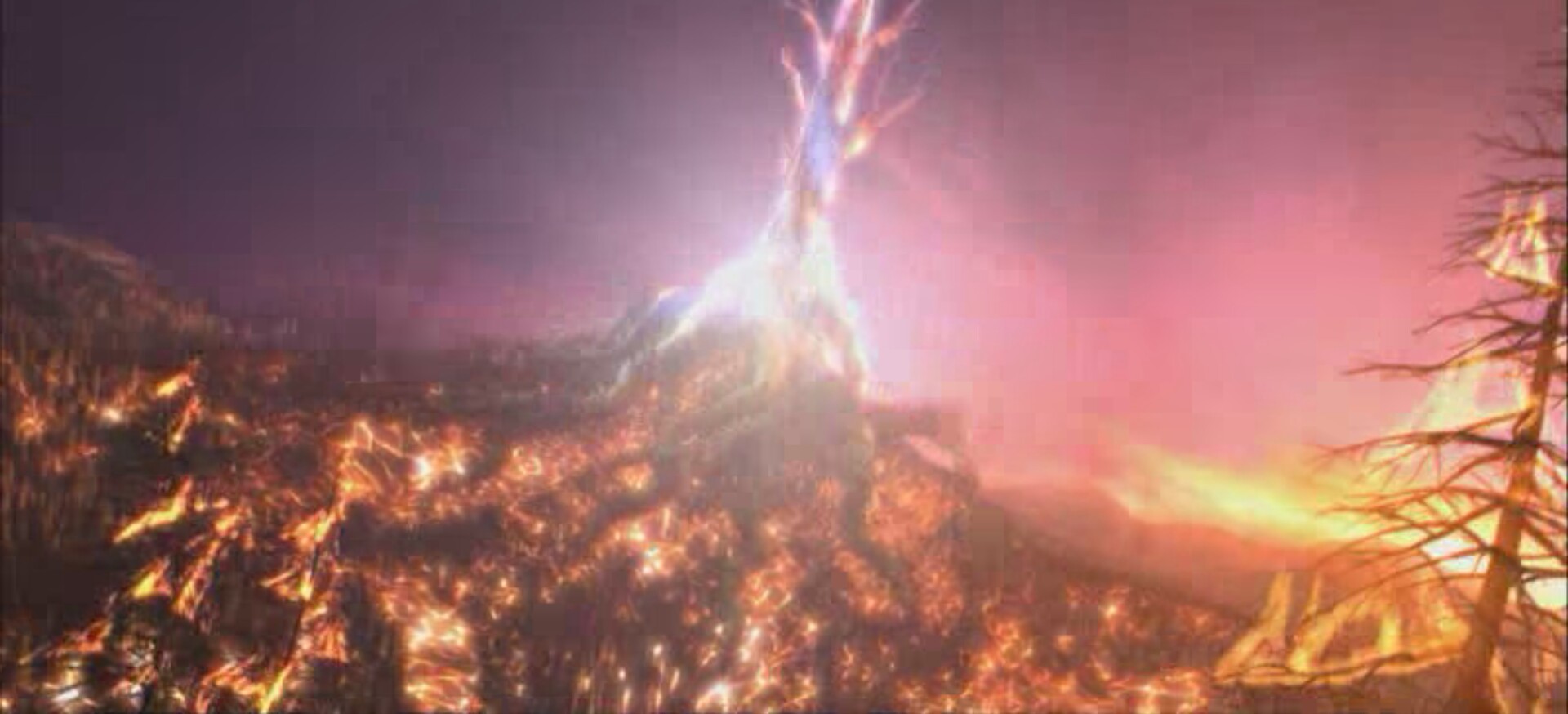
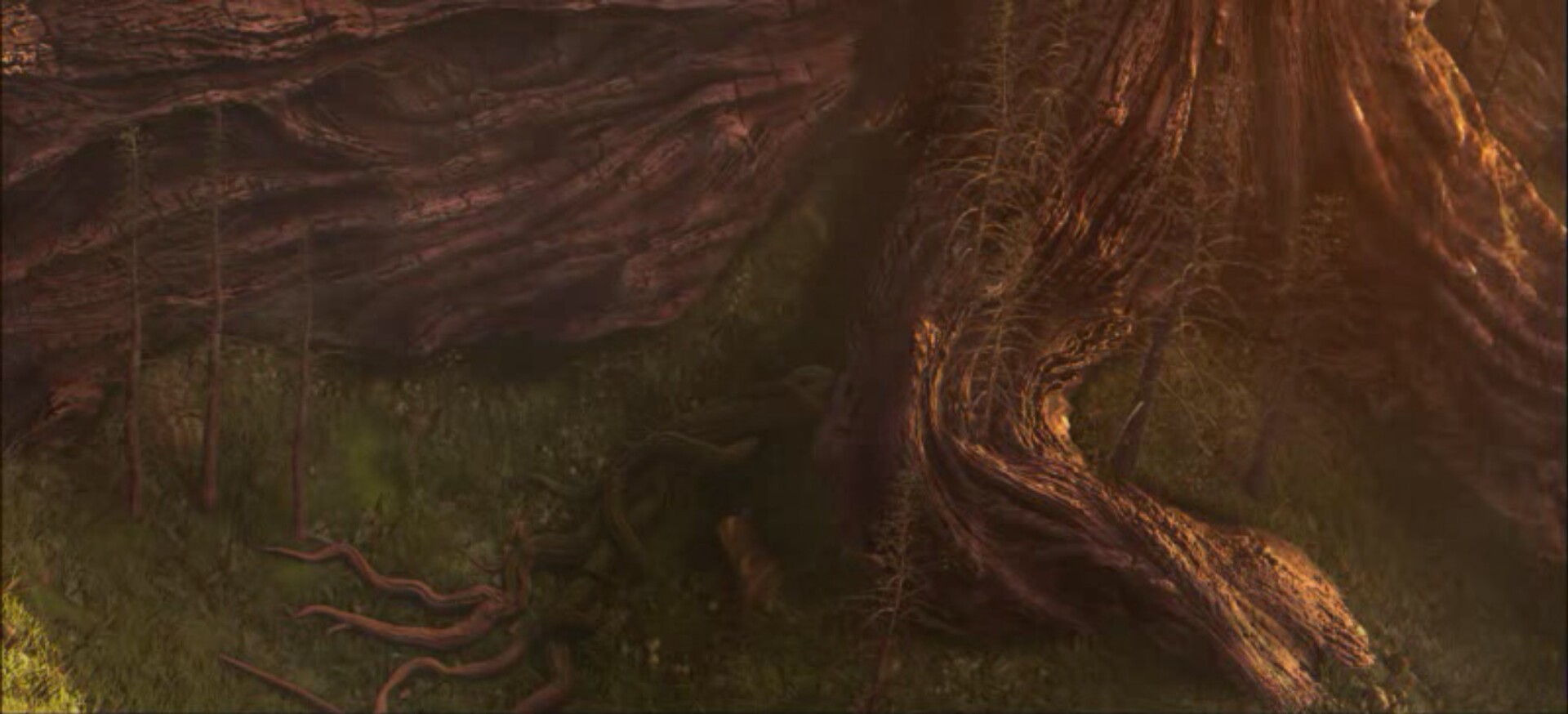
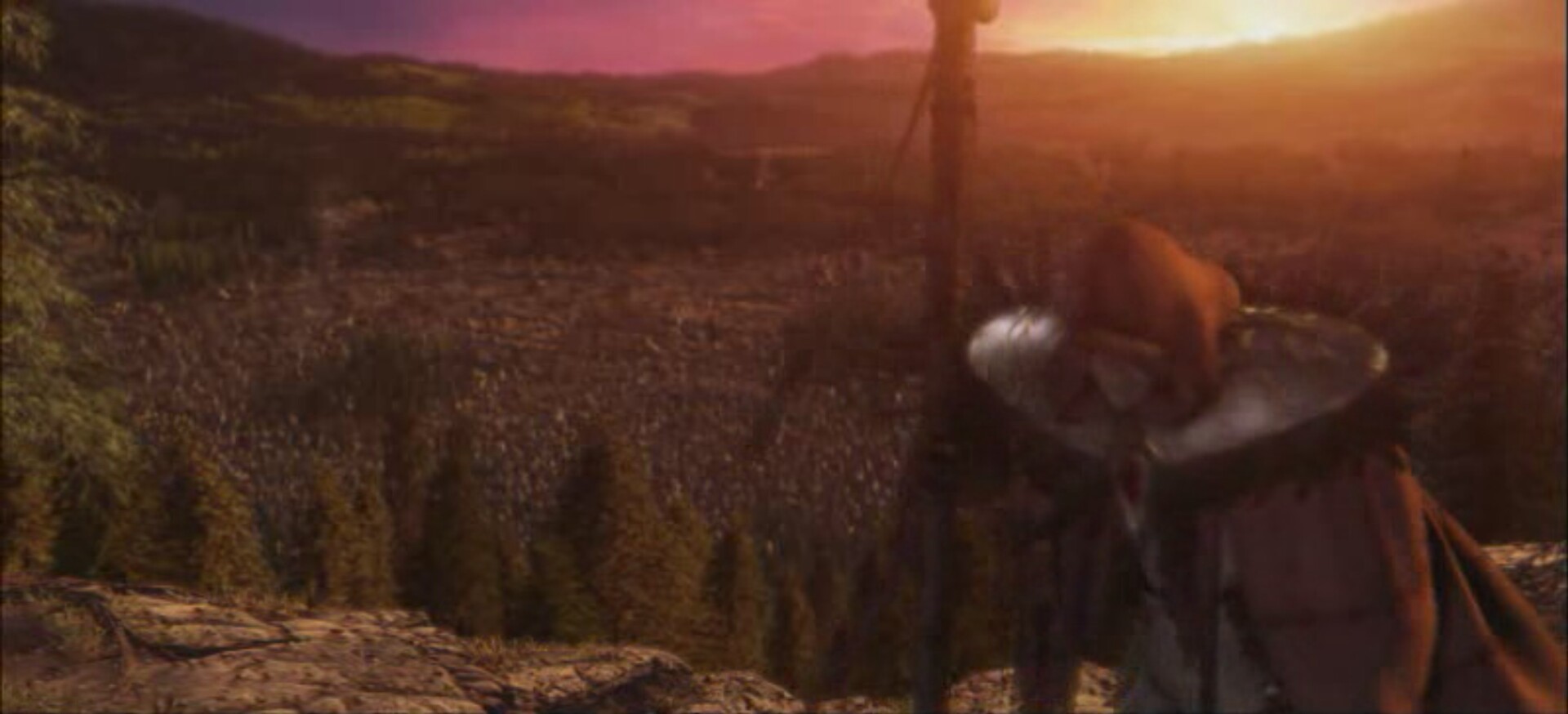
The roots will heal in time, as will the entire world. The sacrifices have been made. Just as the orcs, humans and night elves discarded their old hatreds and stood united against a common foe, so did nature herself rise up to banish the shadow forever.
As for me, I came back to ensure that there would be a future, to teach the world that it no longer needed Guardians. The hope for future generations has always resided in mortal hands. And now that my task is done, I will take my place amongst the legends of the past.
And so ends Warcraft 3: Reign of Chaos.
This is a lot to take in, so I’ll save my overall thoughts for later. Next up, we’re going to catch our breath. We’ll take a break from playing Warcraft 3 for a deeper dive into the strengths of its worldbuilding — and the high standard it set for the rest of the franchise, which successor games, sadly, often fail to meet.
Our sacred grove is being desecrated!
-
Which requires complicated workarounds to get around Reforged’s always-online DRM. Thanks a lot, Blizzard! ↩
-
Unlike necromancer skeletons, there’s numerical consistency here as well: you’ll never get more treants than there are trees around. If you point the spell at a cluster of one or two trees, you’ll get one or two treants, not all three or four. ↩
-
Technically, since the Warcraft 3 engine doesn’t allow cleansing blighted trees, the script destroys them and grows new ones in their place. ↩
-
They’re useful in your first playthrough, but not so much when you already know where everything is. ↩
-
And in the final mission, you get better flyers. ↩
-
Depending on which unit discovers the panda, they will say a line in the short cutscene. For example, Furion says “Our sins have returned to haunt us.” while a druid of the talon says “How about if I just stand over here?” Since I discovered the panda with treants, I got no lines. Ah well. ↩
-
Aren’t night elves supposed to have forsaken magic? This bridge sure doesn’t look like it runs on druidism or Elune’s divine powers. ↩
-
The details, at least. It will be remembered in broad strokes. There’s someone out there who will remember that Tyrande set Illidan free and massacred wardens just doing their job, and she’ll be pissed. ↩
-
An expansion is a secondary mini-base built primarily for the purpose of harvesting gold from a gold mine. ↩
-
Badum-tish! ↩
-
In-story, I mean. In gameplay, paladins can resurrect recently-fallen allies and heroes can respawn at altars, but it’s just a gameplay mechanic that’s never acknowledged in-story. Otherwise a lot of characters, including King Terenas and Uther, would still be alive. ↩
-
I wasn’t among those. I played Warcraft 1 long after Warcraft 3, and this cutscene was the first time I heard that name. ↩
-
Or will they? (Dun dun duuuun!) ↩
-
If you’re curious, I didn’t do anything particularly clever. I immediately claimed the two extra gold mines and started building wisps to send to allied bases, to provide them with moon wells and ancient protectors. My army for Jaina’s base was a little bit of everything, for Thrall’s I mostly built hippogryph riders and a few dryads while the orcs tanked. Tyrande’s Necklace of Spell Immunity made her invulnerable to enemy crowd control and magic attacks, and her Orb of Lightning, which I was not supposed to have, made her deal massive damage to summoned units, making her auto-attacks just delete infernals from existence. I used Starfall for the most dangerous waves, like banshees, and Tranquility on cooldown, and didn’t even make use of the land mines or mercenary units. I’m not any kind of pro player, and my reaction times are as slow as Windows Vista, and I still found the mission pretty comfortable on normal. ↩
Comments
Sam
Our sacred grove is being desecrated!
(Thanks for sharing your writing, I am enjoying this series very much.)
Leave a Comment